Your basket is currently empty!
Category: Affiliate Marketing

Lead Scoring Explained: How to Identify and Prioritize High-Quality Prospects
One of the hardest tasks in sales is figuring out who‘s really interested in your product versus who’s just a tire-kicker. While you’re talking to time wasters, your competition could be snapping up your best leads — that’s where lead scoring comes in.
One of the hardest tasks in sales is figuring out who‘s really interested in your product versus who’s just a tire-kicker. While you’re talking to time wasters, your competition could be snapping up your best leads — that’s where lead scoring comes in.
In this article, I’ll share lead scoring models for you to consider, which data to look at, how to calculate a lead score, and what to do with a lead score once you have one.
Table of Contents
- What is lead scoring?
- Lead Scoring Models
- How to Determine What Data to Look At
- Is one lead score enough?
- How to Calculate a Basic Lead Score
- Lead Scoring Best Practices
What is lead scoring?
Lead scoring is the process of assigning a score or value to each lead which reflects how likely they are to become a customer. This process allows companies to prioritize and focus their energy on leads who are most likely to convert.
You can score your leads based on multiple attributes, including the professional information they‘ve submitted to you and how they’ve engaged with your website and brand across the internet.
Learn more about the concept of lead scoring in the video below:
Lead scoring sounds easy, right? Depending on your business model and the leads in your database, it can quickly become complicated.
To make this process a little easier, I will walk you through the basics of creating a lead score, including what data you should look at, how to find the most important attributes, and the process for calculating a basic score.
Do you need a lead scoring model?
If you’re a small business or startup, you may not be sure if you really need a lead scoring system. While sales reps at smaller companies can sometimes “feel out” their leads based on intuition, that system will pretty quickly hit limits as you scale. Here are some signs that you have tipped the scales and need a lead scoring model:
- Your sales team has more leads than they can respond to in a timely fashion.
- Your sales team wastes its time on low-quality leads that don’t convert.
- Your sales reps don’t have a strategy for who to prioritize to in their pipeline.
- Your team’s closing rate is lower than you would like.
Why is lead scoring important?
You may be wondering if lead scoring is outdated or if it’s still a relevant sales method. The short answer is lead scoring is as important today as it has been for years.
I’ve seen firsthand that lead scoring leads to better ROI for your sales efforts and helps to close more sales through a personalized, targeted approach.
We’ve seen in our data that 53% of salespeople say selling got harder in the past year. Mark Osborne, B2B sales expert and founder of Modern Revenue Strategies, says that for many businesses, markets are tightening due to uncertainty and higher interest rates, which has resulted in less capital. These tighter markets and longer sales cycles make every lead more precious.
Without a lead scoring model in place, says Osborne, you could be losing business to the competition.
“Savvy competitors have learned to swarm on the best opportunities as soon as they identify them,” he says, “giving those prospects the highest level of personalized attention and service to win those crucial deals.”
Lead Scoring Models
There are multiple lead scoring models that use different attributes and metrics to score leads. Many lead scores are based on a point range of 0 to 100, but every model you create will support a particular attribute of your core customer.
Here are seven different lead scoring models based on the type of data you can collect from the people who engage with your business. Choose the one that best matches your marketing strategy and the data you have available.
1. Firmographic or Demographic Information
Are you only selling to people of a certain demographic, like parents of young children? Or a certain ideal customer profile (ICP), like CIOs? Asking demographic (B2C) or firmographic (B2B) questions in your lead acquisition forms can help you see how well they fit in with your target audience.
For instance, you can assign point values for people who fit in your target geography, job title, or industry. You can also ask intent questions, like “Why are you interested in getting in touch with us?” with a few multiple-choice options. This model is also called explicit lead scoring because it uses the information that a lead gives you explicitly.
On the firmographic side, try tracking external company data on company information such as new leadership, M&A activity, or new investments as this knowledge can be valuable in understanding the company’s current context and fit with your value proposition.
While you don’t want to waste your lead’s time making them answer a long form, you can use a data enrichment tool to automatically supplement the information a lead submits.
2. Behavioral/Engagement Data
If someone opts in to receive emails from your company by filling out an email popup, you still don’t know much about how interested that person is in buying from you.
Open and click-through rates, on the other hand, will give you a much better idea of their interest level. Examining behavioral data — like how many emails a lead opens and which ones — can indicate whether a prospect is engaged.
Similarly, a lead’s engagement with your brand on social networks can also give you an idea of how interested they are. In my experience, social media is tied to referrals for generating the highest-quality leads, so it’s not a channel to overlook. How many times did they click through on your company’s tweets and LinkedIn posts? How many times did they comment or share those posts?
These types of inferences are called implicit lead scoring. By identifying interactions and behaviors that signify interest, you can gauge levels of interest.
3. Lead Sources
Though it may seem simple, quantifying a lead according to its source is another way to score leads. Most sales teams already know which sources provide the best leads, or can run a simple historical analysis to find out.
Since referrals are one of the best lead sources for most brands, you could assign more points to leads from referrals so your sales reps can prioritize reaching out to them.
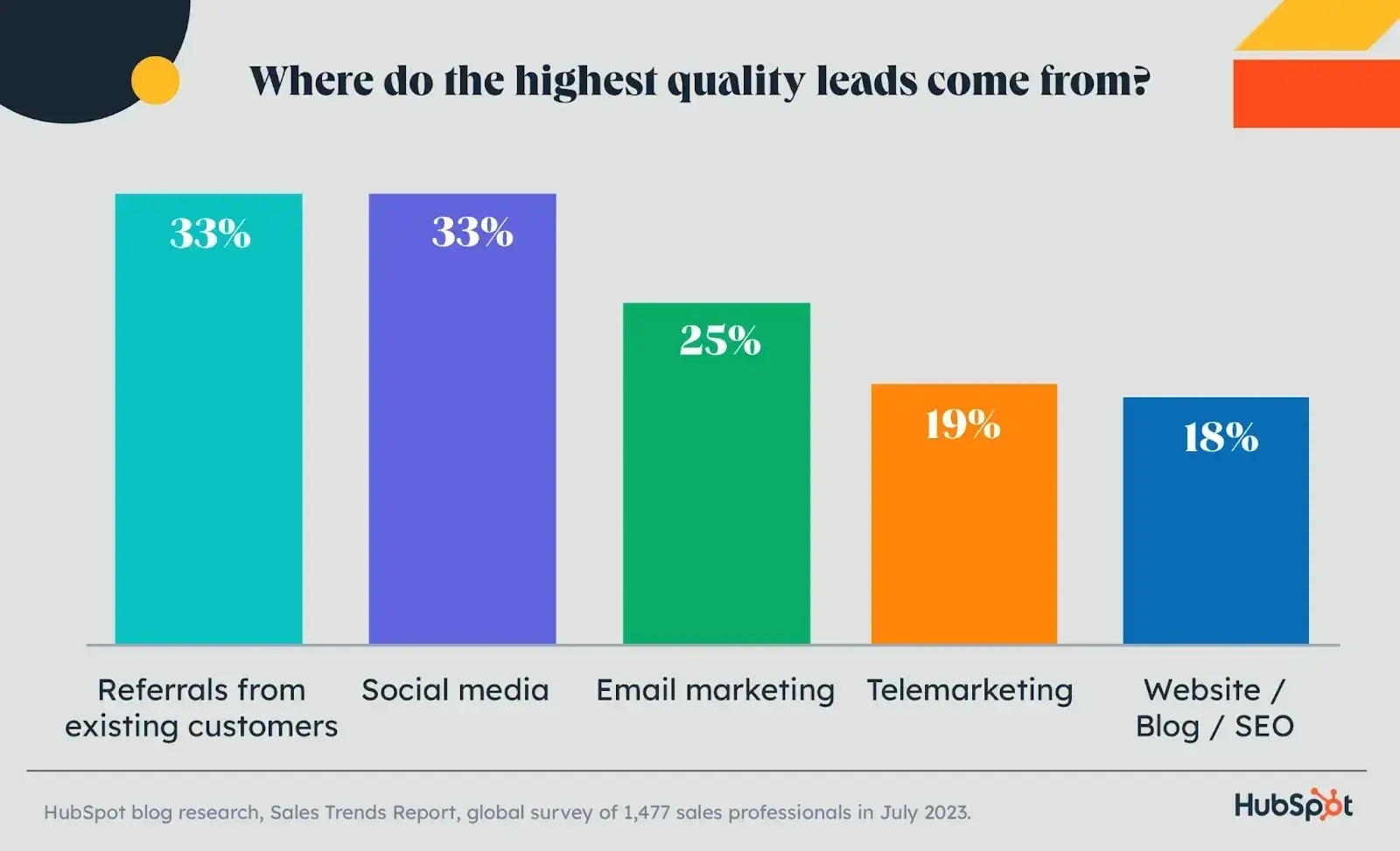
If you’re not already collaborating with your marketing team to get this data, start now, recommends Grant.
“Our sales and marketing team are in constant communication, ensuring that the criteria we use for scoring are aligned with real-world results,” he says. “This synergy helps refine our lead scoring models and improve accuracy.”
4. Purchase Intent Model
In my experience, how a lead interacts with your website tells you a lot about their interest and intentions. The purchase intent model uses intent data to gauge a lead’s likelihood of conversion by analyzing their web activity, behavior, and in some cases fit and demographics.
Take a look at your leads who eventually become customers: Which offers did they download? How many offers did they download? Which pages — and how many pages — did they visit on your site before becoming a customer? With a little bit of historical data, you can identify common behaviors to look for, like visiting the pricing page.
Both the number and types of type and pages are important. You might give higher lead scores to leads who visited certain pages (like pricing pages) or filled out high-value forms (like a demo request). Similarly, you might give higher scores to leads who had 30 page views on your site, as opposed to three.
Similarly, you can give negative points to someone who stopped visiting your website or opening your emails.
With HubSpot, for instance, you can build a custom lead-scoring model based on fit, engagement metrics, or a combination of both. You can also identify purchase signals with the analytics in the platform.
5. Predictive Intelligence
Predictive lead scoring takes the purchase intent model a step further by providing predictive intelligence. Instead of manually assigning scores by behavior or demographic, predictive lead scoring models use AI and machine learning to identify patterns and predict conversion likelihood. The scoring for predictive intelligence is dynamic and adjusts over time as new data becomes available.
While a purchase intent model shows you who’s ready to buy right now, predictive intelligence analyzes patterns to show who may be ready to buy in one, three, or six months.
6. Negative Scoring and Spam Detection
Last but not least, you should give negative scores to leads who filled out landing page forms in ways that could indicate they’re spam or not interested in buying.
For example, were first name, last name, and/or company name not capitalized? Did the lead complete any form fields by typing four or more letters in the traditional “QWERTY” keyboard, or a phone number like 999-999-9999?
You might also want to think about which types of email addresses leads are using compared with the email addresses of your customer base. If you’re selling to businesses, for example, you might take points away from leads who use a Gmail or Yahoo! email address.
How to Determine What Data to Look At
There’s a lot of data to weed through — how do you know which data matters most? Should you find out from your sales team? Should you interview your customers? Should you dive into your analytics and run a few reports?
I recommend a combination of all three. Your sales team, your customers, and your analytics reports will all help you piece together what content is most valuable for converting leads into customers, which will help you attach a number of points to certain offers, emails, and so on.
Coordinate across teams.
“The biggest lift in lead scoring is not defining how many points something is worth, it’s making sure everyone internally is aligned,” advises Ryan Durling, Inbound Consultant for HubSpot, in a webinar with HubSpot Admin HUG.
“It’s very important that before you embark on any sort of lead scoring approach that you have buy-in from everyone who‘s a stakeholder, who’s going to be involved. That’s not just the salespeople, it‘s not just the content team it’s not just the folks who are responsible for reporting or operations — it’s everyone.”
Sales reps are the ones on the ground, communicating directly with both leads who turned into customers and those who didn’t. They tend to have a good idea of which pieces of marketing material help encourage conversion.
Talk to your customers.
While your sales team might claim certain content converts customers, you might find that the people who actually went through the sales process have different opinions. That’s okay: You want to hear it from both sides.
In fact, according to our 2024 State of Sales Report, building and maintaining a strong rapport with customers is a key focus area for sales professionals.
Conduct a few customer interviews to learn what they think was responsible for their decision to buy from you. I suggest you interview customers who have had both short and long sales cycles so you get diverse perspectives.
Turn to the analytics.
I recommend that you also complement all this in-person research with hard data from your marketing analytics.
Run an attribution report to figure out which marketing efforts lead to conversions throughout the funnel. Don‘t only look at the content that converts leads to customers — what about the content people view before they become a lead?
You might award a certain number of points to people who download content that’s historically converted people into leads and a higher number of points to people who download content that’s historically converted leads into customers.
Another way to help you piece together valuable pieces of content on your site is to run a contacts report. A contacts report will show you how many contacts — and how much revenue — have been generated as a result of certain, specific marketing activities.
Marketing activities might include certain offer downloads, email campaign click-throughs, and so on. Take note of which activities tend to be first-touch conversions, last-touch conversions, and so on, and assign points accordingly.
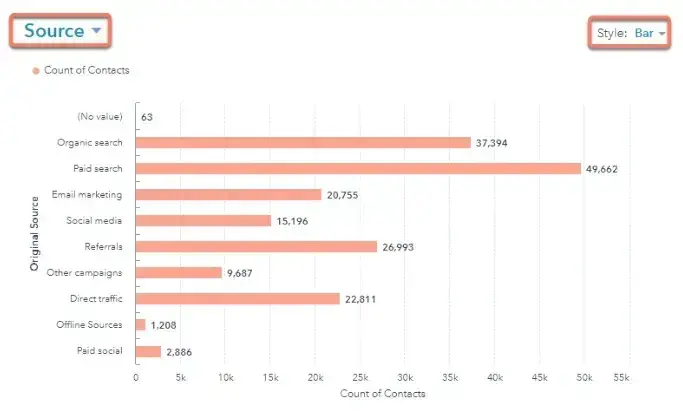
Is one lead score enough?
If you have one core customer right now, a single score suffices. But as your company scales, you’ll sell to new audiences. You might expand into new product lines, new regions, or new personas.
You might even focus more on up-selling and cross-selling to existing customers rather than pursuing new ones. In my experience, if your contacts aren‘t “one size fits all,” your scoring system shouldn’t be either.
With some marketing platforms, you can create multiple lead-scoring systems, giving you the flexibility to qualify different sets of contacts in different ways. Not sure how to set up more than one score? I’ve gathered a few examples to inspire you:
Fit vs. Interest
Let’s say, for instance, your sales team wants to evaluate customers on both fit (e.g., is a contact in the right region? The right industry? The right role?) and interest level (e.g., how engaged have they been with your online content?).
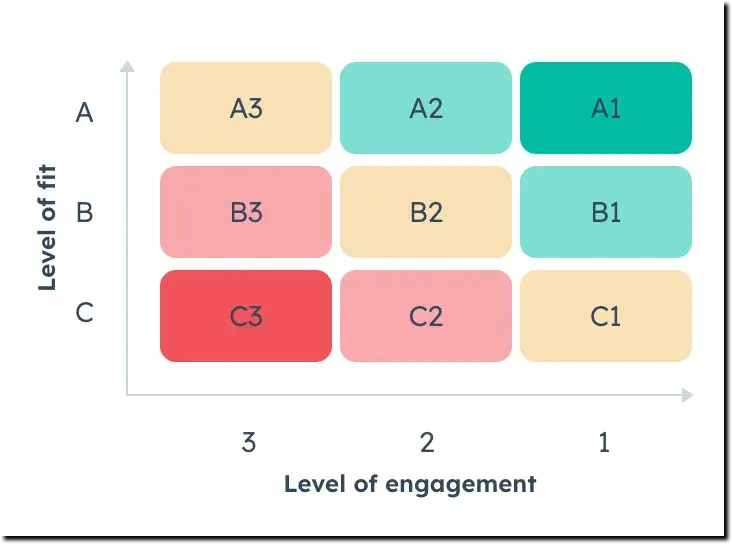
If both of these attributes are a priority, you can create both an engagement score and a fit score (as seen in the graphic above) so that you can prioritize outreach to contacts whose values are high in both categories.
Multiple Personas
Say you’re a software company that sells two different types of software via different sales teams to different types of buyers.
You could create two different lead scores — one for a buyer’s fit and the other for their interest in each tool. Then, you’d use these respective scores to route leads to the right sales teams.
New Business vs. Up-sell
As you grow, you might start to focus on upselling or cross-selling as much as new business. However, keep in mind that the signals that indicate the quality of new prospects and existing customers often look completely different.
For prospects, you might look at demographics and website engagement, whereas for existing customers, you might look at how many customer support tickets they’ve submitted, their engagement with an onboarding consultant, and how active they currently are with your products.
If these buying signals look different for different types of sales, consider creating multiple lead scores.
How to Calculate a Basic Lead Score
There are many different ways to calculate a lead score, but I think the simplest way to do it is this:
Featured Resource: Free Lead Scoring Template
Manual Lead Scoring
1. Calculate the lead-to-customer conversion rate of all of your leads.
Your lead-to-customer conversion rate is equal to the number of new customers you acquire, divided by the number of leads you generate. Use this conversion rate as your benchmark.
2. Pick and choose different attributes of customers who you believe were higher quality leads.
Customers who requested a free trial at some point, customers in the finance industry, or customers with 10-20 employees could be attributes.
There‘s a certain kind of art to choosing which attributes to include in your model. You’ll choose attributes based on those conversations you had with your sales team, your analytics, and so on — but overall, it’s a judgment call.
You could have five different people do the same exercise, and they could come up with five different models. But that’s okay as long as your scoring is based on the data we mentioned previously.
3. Calculate the individual close rates of each of those attributes.
Calculating the close rates of each type of action a person takes on your website — or the type of person taking that action — is important because it dictates the actions you’ll take in response.
So, figure out how many people become qualified leads (and ultimately customers) based on their actions or who they are in relation to your core customer. You’ll use these close rates to actually “score” them in the step below.
4. Compare the close rates of each attribute with your overall close rate and assign point values accordingly.
Look for the attributes with close rates that are significantly higher than your overall close rate. Then, choose which attributes you’ll assign points to, and if so, how many points.
Base the point values of each attribute on the magnitude of their individual close rates.
The actual point values will be a little arbitrary but try to be as consistent as possible.
For example, if your overall close rate is 1% and your “requested demo” close rate is 20%, then the close rate of the “requested demo” attribute is 20X your overall close rate — so you could, for example, award 20 points to leads with those attributes.
Logistic Regression Lead Scoring
The simple method above for calculating a lead score is a great start. However, the most mathematically sound methods employ a data mining technique, such as logistic regression.
Data mining techniques are more complex and often more intuitive than your actual close rates. Logistic regression involves building a formula in Excel that’ll spit out the probability that a lead will close into a customer.
This is more accurate than the technique I outlined above since it’s a holistic approach that takes into account how all of the customer attributes — like industry, company size, and whether or not someone requested a trial — interact with one another.
If you prefer a less complex lead-scoring method, I think the manual approach above is a great place to start.
Predictive Lead Scoring
Creating a lead score can do great things for your business: improve the lead-handoff process, increase lead conversion rate, improve rep productivity, and more.
But, as you can see from the two methods above, coming up with a scoring system can be a time-consuming task when done manually.
Plus, coming up with scoring criteria isn‘t “set it and forget it.” As you get feedback from your team and stress-test your scores, I’ve found you’ll need to tweak your lead-scoring system regularly to ensure it remains accurate.
Wouldn’t it be easier if technology could eliminate the manual setup and continuous tweaking, leaving your team more time to build relationships with your customers?
That’s where predictive scoring comes in. Predictive lead scoring uses machine learning to parse through thousands of data points in order to identify your best leads, so you don’t have to.
Predictive scoring looks at what information your customers have in common, as well as what information the leads that didn’t close have in common, and comes up with a formula that sorts your contacts by importance based on their potential to become customers.
This allows you and your sales team to prioritize leads so you’re not harassing those who aren’t (yet) interested and engaging those who are.
The best part about predictive scoring? As with any application of machine learning, your predictive score gets smarter over time, so your lead follow-up strategy will optimize itself.
Featured Resource: Predictive Lead Scoring Software
Lead Scoring Best Practices
We’ve covered a lot so far, so I want to wrap it up with a few best practices I learned from the sales leaders I spoke to.
Here are some lead scoring best practices to follow if you want to improve your sales in 2024.
Leverage AI and machine learning.
In the age of AI, sales professionals would be wise to use one of the numerous AI tools to their selling advantage, especially during the lead scoring process.
Not only can AI tools improve efficiency, but 66% of sales pros say that AI helps them provide a personalized experience and better understand their customers.
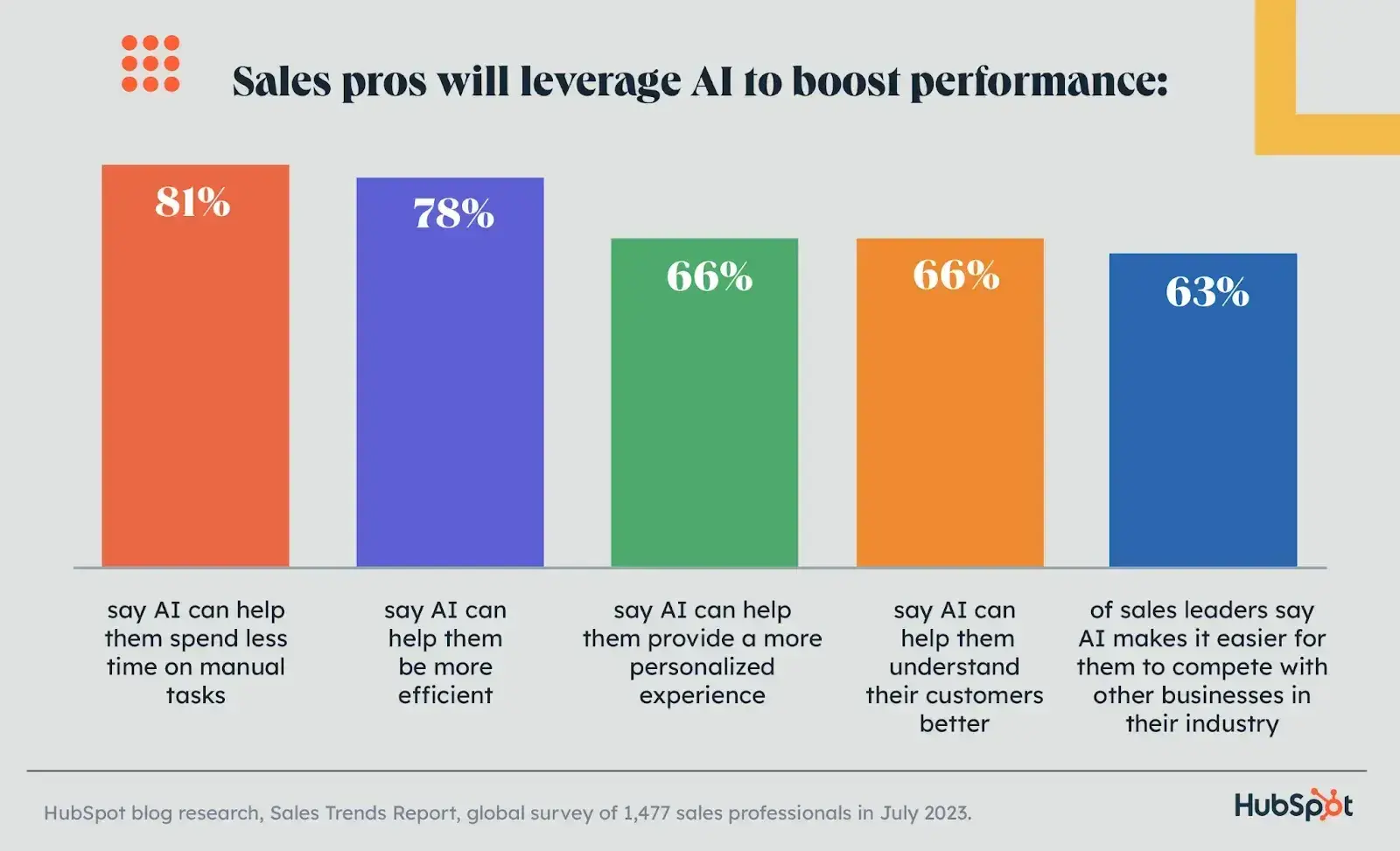
Grant is also taking advantage of AI’s power to personalize data.
“We’re leveraging AI to analyze patterns and predict which leads are most likely to convert,” he says. “Machine learning models can adapt and get more accurate over time, which is a huge step up from traditional lead scoring methods.”
Lead with data.
I think one of the best parts about lead scoring is that it’s an objective method. When the data indicates how interested a prospect is, that’s something you’ll want to lean into.
Data is one of the most important resources sales teams and marketers have at their disposal, and lead scoring has become even more data-driven with the tools available today.
If you want to save time spent on unqualified leads and prioritize sales-ready ones with data-driven decisions, then your sales team should use a lead scoring model that makes it easy to organize and understand your data.
Make real-time adjustments.
If you think lead scoring models are outdated, it could be because the traditional methods didn’t take into account real-time industry or business changes.
“Lead scoring is no longer a set-it-and-forget-it deal,” says Grant. “We’re making real-time adjustments based on the latest data. This agility helps us stay ahead of the curve and respond to changing market conditions.”
There are so many lead generation tools available to help your sales team make real-time decisions and properly qualify inbound leads.
Create workflows and automations based on scores.
A lead score is just a number— it’s what you do with that number next that counts.
“Lead scores on their own are not actionable. A successful approach to lead scoring will involve automation to make sure that contacts are getting routed to the right people, that they’re getting nurtured with the right content, and they’re getting served the most custom experience that you can possibly serve them,” says Durling.
“If you don‘t have a strong assignment rule or a strong series of assignment rules for contacts coming into your database, lead scoring isn’t likely going to be very valuable for you because you’re just going to put contact every contact into the same funnel and nurture flow,” he warns.
The next step for a lead who’s high engagement/low fit may be different than for a lead that’s low engagement/high fit. In addition, a vast majority of leads will need to be nurtured before they’re ready to be handed off to sales.
Here are different actions you can automate in your score based on a lead score:
- Start a nurture campaign appropriate to the demographics and behavior.
- Route leads to different reps when the lead score surpasses your MQL (Marketing Qualified Lead) criteria.
- Recommend personalized content based on industry or behavior (eg. a case study from their industry or related content from a previous download).
Above all, I believe that lead scoring allows you to create a more personalized, timely, and relevant experience that makes it more likely for them to buy.
“The scoring model and the buyer personas work together to create the most personalized experience for your prospects. When you create a more personalized experience, you create trust a lot more quickly,” says Durling.
Improve Your Sales With Lead Scoring
Scoring your leads can go a long way in determining which leads are good fits and interested in your offering and which might need more nurturing before being sales-ready. Whether you use a manual calculation method
Check out our lead scoring templates to get started defining your criteria and assigning points!
Editor’s note: This post was originally published in August 2015 and has been updated for comprehensiveness.


What Is a Competitive Analysis — and How Do You Conduct One?
Competitive analysis is a critical component of any business strategy — whether you’re a small business owner or competing with global brands.
Competitive analysis is a critical component of any business strategy — whether you’re a small business owner or competing with global brands.
A competitive analysis report is the key to understanding your brand’s position in the market. Its purpose is to map competitors’ strengths and weaknesses, identify your own, and discover growth opportunities for your business.
In this article, I’ll take you through each step of a thorough competitive analysis (also known as “competitor analysis” or “competitor research”), sharing tips from marketing experts along the way.
Whether you choose to go through each step or just sample from a few sections is up to you. The point is to gather enough information to understand the competition so you can lead the pack rather than just trying to stay ahead of the curve.
Table of Contents
- What is competitive analysis?
- Why do a competitor analysis?
- What is competitive market research?
- How to Conduct Competitive Analysis in 5 Quick Steps
- How to Do a Competitive Analysis (the Extended Cut)
- Competitive Analysis Templates
- Competitive Analysis Example
- Competitive Product Analysis
- Competitive Analysis: FAQs
Competitive analysis gives you a clearer picture of the market landscape to make informed decisions for your growth.
That said, you have to remember that competitive analysis is an opportunity to learn from others. It isn’t:
- Copying successful competitors to a T.
- Trying to undercut others’ pricing.
- A one-and-done exercise.
Let’s look at how competitor research can help your business before breaking down my 5-step competitive analysis framework.
Why do a competitor analysis?
If you’re unsure about investing time and effort in analyzing your competitors, know that it will give you a complete picture of the market and your position in it.
Here are six main reasons I perform a competitive analysis exercise whenever working with a brand for the first time.
1. Find competitors’ strengths and weaknesses.
What are your competitors doing right when it comes to driving their growth? Analyzing the ins and outs of an industry leader will tell you what they did to reach the top position in the market.
By looking at competitor strengths and weaknesses, you will identify your own strengths and weaknesses in comparison, and thus see opportunities to improve.
I personally love analyzing competitor strengths. It’s easy to become short-sighted when looking only at your own website, marketing, and business. Analyzing competitors will open your eyes to current industry trends, what works well, and what would benefit your business.
Competitor weaknesses are of equal importance, particularly if you’d love to be in the position your competitors are in. Analyze areas in which they fall short and devise a plan to avoid making the same mistakes.
Pro tip: Look at company and product reviews to find the weaknesses that most bother your audiences. Commonalities can be used in marketing messaging to persuade people to try your business instead of another. Or, you can go into product development knowing exactly what problem to solve.
2. Identify opportunities.
Conducting a competitor analysis can be hugely beneficial because it’s an affordable way to identify opportunities to improve your business.
One strategy is to build a picture of the messaging that works for a competitor by analyzing what they say about their products or unique selling points (USPs). This information might inspire your own marketing.
Rachel Andrea Go is a marketing director who uses competitor analysis to learn what messages resonate with her audiences. She recommends, “Instead of saying, ‘Best project management software,’ one of your competitors might say, ‘Get time back by letting our software manage your projects.’
“By framing their software as ‘time-saving,’ your competition positions their software not only as a solution for project managers but also as a way to save time.
“Look at the language they employ on their websites, landing pages, and social media posts to communicate their USPs and pay attention to how their followers react.”
Pro tip: Don’t get too hung up on closing the gap on competitors. It’s easy to get carried away with competitor analysis and lose sight of what really matters to drive your business, but keep your business front of mind at all times. Do the analysis, but think carefully about which opportunities are a) right for your business and b) likely to move the needle.
3. Identify your differentiators.
Think of competitor analysis as a chance to reflect on your own business and discover what sets you apart from the crowd.
There’s no doubt that there will be some key differentiators between your business and your competitors that you’ll be glad to see.
But if you keep an open mind while conducting your analysis, there’s a good chance you’ll find differentiators in messaging, word choices, and USPs that will make you think about your own business differently.
Pro tip: Be strategic about competitor analysis. It’s common for brands to focus on the most aspirational competitors, but you need to consider your market position honestly. Don’t be afraid to dream big, but balance analysis of the biggest players with some that are closer to where your business is currently located.
4. Get closer to your target audience.
A good competitor analysis framework zooms in on your audience. It takes the pulse of your customers by evaluating what they like, dislike, prefer, and complain about when reviewing competing brands.
You can discover how your audience talks about competitors, what they love, and what they loathe. Emulate the things they love if it makes sense to do so, and avoid what they loathe — or use it to your advantage.
Pro tip: Social media, forums, and review sites are excellent sources of qualitative data where you can learn your audience’s feelings and perceptions in their own words. Or, go further and use surveys to get a sense of their activities, interests, and opinions (AIO).
5. Discover new competitors.
This one might sound backward. Don’t you need to know your competitors before you can start competitive analysis? Well, yes … and no.
As mentioned above, I’ve seen many brands fall into the trap of analyzing aspirational competitors and miss out on other brands that are attracting their audiences.
David Hunter, a digital marketing professional and the founder of Local Falcon — a local SEO rank-tracking tool powered by advanced AI — says, “One of the best ways to identify competitors is by looking at who ranks for the same keywords your business is targeting.”
“I always start by running a simple Google search using industry-related terms and tracking which businesses consistently show up,” he tells me. “If a company is frequently outranking you on search or maps, they’re a competitor, even if they’re not offering an identical product.”
When it comes to digital competitor research, SEO, and content, another way to look at it is “business competitors” and “content competitors.”
Think of your business competitors as those who do the same kind of work you do — the ones you might lose business to. Content competitors, however, may be serving your audience online, bringing them into communities, or providing alternative solutions that could leave you forgotten.
Pro tip: In a digital world, it’s almost impossible to know who all of your competitors are. It’s important to keep an eye on those that are local and those that are not, and to categorize the types of competition.
6. Set benchmarks for success.
A competitor analysis gives you a realistic idea of mapping your progress with success metrics. While every business has its own path to success, you can always look at a competitor’s trajectory to assess whether you’re on the right track for growth.
Pro tip: If you can check in regularly, say every 3, 6, or 12 months, you can note which KPIs to monitor. I tend to do competitor analysis every year or so for my clients. You can compare reports to previous years to track the trajectory.
The bottom line: Whether you’re starting a new business or revamping an existing one, a competitive analysis eliminates guesswork and gives you concrete information to build your business strategy.
Thorough market research doesn’t just highlight these differences, it also leverages them. This lays a solid foundation for a sales and marketing strategy that differentiates your business in a bustling market.
In the next section, I’ll walk you through the nuts and bolts of conducting a detailed competitive analysis that’s tailored to your brand. But first, let’s talk about the essentials.
Essential Aspects to Cover in Competitive Analysis Research
Before I go through the step-by-step process for conducting competitor research, I want to highlight the main aspects to include for every competitor in your analysis:
- Overview. A summary of the company — location, target market, and target audience.
- Primary offering. A breakdown of what they sell and how it compares to your brand.
- Pricing strategy. A comparison of your pricing against their pricing for various products.
- Positioning. An analysis of their core messaging to see how they position themselves.
- Customer feedback. A curation of what customers have to say about the brand.
How to Conduct Competitive Analysis in 5 Quick Steps
Below, I’m covering how to do a competitive analysis in five steps (the quick version) and then I’ll go in-depth with an “extended cut,” which is packed with a lot more tips. Whichever you choose, remember that the point is to:
- Identify gaps in the market.
- Develop new products and services.
- Uncover market trends.
- Market and sell more effectively.
And remember, whether or not you’ve got a marketing team behind your brand, the good news is that competitor analysis is getting even easier and less time-consuming. According to HubSpot’s 2024 State of Marketing report, 33% of marketers say AI is helping with research, ranking it #1, above context creation (31%) and data analysis and reporting (30%).
1. Identify and categorize all competitors.
The first step is a simple yet strategic one. You have to identify all possible competitors in your industry, even the lesser-known ones. The goal here is to be aware of all the players in the market instead of arbitrarily choosing to ignore some.
As you find more competitors, categorize them into these buckets:
- Direct competitors. These brands offer the same product/service as you to the same target audience. People will often compare you to these brands when making a buying decision. For example, Arcade and Storylane are direct competitors in the demo automation category.
- Indirect competitors. These businesses solve the same problem but with different solutions. They present opportunities for you to expand your offering. For example, Scribe and Whatfix solve the problem of documentation + internal training, but in different ways.
- Legacy competitors. These are established companies operating in your industry for several years. They have a solid reputation in the market and are a trusted name among customers. For example, Ahrefs is a legacy competitor in the SEO industry.
- Emerging competitors. These are new players in the market with an innovative business model and unique value propositions that pose a threat to existing brands. For example, ChatGPT came in as a disruptor in the conversational AI space and outperformed several brands.
For example, here’s a competitive matrix classifying brands in the community and housing space:
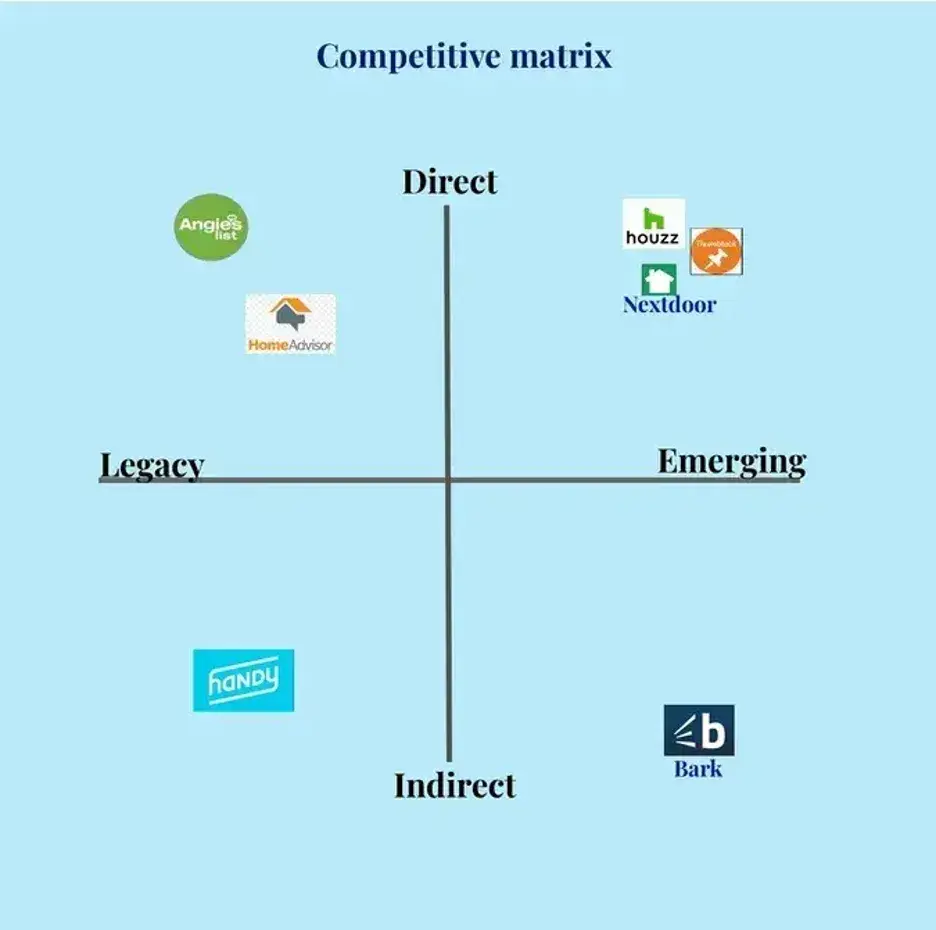
Testing It Out
To help you understand each step clearly, I’ll use Trello as an example brand and create a competitor analysis report using these steps.
Here’s a table of the main competitors for Trello:
Type of competitors
Competitor names
Direct competitors
Asana, Basecamp, Monday.com, MeisterTask
Indirect competitors
Slack, Notion, Coda
Legacy competitors
Microsoft Project, Jira
Disruptor competitors
ClickUp, Airtable
2. Determine each competitor’s market position.
Once you know all your competitors, start analyzing their position in the market.
This step will help you understand where you currently stand in terms of market share and customer satisfaction. It’ll also reveal the big guns in your industry — the leading competitors to prioritize in your analysis report.
Plus, visualizing the market landscape will tell you what’s currently missing. You can find gaps and opportunities for your brand to thrive even in a saturated market.
To map competitors’ market positions, create a graph with two factors: market presence (Y-axis) and customer satisfaction (X-axis). Then, place competitors in each of these quadrants:
- Niche. These are brands with a low market share but rank high on customer satisfaction. They’re likely targeting a specific segment of the audience and doing it well.
- Contenders. These brands rank low on customer satisfaction but have a good market presence. They might be new entrants with a strong sales and marketing strategy.
- Leaders. These brands own a big market share and have highly satisfied customers. They’re the dominant players with a solid reputation among your audience.
- High performers. These are another category of new entrants scoring high on customer satisfaction but with a low market share. They’re a good alternative for people not looking to buy from big brands.
This visualization will tell you exactly how crowded the market is. But it’ll also highlight ways to gain momentum and compete with existing brands.
Testing It Out
Here’s a market landscape grid by G2 documenting all of Trello’s competitors in the project management space. For a leading brand like Trello, the goal would be to look at top brands in two quadrants: “Leaders” and “High Performers.”
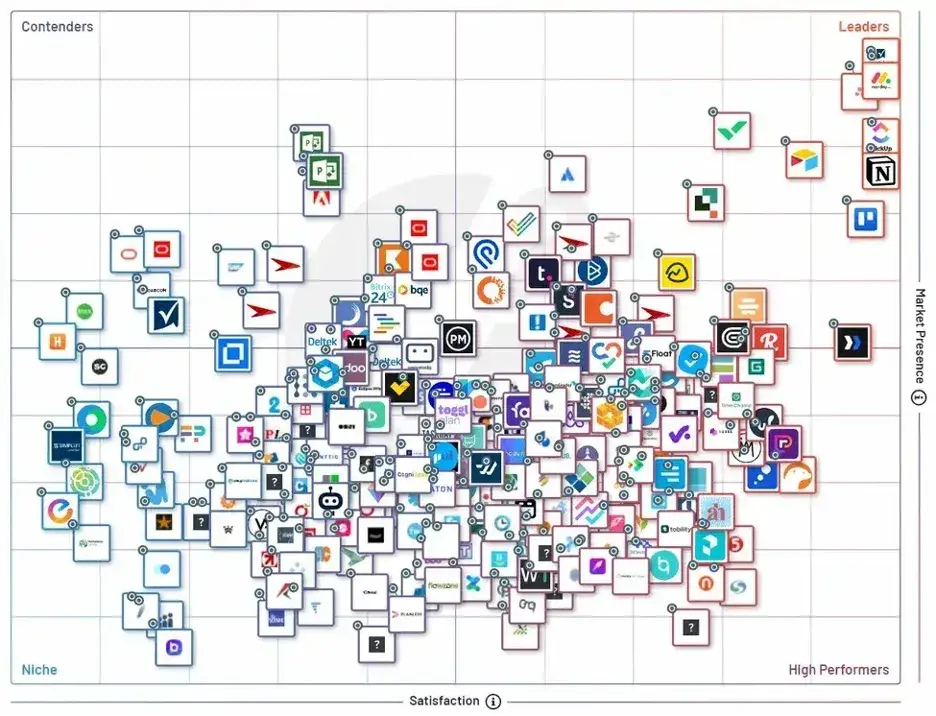
3. Extensively benchmark key competitors.
Step 2 will narrow down your focus from dozens of competitors to the few most important ones to target. Now, it’s time to examine each competitor thoroughly and prepare a benchmarking report.
Remember that this exercise isn’t meant to find shortcomings in every competitor. You have to objectively determine both the good and bad aspects of each brand.
Here are the core factors to consider when benchmarking competitors:
- Quality. Assess the quality of products/services for each competitor. You can compare product features to see what’s giving them an edge over you. You can also evaluate customer reviews to understand what users have to say about the quality of their offering.
- Price. Document the price points for every competitor to understand their pricing tactics. You can also interview their customers to find the value for money from users’ perspectives.
- Customer service. Check how they deliver support — through chat, phone, email, knowledge base, and more. You can also find customer ratings on different third-party platforms.
- Brand reputation. You should also compare each competitor’s reputation in the market to understand how people perceive the brand. Look out for anything critical people say about specific competitors.
- Financial health. If possible, look for performance indicators to assess a brand’s financial progress, using data on metrics like revenue growth and profit margins.
This benchmarking exercise will involve a combination of primary and secondary research. Invest enough time in this step to ensure that your competitive analysis is airtight.
Here’s an example of a competitor benchmarking report for workforce intelligence tools:
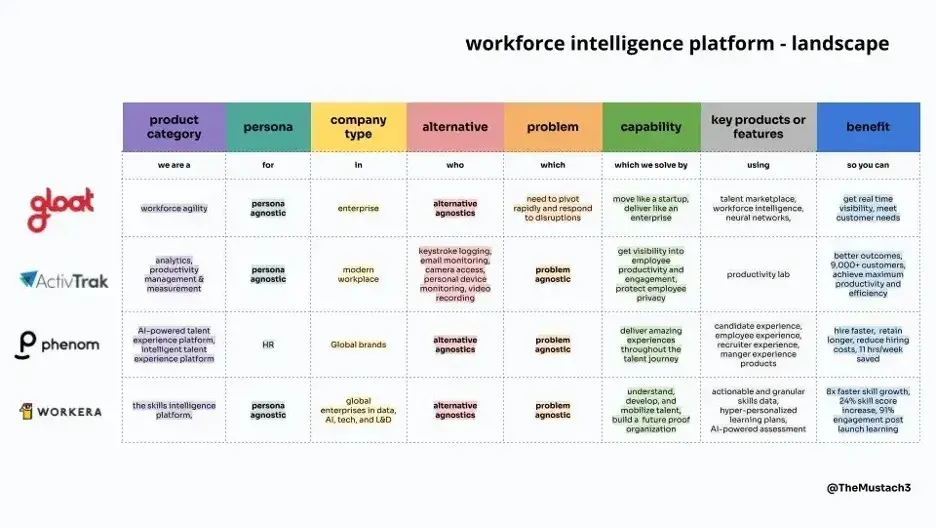
Testing It Out
In this table, I benchmarked Asana based on these criteria using the information I could find:
Criteria
Asana
Quality
- 100+ integrations
- Automation rules
- AI features for project management
- Highly praised for user-friendly interface
Price
Offers a free tier and paid plans starting from $10.99/month per user. Advanced features and integrations are available at higher price points.
Customer Service
- Live chat
- Phone support
- Ticket-based support
- Tutorials in Asana Academy
- Knowledge base and community forum
Brand Reputation
Considered one of the best project management tools, with a slightly more robust feature set compared to competitors.
4. Deep dive into their marketing strategy.
While the first few steps will tell you what you can improve in your core product or service, you also need to find how competitors market their products. A deep-dive into their marketing strategies will help you learn how they approach buyers.
I analyze every marketing channel, then note my observations on how they speak to their audience and highlight their brand personality.
Here are a few key marketing channels to explore:
- Website. Analyze the website structure and copy to understand their positioning and brand voice.
- Email. Subscribe to emails to learn their cadence, copywriting style, content covered, and other aspects.
- Paid ads. Use tools like Ahrefs and Semrush to find if any competitor is running paid ads on search engines.
- Thought leadership. Follow a brand’s thought leadership efforts with content assets like podcasts, webinars, courses, and more.
- Digital PR. Explore whether a brand is investing in digital PR to build buzz around its business and analyze its strategy.
- Social media. See how actively brands use different social channels and what kind of content is working best for them.
- Partnerships. Analyze high-value partnerships to see if brands work closely with any companies and mutually benefit each other.
I recommend creating a document capturing every detail of a competitor’s marketing strategy. This will give you the right direction to plan your marketing efforts.
5. Perform a SWOT analysis.
The final step in a competitive analysis exercise is creating a SWOT analysis matrix for each company — and yours, too, so you can compare.
SWOT stands for strengths, weaknesses, opportunities, and threats, and this is what you’ll identify in this step.
- Strengths. Identify your strengths. These may include specific pieces of intellectual property, products that are unique to the market, or a workforce that outperforms the competition.
- Weaknesses. Here, it’s worth considering potential issues around pricing, leadership, staff turnover, and new competitors in the market.
- Opportunities. This part of the SWOT analysis can focus on new market niches, evolving consumer preferences, or new technologies being developed by your company.
- Threats. These might include new taxes or regulations on existing products or an increasing number of similar products in the same market space that could negatively affect your overall share.
Questions to consider:
- What is your competitor doing well?
- Where do they have an advantage over your brand?
- What is the weakest area for your competitor?
- Where does your brand have the advantage over your competitor?
- In what areas would you consider this competitor a threat?
- What could competitors do better?
- Are there opportunities in the market that your competitor has identified?
With these answers, you’ll be able to compare their weaknesses against your strengths and vice versa. By doing this, you can better position your company, and you’ll start to uncover areas for improvement within your own brand.
Use tools like Miro to visualize this data and you’ll get a clearer idea of where you can outgrow each competitor.
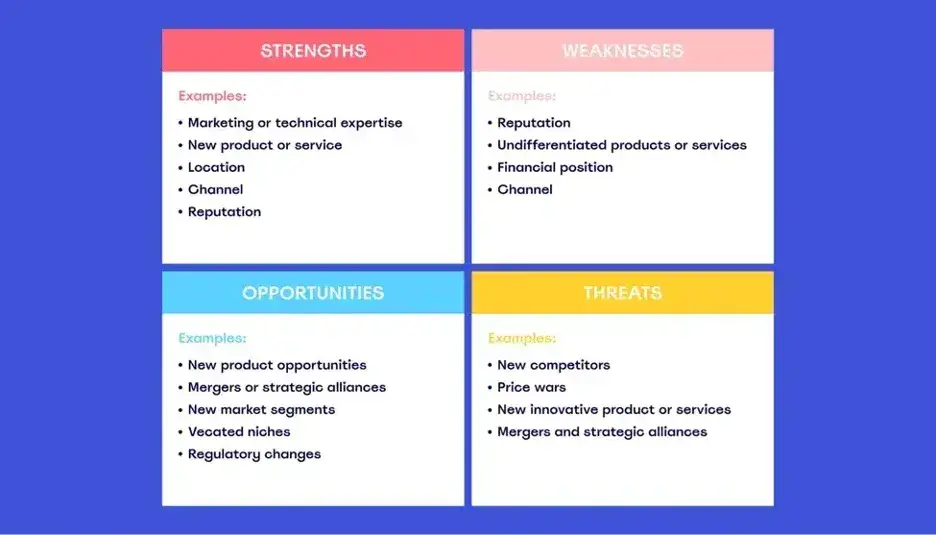
Testing It Out
Here’s a SWOT analysis matrix I created for Asana as a competitor of Trello:
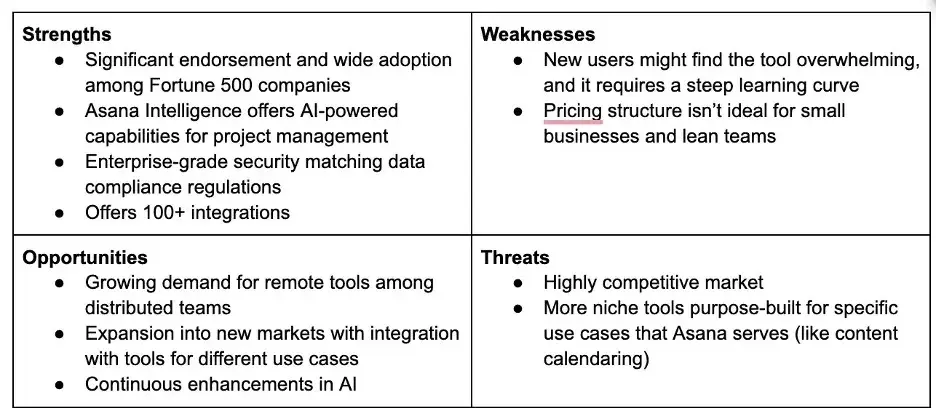
In this section, I’ll go over the competitor research process I outlined above, but with additional steps. To help me get into the weeds on this topic, I talked to marketing experts who use competitive analysis in their agencies and asked them to explain to me how they carry out their analyses. They had a wealth of tips to share.
And if you’re ready to get started on a complete and effective competitive analysis on your own, download these free competitive analysis templates, which range in purpose from sales to marketing to product strategy.
Featured Resource: 10 Competitive Analysis Templates
1. Determine who your competitors are.
First, figure out who you’re competing with. As mentioned earlier, this might not be who you think it is, and you should use multiple sources to see what brands pop up.
“To determine your competitors, start by talking with your internal teams to learn who they consider competitors,” says Jennifer Hall, associate director of agency marketing at Vision Media.
“If you regularly do client interviews, you can include [the other brands] they were thinking of when shopping for your product or service.”
Hall also suggests “surveying your customer service team since they directly connect with your customers” and ensuring that “your sales teams ask prospects who else they have spoken to.” You’ll want to know who a prospect went to if they didn’t choose you.
And, as discussed in the sections above, she mentions the importance of keyword searches. “Search online for your product or service and see what other businesses come up for the main keywords that reflect your business.” Once you have a list, she advises using tools like SparkToro, SEMRush, or Ahrefs to collect competitor analytics on keywords, rankings, domain ranking, authority, and engagement.
The key thing to remember when determining the competition is that: “You should see the same names coming up, but you should also see some surprises,” Hall tells me. “Your stakeholders may not consider your business in the same category… but if prospects are considering them then you need to include them in your analysis.”
2. Determine what products your competitors offer.
Once you’ve got a competitor list, you’ll want to analyze your competitor’s complete product line and the quality of the products or services they’re offering. You should also take note of their pricing structures and any discounts they’re offering customers.
To get started, David Hunter of Local Falcon, says, “A competitor’s website is the first stop, but it’s not the only place to look. I dig into customer reviews and FAQs because they often reveal details that aren’t obvious on the main site.”
Google Business profiles, ecommerce platforms, and industry forums are other places to expose hidden offerings, Hunter tells me. “Sometimes, competitors package their products differently or provide unique services that you wouldn’t notice just by skimming their homepage.”
Questions to consider:
- Are they a low-cost or high-cost provider?
- Are they working mainly on volume sales or one-off purchases?
- What is their market share?
- What are the characteristics and needs of their ideal customers?
- Are they using different pricing strategies for online purchases versus brick-and-mortar?
- How does the company differentiate itself from its competitors?
- How do they distribute their products/services?
3. Research your competitors’ sales tactics and results.
Next, research sales tactics and their results. The purpose is to give you an idea of how competitive the sales process is and what information your sales reps will need in order to compete during the final-buy stage.
For this, the number one tip I heard was: become their lead.
“We signed up for three competitors’ free trials using different company email addresses and documented their entire sales sequence, from initial outreach timing to follow-up cadence and objection handling,” says Matt Bowman, CEO and founder of Thrive Local.
“Email sign-ups and lead magnets can reveal a lot about their approach,” Hunter adds.
“Don’t hesitate to mystery shop a competitor by completing an online contact form, emailing a business development contact, or visiting their locations,” Jennifer Hall tells me. “Follow them on their social media channels and subscribe to their newsletters to receive constant updates on what they are doing.”
But there are other approaches as well. “I pay attention to how competitors structure their sales funnel. Are they offering free trials, demos, or limited-time discounts?” details Hunter. “Also, analyzing their ad strategies through tools like Meta Ads Library or Google Ads transparency tools can give insights into which promotions they’re running and how aggressive they are with paid acquisition.”
Another option, says Hall, is to ask clients who have been with competitors in the past. This gives you room to find out about sales tactics and also why the client switched.
Questions to consider:
- What does the sales process look like?
- What channels are they selling through?
- Do they have multiple locations, and how does this give them an advantage?
- Are they expanding? Scaling down?
- Do they have partner reselling programs?
- What are their customers’ reasons for not buying? For ending their relationship with the company?
- What are their revenues each year? What about total sales volume?
- Do they regularly discount their products or services?
- How involved is a salesperson in the process?
4. Take a look at your competitors’ pricing, as well as any perks they offer.
Correctly pricing your product has a lot to do with how much your competitors are charging for a similar product or service.
“Pricing isn’t always easy to find, but it’s worth the effort,” Hunter tells me. “If it’s not listed publicly, I look at customer reviews, which sometimes mention price ranges, or check aggregator sites that compare services.”
If you feel your product offers superior features compared to those of a competitor, you might consider making your product or service more expensive than industry standards. But if you do, ensure your sales reps are ready to explain why your product is worth the additional cost.
Alternatively, perhaps you feel there’s a gap in your industry for affordable products. If that’s the case, you might aim to charge less than competitors and appeal to prospects who aren’t looking to break the bank for a high-quality product.
In addition, “Some businesses use perks — like extended warranties or loyalty programs — to offset higher pricing. Understanding this helps in positioning your own pricing strategy effectively,” Hunter concludes.
5. Ensure you’re meeting competitive shipping costs.
Did you know that expensive shipping is the most frequently cited reason for cart abandonment?
“For ecommerce businesses, competitive shipping rates can make or break conversions,” says Hunter.
“I analyze what competitors are charging for shipping, whether they offer free shipping thresholds, and if they have partnerships with carriers for better rates,” he continues.
“If a competitor is absorbing shipping costs, it’s important to assess whether that’s sustainable for your business or if you need to offer something of equal value.”
6. Analyze how your competitors market their products.
Analyzing marketing efforts means gauging the channels through which marketing happens and what types of assets are created.
The first step is to “run Google searches by category, visit their websites, and review their products and services pages,” advises Hall.
To go further, “I reverse-engineer competitor marketing by tracking their ad placements, looking at their organic social presence, and seeing where their traffic comes from,” Hunter says. “If they’re running successful PPC campaigns, those keywords are worth noting.”
He also mentions using tools like SEMrush or Ahrefs to “help map out content gaps and reveal which marketing channels are actually driving traffic.”
Lastly, “Pull exact messaging and creative examples from the competitive data platforms to review what channels and spend levels support their messages,” says Max Barkley, associate director of digital strategy at Vision Media — who focuses on competitive analysis as it relates to media buying agencies.
To start, track if competitors are using any of the following:
- Blogs
- Whitepapers or ebooks
- Videos or webinars
- Podcasts
- Static visual content, such as infographics or cartoons
- Slide decks
- Website FAQs section
- Featured articles
- Press releases
- Media kit
- Case studies
- Buying guides and data sheets
- Online and offline ad campaigns
7. Take note of your competition’s content strategy.
Once you understand the channels and assets, take a look at the quantity and frequency of output. Are there hundreds of blog posts or just a few? Are they publishing weekly, monthly, or even less often?
“I analyze which platforms competitors prioritize, how often they publish, and what type of engagement their content gets” Hunter explains. “If a competitor is dominating short-form video or thought leadership content, it’s a sign to explore those formats yourself.”
Another pro tip is to “add them to your competitor list on LinkedIn to track their follower metrics,” says Hall.
It’s also a perfect place to inject some basic AI tools, like ChatGPT, Claude, or Perplexity.
“With the right prompts, your favorite AI assistant can provide all the information you’re looking for. But,” she adds, “remember to vet the responses.”
Questions to consider:
- How accurate is their content?
- Are spelling or grammar errors present?
- How in-depth does their content go? (Is it at the introductory level, just scratching the surface, or does it include more advanced topics with high-level ideas?)
- What tone do they use?
- Is the content structured for readability? (Are they using bullet points, bold headings, and numbered lists?)
- Is their content free and available to anyone, or do their readers need to opt in?
- Who is writing their content? (In-house team? One person? Multiple contributors?)
- Is there a visible byline or bio attached to their articles?
- What photos or imagery do they use? Stock photos? Illustrations? Custom? (And with stock photos, do they use quotes or calls-to-action specific to their business?)
All of this will give you a solid understanding of your competitors’ content marketing strategy.
8. Learn what technology stack your competitors use.
Understanding what types of technology your competitors use can be critical for helping your own company reduce friction and increase momentum within your organization.
“Tech stacks tell a lot about efficiency and automation,” Hunter tells me. “Tools like BuiltWith and Wappalyzer reveal what software competitors use for everything from email marketing to customer support. If a competitor is scaling rapidly, their tech choices can give clues about what’s working for them.”
Max Barkley agrees, adding Ghostery as an additional tool to analyze competitors’ ad tech, analytics, and CRM tools.
As another route, you can also look at competitors’ job listings, particularly for engineer or web developer roles. The job listing will likely mention which tools a candidate needs to be familiar with — a creative way to gain intel into the technology your competitors use.
9. Analyze the level of engagement on your competitor’s content.
To assess how engaging your competitor’s content is to their readers, you’ll need to see how their target audience responds to what they’re posting.
“Engagement metrics show more than just vanity likes — they highlight what resonates with an audience,” explains Hunter. “I track comment sentiment, share frequency, and how competitors respond to questions. If a specific content format consistently drives high engagement, it’s a clear signal that it’s worth testing.”
When assessing your competitor’s content, ask the following:
- Do certain topics resonate better than others?
- Are the comments negative, positive, or mixed?
- Are people tweeting about specific topics more than others?
- Do readers respond better to social updates about certain content?
- Do competitors categorize their content using tags?
- Do they have social media follow and share buttons attached to each piece of content?
10. Observe how they promote their marketing content.
From engagement, you’ll move along to your competitor’s content promotion strategy.
“Promotion strategies often dictate how successful content is. Some brands rely heavily on paid ads, while others thrive through partnerships or influencer collaborations. Tracking backlink strategies and cross-promotion tactics can reveal gaps in your own approach,” Hunter advises me.
Questions to consider:
- Which keywords are your competitors focusing on that you haven’t tapped into?
- What content is highly shared and linked to? How does your content compare?
- What other sites are linking back to your competitor’s site but not yours?
- Who else is sharing what your competitors are publishing?
- Who is referring traffic to your competitor’s site?
- For the keywords you want to focus on, what is the difficulty level?
11. Look at their social media presence, strategies, and go-to platforms.
Evaluate your competitor’s social media presence and engagement rates to see how you compare and where you can improve.
“Every platform has a different user base, and competitors choose their social presence based on where their audience engages most,” Hunter explains. “I analyze post frequency, content format, and community interaction. If a competitor is gaining traction on a new platform, it might be worth exploring before the space becomes saturated.”
Questions to consider:
- How does your competition drive engagement with their brand through social media?
- Does your competitor have links to their social media channels in the header, footer, or somewhere else? Are these clearly visible?
- Do they use calls-to-action?
- Are they more focused on driving people to landing pages, resulting in new leads? Or are they posting visual content to promote engagement and brand awareness?
- How much of this content is original? Do they share curated content from other sources? Are these sources regular contributors? What is the overall tone of the content?
- How does your competition interact with its followers? How frequently do their followers interact with their content?
12. Perform a SWOT Analysis to learn their strengths, weaknesses, opportunities, and threats.
The last step is to create a SWOT analysis, which we delved into pretty deeply in the “5 quick steps” section above. The main point is to compare the strengths and weaknesses of your brand and those of the competition. This is a great place to visualize the research you’ve compiled up to this point, and start putting all the pieces together.
However, “A proper SWOT analysis isn’t just about identifying strengths and weaknesses — it’s about actionable insights. I look at what competitors are doing exceptionally well, where they fall short, and what external opportunities and threats exist for the industry as a whole. This perspective helps businesses not only compete but also differentiate,” concludes Hunter.
Competitive Analysis Templates
As I’m sure you can tell, competitive analysis is complex — especially when you’re assessing multiple companies and products simultaneously.
To help streamline the process, we created 10 free templates that help you see how you stack up against the competition, and what you can do to increase market share.
When you download the free templates, you’ll have access to:
- Two-Feature Competitive Landscape Chart
- Competitor Strategic Overview
- Content Marketing Analysis Template
- You vs. Competitor Side-By-Side
- Competitor Battle Card
- Multiple Competitor Feature Comparison
- Multiple Competitors Scoring Card
- SWOT Analysis Template
- Categorical Feature Comparison Template
- Review Tracker
Competitive Analysis Example
By now, the goal of competitive analysis should be clear. How do you stack up against the competition? Where are you similar, and what sets you apart?
By understanding this, you’re better positioned to make strategic decisions that can help grow your brand.
Of course, it’s one thing to understand the benefits of competitive analysis, and it’s another to actually carry out an analysis that yields actionable results. If you want to see how it’s down, I’ve got you covered with a quick case study.
Sony vs. Nintendo
Let’s take a look at popular gaming system companies Sony and Nintendo.
When Sony’s PlayStation 5 hit the market in late 2020, it was plagued by supply shortages.
Nintendo’s Switch console, meanwhile, had been around since 2017, but remained a consistent seller, especially among teens and children.
This scenario is familiar for many companies on both sides of the coin; some have introduced new products designed to compete with established market leaders, while others are looking to ensure that reliable sales don’t fall.
Using some of the steps listed above, I’ll go through this case as a competitive analysis example.
1. Determine who your competitors are.
In our example, it’s Sony vs. Nintendo, but it’s also worth considering Microsoft’s Xbox, which occupies the same general market vertical.
This is critical for effective analysis; even if you’re focused on specific competitors and how they compare, it’s worth considering other similar market offerings.
2. Determine what products your competitors offer.
PlayStation offers five PS5 versions at different price points — digital and disc editions, the slim versions of the digital and disc editions, and the Pro. Nintendo, meanwhile, offers three versions of its console.
Both companies also sell peripherals — for example, Sony sells virtual reality (VR) add-ons, while Nintendo sells gaming peripherals such as steering wheels, tennis rackets, and differing controller configurations.
3. Research your competitors’ sales tactics and results.
When it comes to sales tactics and marketing, Sony and Nintendo have very different approaches.
In part thanks to a semiconductor shortage, Sony drove up demand via scarcity — with very low volumes of PS5 consoles available. While Nintendo adopted a broader approach by targeting families as its primary customer base.
This effort was bolstered by the Switch Lite product line, which is smaller and less expensive, making it a popular choice for children.
As of December 2024, Nintendo had sold 150.86 million units globally, while Sony had sold 74.9 million. While it’s true that Nintendo had a three-year lead, it was still outselling Sony in the 12-month period of 2024.
4. Take a look at your competitors’ pricing, as well as any perks they offer.
Sony has the higher price point: Their priciest PS5 sells for $699, while Nintendo’s most expensive offering comes in at $349. Both offer robust digital marketplaces and the ability to easily download new games or services.
Here, the key differentiators are flexibility and fidelity. The Switch is flexible — users can dock it with their television and play it like a standard console or pick it up and take it anywhere as a handheld gaming system.
The PS5, meanwhile, has superior graphics hardware and processing power for gamers who want the highest-fidelity experience.
5. Analyze how your competitors market their products.
If you compare the marketing efforts of Nintendo and Sony, the difference is immediately apparent: Sony’s ads feature realistic in-game footage and speak to the exclusive nature of their game titles.
The company has managed to secure deals with several high-profile game developers for exclusive access to new and existing IPs.
Nintendo, meanwhile, uses brightly lit ads showing happy families playing together or children using their smaller Switches while traveling.
6. Analyze the level of engagement on your competitor’s content.
Engagement helps drive sales and encourages repeat purchases.
While there are several ways to measure engagement, social media is one of the most straightforward.
If we look at engagement as measured by followers, Sony enjoys a significant lead over Nintendo: While the official PlayStation Facebook page has 38 million followers, Nintendo has just 5 million.
Competitive Product Analysis
Competitive product analysis is somewhat different than what I’ve just been discussing. It’s an approach to competitor research that focuses on the products themselves.
Product analysis drills down to discover key differences and similarities in products that share the same general market. With this analysis, the aim is to avoid losing market share to competitors selling products in a similar market niche.
Using the case study above, let’s go through how competitive product analysis differs from an overall competitive analysis.
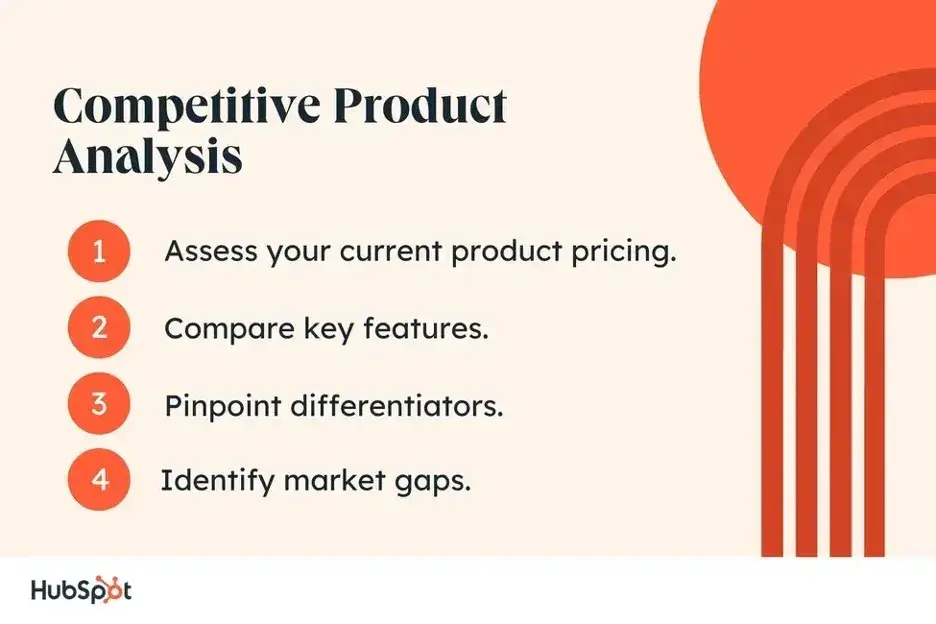
1. Assess your current product pricing.
The first step in any product analysis is to assess current pricing.
Nintendo offers three models of its Switch console: The lite version is priced at $199, the standard version is $299, and the OLED version is $349.
Sony offers five PlayStation 5 consoles: The digital edition costs $349, the disc edition costs $399, the digital edition (slim) costs $449, the disc edition (slim) costs $499, and the Pro costs $699.
2. Compare key features.
Next is a comparison of key features. In the case of our console example, this means comparing features like processing power, memory, and hard drive space.
Feature
PS5 Disc edition
Nintendo Switch
Hard drive space
825 GB
32 GB
RAM
16 GB
4 GB
USB ports
4 ports
1 USB 3.0, 2 USB 2.0
Ethernet connection
Gigabit
None
3. Pinpoint differentiators.
With basic features compared, it’s time to dive deeper with differentiators. While a glance at the chart above seems to indicate that the PS5 is outperforming its competition, this data only tells part of the story.
Here’s why: The big selling point of the standard and OLED Switch models is that they can be played as either handheld consoles or docked with a base station connected to a TV. What’s more, this “switching” happens seamlessly, allowing players to play whenever, wherever.
The PlayStation offering, meanwhile, has leaned into market-exclusive games that are only available on its system to help differentiate it from its competitors.
4. Identify market gaps.
The last step in a competitive product analysis is looking for gaps in the market that could help your company get ahead.
When it comes to the console market, one potential opportunity gaining traction is the delivery of games via cloud-based services rather than physical hardware.
Companies like Nvidia and Google have already made inroads in this space, and if they can overcome issues with bandwidth and latency, it could change the market at scale.
Competitive Analysis: FAQs
What is a competitive analysis framework?
A competitive analysis framework is a structured approach used to evaluate potential competitors. It guides businesses to identify competitive advantages, understand market positioning, and inform strategic decisions.
How do you do a good competitive analysis?
Conducting a thorough competitive analysis involves several steps:
- Identify competitors. Start by listing key competitors in your market, both direct and indirect.
- Evaluate their products/services. Analyze what they’re selling and how it compares to your offerings.
- Analyze market position. Determine their market share, brand perception, and unique value proposition.
- Check their marketing strategies. Observe their advertising, content marketing, PR efforts, and online presence.
- Assess their financial health. If available, review financial statements, annual reports, or investor presentations.
- Gather customer feedback. Reviews, testimonials, and surveys can give insights into competitor strengths and weaknesses.
- Regularly review and update. The market evolves, and competitors change strategies, so it’s vital to keep your analysis current.
What are the five parts of a competitive analysis?
The five key components of a competitive analysis include:
- Company overview. A brief snapshot of the competitor, including its history, size, and mission.
- Product/service analysis. An examination of their key products or services and how they compare to yours.
- Marketing strategy. Insights into their promotional tactics, target audience, and unique selling propositions.
- Operational analysis. An understanding of their supply chain, distribution, and customer service practices.
- Strengths and weaknesses. A clear breakdown of where the competitor excels and where they might be vulnerable.
What are the 3 C’s in a competitive analysis?
The 3 C’s refer to a strategic model that considers three main factors when understanding the broader business environment:
- Company. Understanding your own strengths, weaknesses, opportunities, and threats.
- Customers. Knowing who your target audience is, what they value, and how they behave.
- Competitors. Analyzing direct and indirect competitors to determine market dynamics and potential threats.
Is SWOT analysis a competitive analysis?
Yes, SWOT analysis is a type of competitive analysis. SWOT stands for Strengths, Weaknesses, Opportunities, and Threats. It is a strategic planning tool used to identify and analyze these four elements of a business.
While a SWOT analysis can be focused internally on a company‘s own attributes, when used as a competitive analysis tool, it assesses a competitor’s SWOT to understand where your business has advantages or might be vulnerable.
Wrap Up: Competitive Analysis in Marketing
In my years of experience, I’ve found that competitive analysis is crucial for business growth, but it starts with understanding your own position.
My top recommendation? Before comparing competitors, establish your own baseline.
Take an objective look at your business using the same metrics I discussed in this article for evaluating competitors. This self-assessment not only prepares you for a more accurate SWOT analysis but later helps you identify how your own strengths and weaknesses compare.
Remember, competitive analysis isn‘t a one-time task. Markets evolve, and so do competitors. Regular analysis helps you stay ahead of trends and adapt your strategies accordingly.
Editor’s Note: This post was originally published prior to June 2017 but has been updated for comprehensiveness.

![Ecommerce Customer Journey Mapping — How to Set Potential Shoppers Up to Buy [Tips & Template]](https://comsbusiness.com/wp-content/uploads/2025/05/2046115973.png)
Ecommerce Customer Journey Mapping — How to Set Potential Shoppers Up to Buy [Tips & Template]
Whether you’re running an online store or managing marketing campaigns for an ecommerce brand, it’s worth your while to invest time and energy in creating an ecommerce customer journey map.
Whether you’re running an online store or managing marketing campaigns for an ecommerce brand, it’s worth your while to invest time and energy in creating an ecommerce customer journey map.
Ecommerce journeys may be faster than typical B2B buying cycles, but they still involve multiple customer touch points. Understanding the stages of your buyer’s journey and optimizing each touchpoint can make a significant difference in business outcomes — specifically, conversions, retention, and brand loyalty.
In this guide, I’ll show you how to improve and map your ecommerce company’s customer journey.
Table of Contents
- What is the ecommerce customer journey?
- Why is the ecommerce customer journey important?
- Stages of the Ecommerce Customer Journey
- How to Improve Your Ecommerce Customer Journey
- Ecommerce Customer Journey Map
- How to Build an Ecommerce Customer Journey Map
In the awareness stage, potential customers find your brand or product through ads, search results, or word-of-mouth recommendations.
During consideration, they compare options, read reviews, and assess how your product fits their needs.
The decision stage is where they commit to a purchase, influenced by trust factors like product benefits, pricing, and social proof.
After buying, the retention stage kicks in — where product quality, onboarding, customer service, and follow-up communication determine whether they’ll return. If their experience is exceptional, they may progress to advocacy, recommending your brand to their friends and colleagues. I’m sure it’s not surprising that this directly correlates with your bottom line — 81% of consumers trust personal recommendations.
Pro tip: Don’t neglect new customer onboarding. Even in ecommerce, teaching them to use your product means they fall in love with it and are likely to continue to buy from you.
Focusing only on awareness, consideration, or decision at the expense of post-purchase experiences is a mistake. While you need a continual flow of new customers, new customer acquisition costs 5x more than customer retention, and a 5% retention increase correlates with a 25% increase in profitability.
Why is the ecommerce customer journey important?
If you only have a single takeaway about the ecommerce customer journey, it should be that tracking clicks is only the start. Instead, I want you to think of it as your key to decoding why customers are buying.
Even after years in marketing, mapping customer journeys remains my go-to process for uncovering invaluable insights into behavior, preferences, and points of friction.
Every touch point is an opportunity to improve the customer experience (CX) or fine-tune what you communicate. Why? From the moment they land at an online store to the final checkout process, every interaction shapes their perception, influences their likelihood of return, and cultivates brand loyalty.
To get started, I want you to use your customer data — quantitative and qualitative — to answer three questions:
- Where do potential buyers hesitate?
- What triggers their interest?
- Why do they abandon their cart?
By answering these questions, you can find ways to improve the user experience, increase conversions, and more effectively market your products.
So what’s the takeaway here? An accurate map of your ecommerce customer journey leads to improved conversions, retention, and brand advocacy.
Stages of the Ecommerce Customer Journey
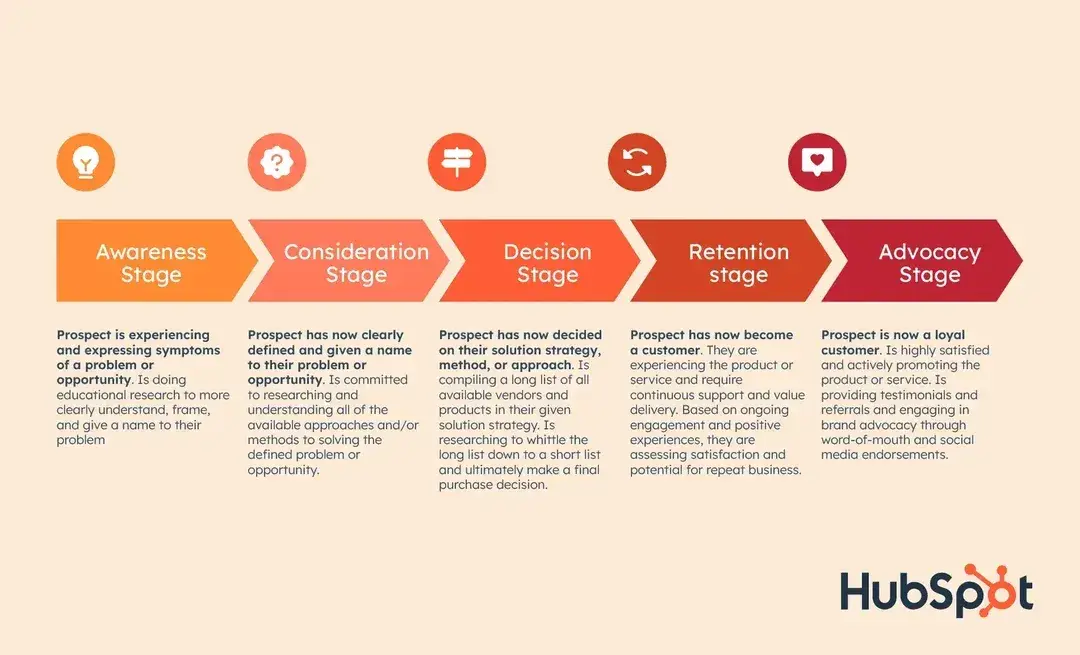
1. Awareness
Prospects become aware of their problem(s) and start researching potential solutions.
For example, if you sell productivity tools, someone struggling with time management might look for ways to stay organized. They might find you by:
- Searching for how-to posts and landing on your blog.
- Engaging with organic posts, ads, or influencer recommendations.
- Downloading free resources (guides, checklists) or signing up for newsletters to learn more.
2. Consideration
At this stage, buyers actively evaluate different solutions, reading product descriptions, watching reviews, and comparing features. You can win them over with:
- User-generated content like unboxing or testimonial videos.
- Great comparison charts and posts.
- Having a strong social media presence or email strategy.
Using the same example, they might search for the best productivity planners, read customer reviews, and explore your product’s unique benefits. They might also search ecommerce platforms like Amazon or even Google for available morning routine journals and evaluate reviews.
3. Decision
Here, customers narrow down their options and decide whether to buy. Factors that influence their choice include:
- Price and perceived value.
- Shipping speed and costs.
- Customer reviews and testimonials.
- Discounts or promotional offers.
Ultimately, shoppers will buy your product if it satisfies their needs or desires. For instance, perhaps your journal includes tips to help them establish their new routine or fun stickers to make using it fun.
4. Retention
A great purchase experience isn’t enough — product quality and customer service are important for the customer retention stage. HubSpot’s 2024 Consumer Trends Report found the top purchasing factors for consumers include product quality (51%) and past experiences with a product or brand (25%).
If your morning routine journal arrives late or poor packaging has led to ripped pages, your customer might not check out your other products.
But it’s not enough to just deliver the bare minimum. The study suggests that a focus on quality can be a competitive advantage — while over 80% of shoppers were satisfied with a recent social purchase, only about 30% felt that what they bought was “high quality.”
If you delight your customers, you still want to stay top of mind by exposing them to products through strategic marketing like retargeting ads and social media posts. This means they’ll think of you first when it’s time to buy again.
You can boost retention with:
- Loyalty programs that reward repeat purchases.
- Personalized follow-up emails with helpful product tips.
- Exclusive discounts for returning customers.
5. Advocacy
Satisfied customers naturally become brand advocates — or, as I call them, superfans. They share their experiences through reviews, word-of-mouth referrals, and social media mentions.
The best way to keep the love flowing is by continually delivering excellent experiences and rewarding them through loyalty programs and referral incentives. Most are happy to share or review a product they love, but they’ll keep doing it if there’s something in it for them.
With that in mind, your best advocacy strategies are:
- Asking for reviews and testimonials.
- Creating a referral program and sharing it with your customers.
- Sharing user-generated content featuring your products.
You can deepen your understanding of the ecommerce customer journey with HubSpot Academy’s free Ecommerce Marketing Course.
How to Improve Your Ecommerce Customer Journey
Understanding the customer journey is only the first step — optimizing it is what drives business growth. In this section, I’ll show you how to use proven engagement principles to convert more customers.
1. Improve customer delight.
Customers who enjoy interacting with you are more likely to journey with your brand. The more you delight customers, the higher your campaigns’ conversion rates and the deeper customers engage with your brand.
Here’s how to get a sea of happy customers:
- Personalize rewards for birthdays or special events.
- Host exclusive events.
- Provide branded swag.
- Cultivate a brand community.
- Surprise with flash sales or loyalty discounts.
- Engage one-on-one on social media.
Last year, I got this birthday email from Target Circle offering me 5% extra savings if I chose to spend money with them in the next 30 days. While not technically ecommerce, you can see how this plays out.
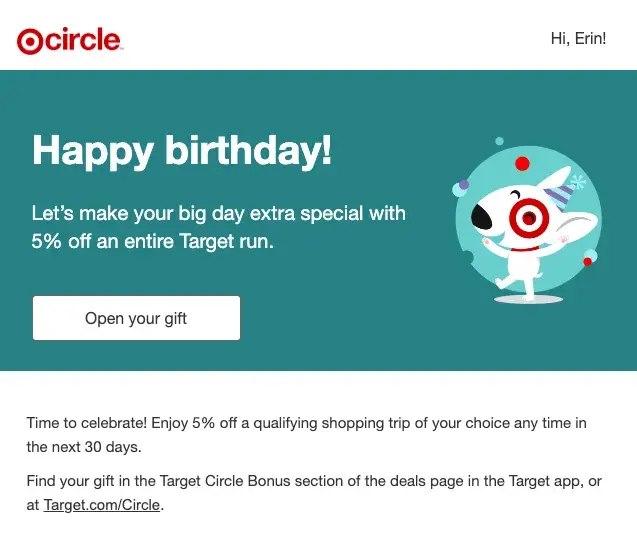
Pro tip: What delights my customers may not delight yours, so be creative and keep exploring ways to build lasting connections.
2. Create FOMO.
The fear of missing out (FOMO) is the anxiety of feeling left out from enjoyable experiences others are having. Renowned business psychologist and author Robert Cialdini popularized the idea in his book Influence.
FOMO is one of the most potent marketing tools I use across all customer journey stages.
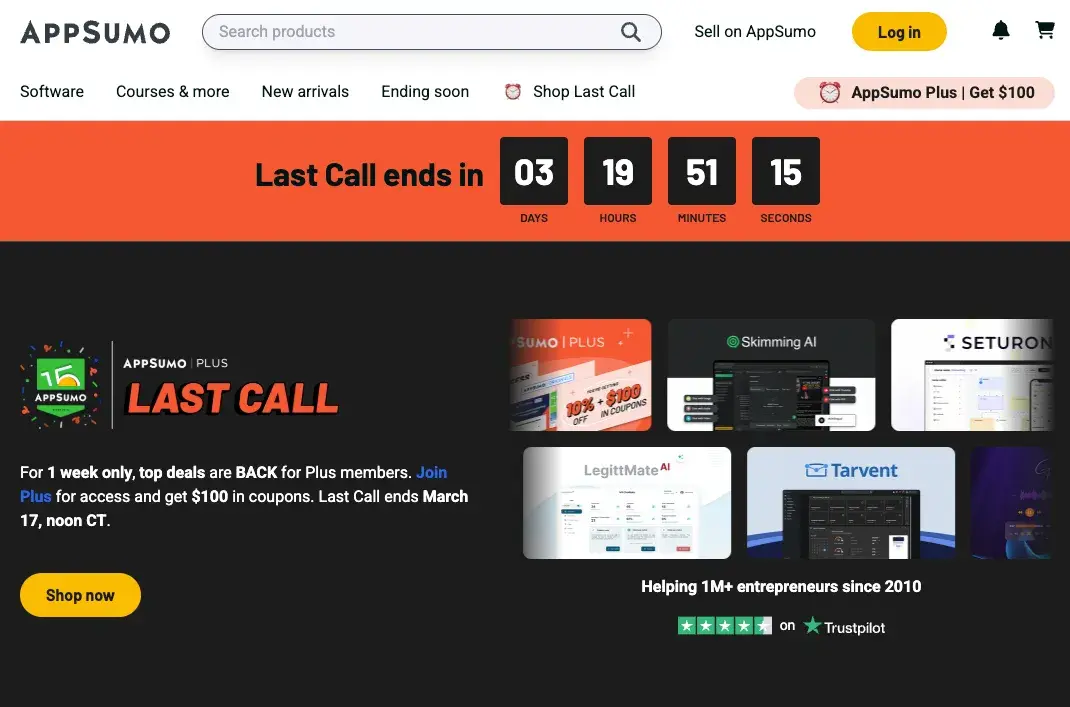
SaaS ecommerce platform AppSumo does this particularly well with bold colors and big countdown timers that identify how much time is left on a particular deal.
You can rouse this feeling in any of these ways:
- Display the number of products in stock.
- Add a sale countdown timer on the product page.
- Show a count of product views hourly or daily.
- Stress limited supplies.
- Spotlight event dates and set up a countdown email series.
At first, using FOMO may feel uncomfortable because you don’t want to come off as manipulative to buyers.
But FOMO is only a tool. It’s how you use it that makes it good or bad.
Pro tip: Consider using FOMO as a reminder to order while there’s a deal.
Customers have thanked me for notifying them that a product is on sale or an item they’re interested in will be out of stock soon.
3. Conduct surveys.
Search and market data give me a bird’s-eye view of patterns in customer behavior and demographic metrics, but surveys help me get personal with them. Talking to customers online or in person helps unearth insights other data collection methods might miss.
I like to use both real-time survey methods — like video or phone calls and in-person or online chats — as well as prerecorded options, such as forms, videos, SMS, website pop-ups, and emails.
Looking for a form option? I am partial to Typeform and VideoAsk (which is powered by Typeform) because of their UX.
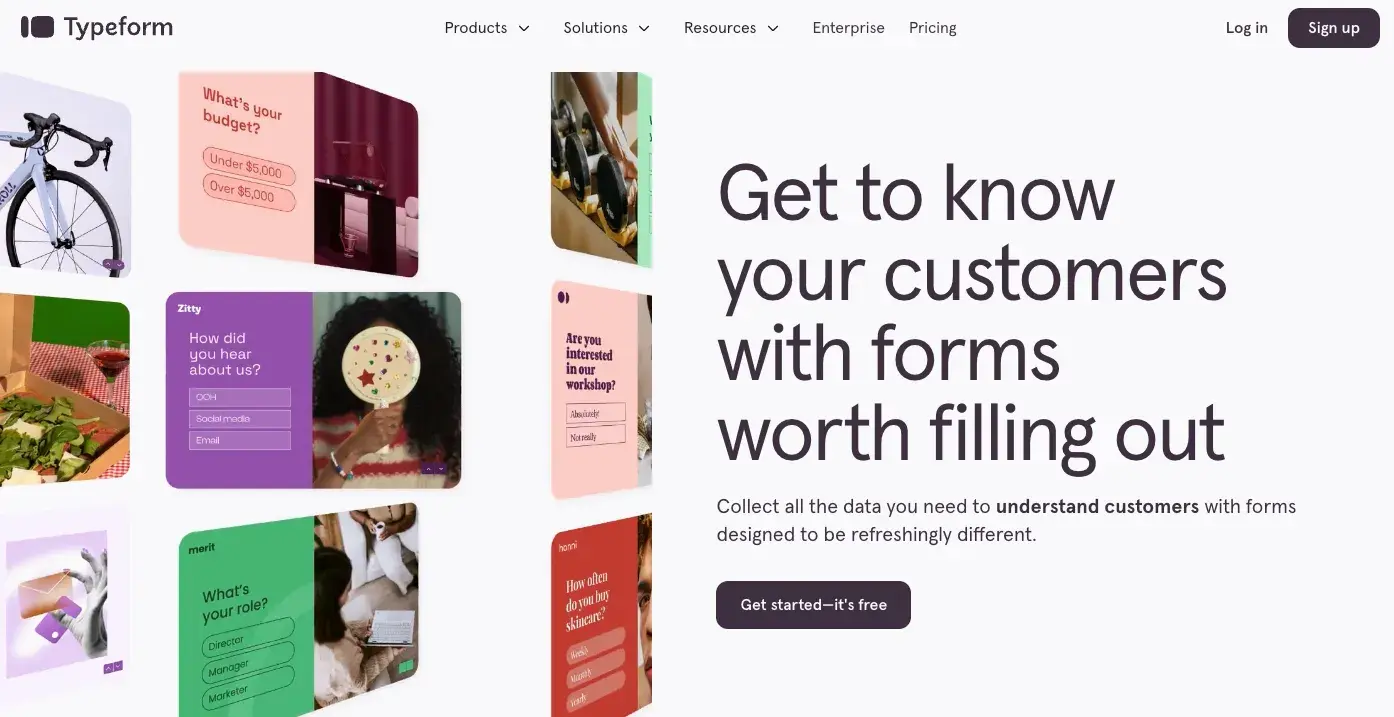
When I create surveys, I aim to gather information that expounds on what I learned from my initial audience research. I typically ask my customers questions related to why they act or feel a certain way.
For example, I may ask:
- Why choose us over competitors for this product?
- Which alternatives or competitors did you weigh before buying?
- What key issues do you need to address?
- What’s your budget for this solution?
- What features do you prioritize and why?
Pro tip: Use these insights to improve your product and update your product suite.
For instance, if Millennials are willing to spend $500 and Boomers $1,500 on my product, I might adjust my offerings and messaging to attract Boomers more.
4. Raise your social proof.
Customers have an easier time acting on recommendations and feeling confident when they see they’re not alone.
So, I engage the power of social proof.
Social proof is where people look to others’ actions or opinions to guide their behavior. And it works. Over 20% of consumers (and 36% of Millennials) have purchased a product in the last three months based on an influencer’s recommendation.
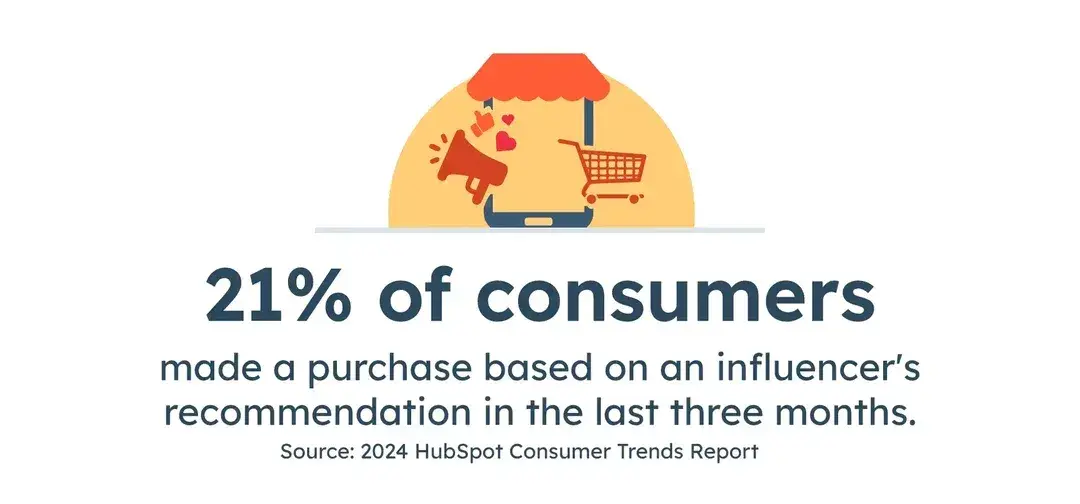
Here’s how I use it:
- Showcase reviews and testimonials.
- Display purchase count.
- Feature social media mentions.
If I can ensure shoppers see that others like my products, it boosts their likelihood of buying from my brand.
Pro tip: People like what other people like, so get creative with how you amplify people sharing the love.
5. Personalize every touch point.
Nowadays, buyers expect you to call them by name. I go beyond this and create personalized journeys that meet customer needs and expectations using customer data from every touch point.
Here’s how I offer personalized experiences:
- Include the contact’s name in messages.
- Customize offerings by location, purchase, or browsing history.
- Tailor exit pop-ups to each stage of the buyer journey.
- Craft offers that match prospective customers’ desires.
Need a visual? This customer journey map from Canva identifies some of those touch points and opportunities. From there, you can easily adapt it to individual touch points.
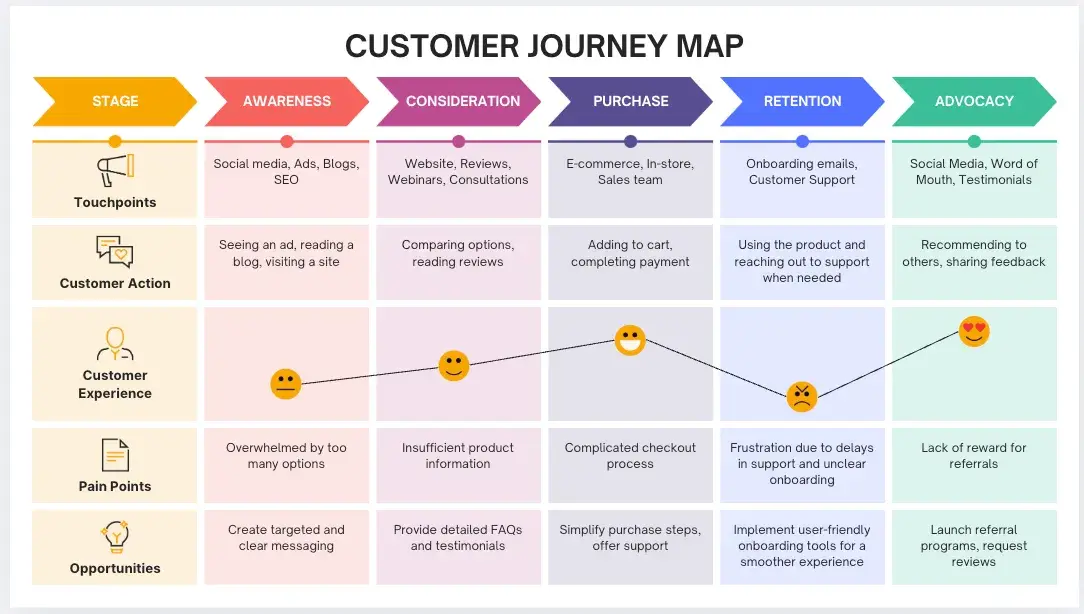
Thanks to HubSpot’s marketing automation software and my customer data, I can deliver unique experiences at scale. (As a HubSpot employee, I may be biased, but I’ve found that this tool is easy to use and can automate virtually any marketing task.)
Pro tip: Use social listening to pay attention to what your customers are saying and use it as a guide to future improvements.
For more tips, I recommend you read this article on customer journey thinking and watch the video below.
6. Optimize for mobile experiences.
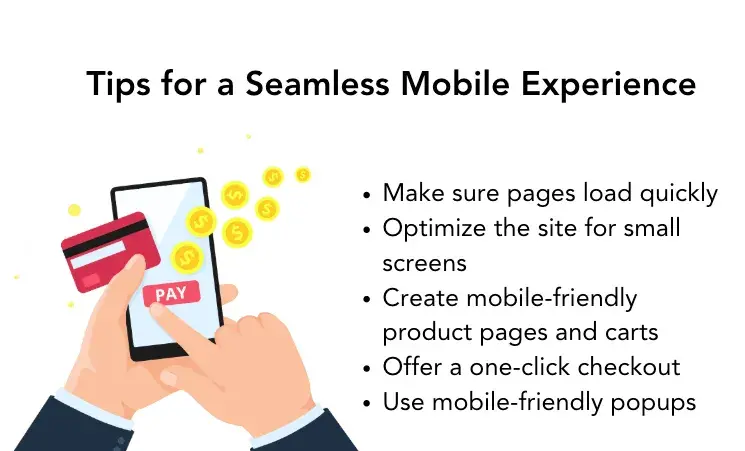
Mobile is the future of ecommerce — it’s ranked #1 over all other devices for online shopping. So the last thing you want is a sluggish site, one that only works well on desktop, or pop-ups that derail the user experience.
If they have to change gears — or devices — to buy from a computer, they won’t do it unless they are highly motivated to buy from you. You can deliver a seamless mobile experience by:
- Delivering fast load times.
- Optimizing the site for small screens.
- Creating mobile-friendly product pages and carts.
- Offering a one-click checkout.
- Using mobile-friendly popups.
Pro tip: Consider focusing on your social media shopping game as well as your mobile checkout.
Did you know that 47% of consumers are comfortable with buying directly from social media apps? In fact, the ecommerce app market is expected to grow 10% year-over-year.
7. Keep your checkout friction-free.
The more hoops your customers have to jump through, the more likely they are to abandon ship. And, it’s an uphill battle as it is. Less than one-third of all checkout visits result in a sale. According to YourCX, that number is even lower on mobile.
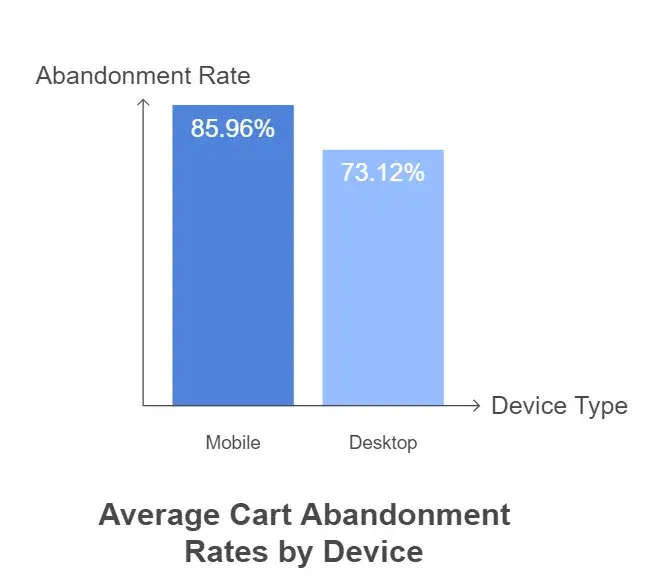
Anecdotally, I definitely see this — I can’t tell you how many tabs I have open with carts on different sites as I comparison-shop on my phone.
So how can you improve this? While you can’t control for external distractions like kids, dogs, or people not having their credit card handy, there are definitely a few options to simplify your checkout experience:
- Transparent pricing. Hidden fees at checkout can be a big turnoff for consumers.
- Required account creation. Offering a guest checkout can speed things up.
- Assurances of payment safety. Using trusted payment options like Stripe, Apple Pay, or Shopify to create a sense of security.
- Distraction-free checkouts. Remove any pop-ups, ads, or anything that might keep people from taking action.
Pro tip: Consider pre-filling the promo code with the current best deal if your software allows it.
More than once, I’ve gone back to the site to look for a promo code and gotten distracted before abandoning the cart.
8. Focus on the new customer experience.
The customer journey doesn’t end at checkout. As I mentioned above, it’s only the beginning. How you interact with buyers after their first purchase determines whether they return or forget about your brand.
Whether you’re selling noodles like Momofuku, dog toys like BarkBox, or Nut Butters like American Dream, you have an opportunity to create a ton of goodwill right away. (I’m currently staring at boxes from all three brands, so that’s why they’re top of mind.)
Your new customer experience could include:
- A quick email offering simple ideas for using (or tasting) the products.
- A quick thank you email with the brand story.
- A follow-up email to collect feedback.
- Share tutorials for getting the most out of your product.
- Samples of another type of product.
- Interesting reading material inside the box.
- A handwritten note in the box.
- Packaging with an extra touch.
Pro tip: Consider providing instructions (and a reward) for recording an unboxing video.
This video provides a helpful overview:
Additionally, you can send notes to your customers following up on the sample or products, asking for a review, and offering them an incentive to reorder — perhaps a free gift with purchase or in exchange for user-generated content.
Want to learn how to get and use user-generated content? Grab our guide here.
Now that we understand how the ecommerce customer journey works and ways to make it better, let’s bring it to life with a map.
Ecommerce Customer Journey Map
An ecommerce customer journey map shows the different steps your customer goes through and helps you plan how to improve each customer touch point. It highlights where they are in the buying process, their goals, and how they interact with your ecommerce store at various stages.
Doing your journey map the right way means answering questions like:
- What is the customer thinking or feeling?
- What actions are they taking at each stage?
- Where are they researching products?
- How can we guide them toward conversion?
HubSpot’s free customer journey map template offers the perfect starting point.
Let me walk you through how to use it to map your ecommerce customer journey.
What is the customer thinking or feeling?
Weigh your ideal customer’s thoughts and motivations across the awareness, consideration, and decision stages. Empathizing with, understanding, and addressing buyers’ expectations and worries helps guide them smoothly throughout the buying process.
Let’s assume a prospect is looking to go camping in the winter and exploring my outdoor gear web store for answers:
- Awareness. They’re going camping in the winter for the first time and feel unsure about packing. They want to know what gear to buy and how to pack it in a simple and compact way.
- Consideration. They’re comparing winter camping gear and feel uncertain about what to buy. They seek advice through blog posts and forums on finding compact, easy-to-use equipment to make their camping trip successful and enjoyable.
- Decision. The prospect decides to buy my brand’s winter camping gear. They feel more confident and prepared for their first winter camping adventure.
- Retention. Their new gear helped make their winter camping trip a success. They trust my brand, feeling confident in the quality and reliability.
- Advocacy. Impressed by the gear’s performance, they share positive reviews online, encouraging others to buy the same equipment.
Pro tip: Remember that loyalty isn’t automatic.
Encouraging repeat purchases means strategically re-engaging past buyers. Consider post-purchase email sequences, surprise incentives for second purchases, or VIP loyalty perks that make them feel valued.
For instance, if someone buys hiking boots from your store, an automated follow-up email could offer them a discount on hiking socks or a waterproofing spray — items that naturally complement their first purchase.
Then again, you don’t have to do it via email. By including a post-purchase pop-up, you can upsell them and help them solve a problem before it starts. Something like this could work: “Want to protect your purchase? Add waterproofing spray to your order for just $9.99.”
What is the customer’s action?
In my experience, customers can move forward from, return to, or repeat a previous stage or drop off the flywheel at any point in their journey.
Here’s how it could play out using that prospective customer from the winter gear example:
- Awareness. They want information about staying warm while camping in the winter, so they exchange their email address for my free warm-clothing guide and access to my community of winter camping buffs.
- Consideration. The prospective customer is considering thermal wear and other winter camping gear. So, they watch a live demo of how to combine thermal wear with other clothing items.
- Decision. The customer is serious about buying and is looking for a discount.
- Retention. The customer asks follow-up questions to help them use the thermal wear and returns for more equipment for future adventures.
- Advocacy. My responsiveness to their questions and support requests wins them over, so they subscribe to my referral program.
What or where is the buyer researching?
Buyers forage for information from disparate sources before reaching a decision.
So, here’s how their research journey will go:
- Awareness. They engage with blogs, white papers, social posts, and short videos to find the information they need and answer questions about preparing for winter camping.
- Consideration. The prospect is now curious about camping gear, like outdoor heaters, lighters, lanterns, sleeping bags, camping chairs, thermal clothing, and backpacks to carry it all. So, they’re comparing the best options, reading case studies, and watching longer videos to help them understand the benefits and drawbacks of these items.
- Decision. They buy their preferred camping items from my website after weighing each product through buyer reviews, samples, and specification sheets and using my chatbot to ask questions.
- Retention. They might visit competitor websites or even buy competitor products to compare them with mine. They’ll also review post-purchase support documents.
- Advocacy. When referring a potential buyer, they’ll share my blog posts, guides, and knowledge base articles to educate their friends and contacts about my product.
How will we move the buyer along their journey with us in mind?
Using incentives in your calls-to-action (CTAs) can drive a faster response, and subtle messaging can guide buyers along their path.
Going back to the winter camping gear example, here’s what that could look like:
- Awareness. I ask prospects for their email address in exchange for free guides on how to choose the best camping gear for their needs.
- Consideration. Once I have their contact information, I’ll engage my leads with more valuable content related to winter camping, warming them up to chat with my sales team or buy my camping gear.
- Decision. I demonstrate that I’m placing the customer’s interests ahead of profits by being honest about what my product can and can’t do. Whether the customer is ready to close a deal, sign up for a lesser offer, or part ways, I work to keep them in my flywheel for future sales or referral opportunities.
- Retention. I respond quickly to post-purchase questions and provide detailed user guides. I also offer free replacements for defective products.
- Advocacy. I proactively invite and incentivize customers to review and rate products and join my referral and loyalty programs.
Here’s what my map for the winter camping gear example would look like:
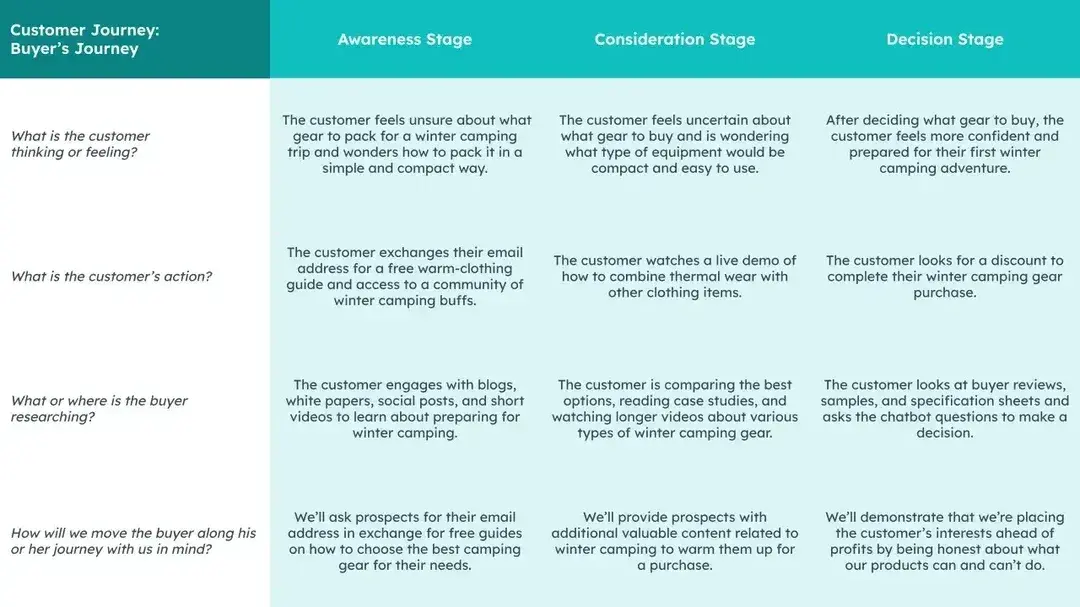
How to Build an Ecommerce Customer Journey Map
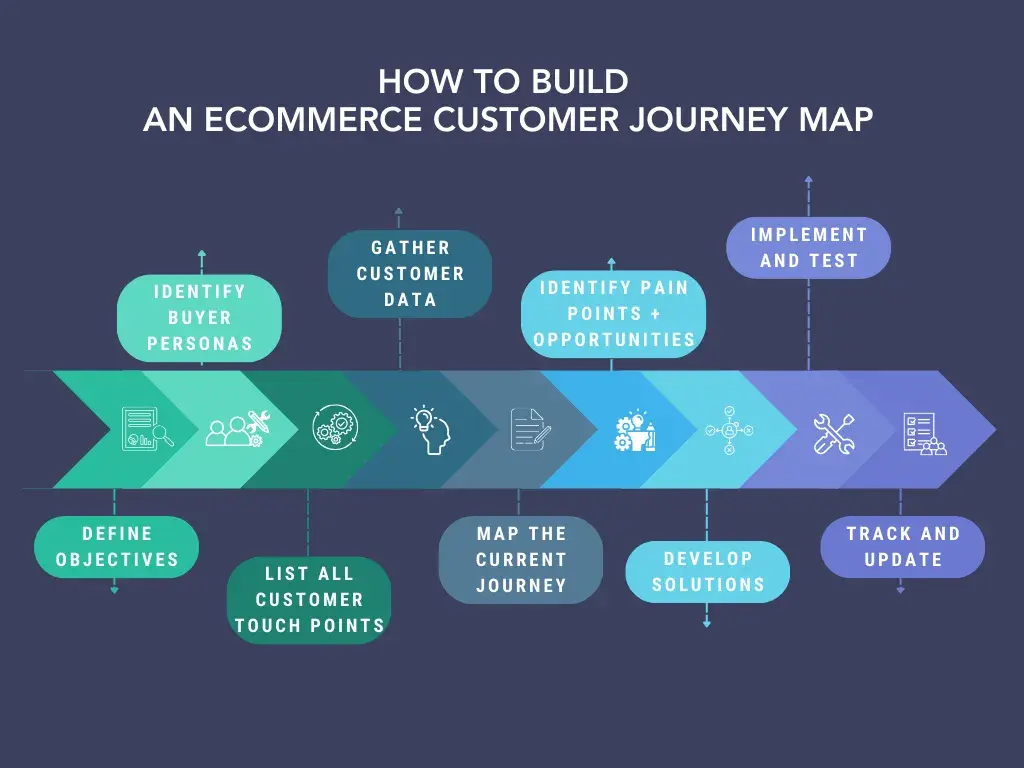
Ready to build your own map? Here are the steps I recommend, along with a few pro tips to help you get started.
Step 1: Define your objectives.
Clarify your goals before mapping out the journey. Are you looking to understand customer pain points, enhance the user experience, or optimize conversion rates? Setting a clear objective will help guide the mapping process.
Pro tip: I recommend going narrow to start. It’s tough to do it all at once, so choosing a specific goal and optimizing on that first makes it easier to get quick wins.
Need some ideas? Consider making sure your email automations are consistent or reducing cart abandonment.
Step 2: Identify your buyer personas.
Create a detailed customer persona based on real data, including demographics, behaviors, pain points, and purchasing motivations. A well-defined persona helps you visualize the ideal customer experience and tailor your journey map accordingly.
This is my favorite part, but I know some people find it overwhelming, so lean into available tools to find a starting point.
Pro tip: Use HubSpot’s free Buyer Persona Generator to streamline your process.
Step 3: List every customer touchpoint.
Identify all the ways customers interact with your brand — from initial awareness to post-purchase engagement. This includes website visits, email communications, social media interactions, product reviews, and customer support experiences.
Pro tip: Not all touchpoints are the same. Evaluate your problem areas based on impact and effort to find the low-hanging fruit (i.e., the highest impact for the lowest effort).
Consider taking the HubSpot Ecommerce Marketing Course to learn more about optimizing each touchpoint.
Step 4: Gather customer data.
Use both quantitative and qualitative research to understand customer behaviors at each stage.
- Quantitative. This data focuses on the numbers and includes website analytics, conversion data, and cart abandonment rates.
- Qualitative. This type of data is all about words and sentiment. It includes customer surveys, feedback forms, and live chat conversations.
Real insights from your customers will highlight pain points and opportunities for improvement. And, paying attention to the extremes is helpful here — you can find things that get lost in “average” data trends.
Pro tip: Pay attention to competitor reviews as well as your reviews to find opportunities. How people talk about competitor problems might just reveal your competitive advantage.
Step 5: Map the current customer journey.
Visualize how your customers move through each stage of the buying process. Use a timeline or flowchart to plot key interactions and decisions. You can use journey mapping tools or a simple spreadsheet to create this visual representation.
Pro tip: A wall of sticky notes can be a great way to see the big picture before you put all the information into our template.
Step 6: Identify pain points and opportunities.
Where do customers experience friction? Are they dropping off at checkout? Are they confused about your product options? Identifying these roadblocks allows you to take targeted actions to enhance their experience.
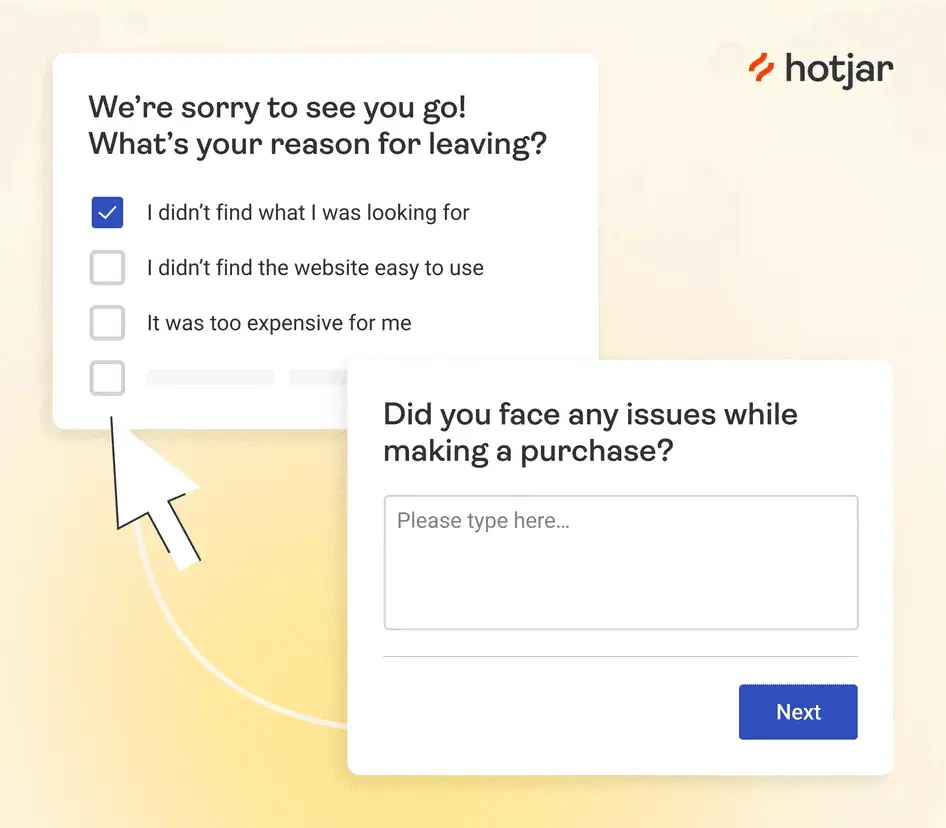
Pro tip: Read customer service transcripts and cart abandonment exit surveys — these firsthand insights tell you exactly where frustration happens.
Don’t have customer service transcripts? Consider implementing them. Additionally, talk to your customer service reps — they’ll have great insights into common problems and themes that might not always be apparent in the data.
Step 7: Develop solutions and improvements.
Brainstorm ways to remove friction and optimize each stage of the journey. This could include:
- Improving website navigation.
- Personalizing email sequences.
- Reducing checkout steps.
- Offering live chat support.
Pro tip: Not everything has to be go-big-or-go-home. Small adjustments — like a single line of updated UX copy or added social proof — can have a big impact on conversions and retention.
By aiming for quick wins, you can get results quickly without investing a ton of time or effort into the process.
Step 8: Implement and test changes.
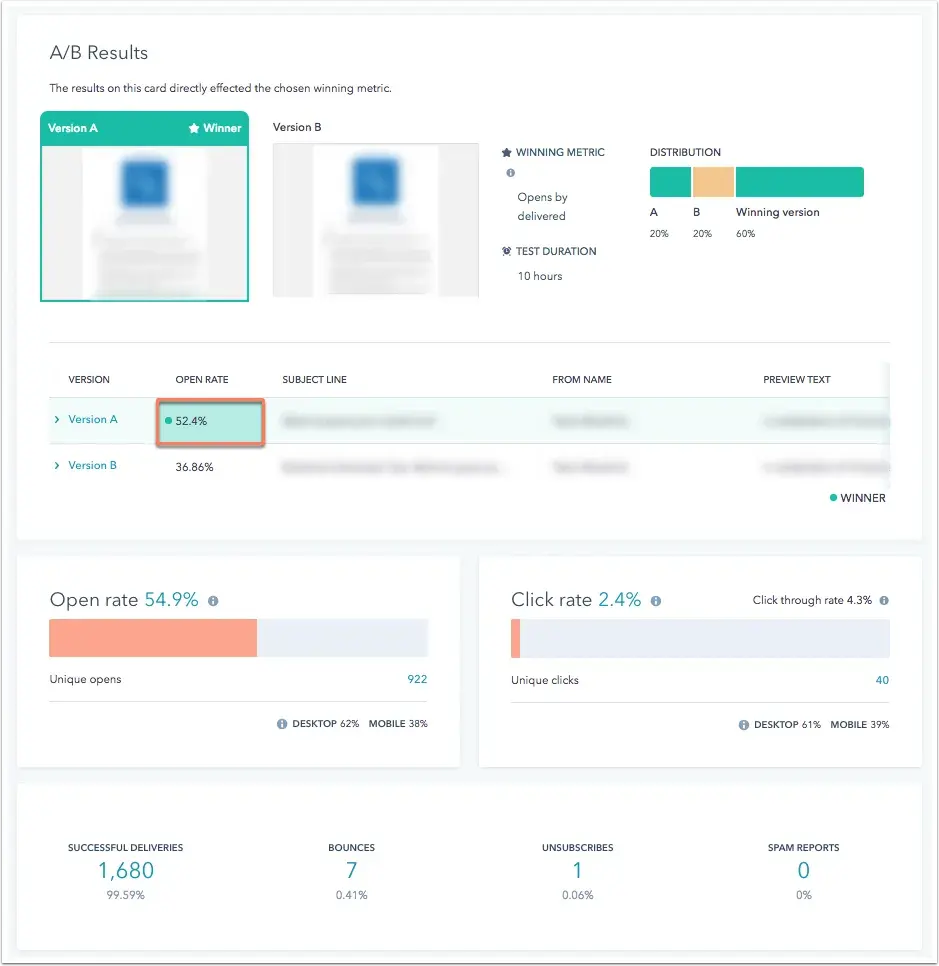
Source
Put your proposed solutions into action. This might involve adjusting website UX, refining ad targeting, or updating onboarding emails. A/B testing can help determine what works best for your audience.
Pro tip: Test one change at a time. If you adjust multiple things at once, you won’t know which one had the biggest impact.
Step 9: Track and continuously update.
Customer behaviors evolve, and so should your journey map. Continuously monitor key metrics, such as:
- Bounce rates & conversion rates.
- Customer feedback & reviews.
- Repeat purchase behavior.
I recommend revisiting your customer journey map on a quarterly basis to ensure that you’re prioritizing the right things and that it’s still accurate. If you don’t get to it quarterly, aim for at least twice a year. Things shift quickly and it’s important to keep up with your customers’ expectations.
Pro tip: Set a check-in reminder on your calendar.
Creating the Best Ecommerce Customer Journey Possible
Mapping your ecommerce customer journey is vital for targeting the right audience and ensuring a great customer experience. Happy customers typically stick around longer and attract more buyers.
I’ve found the best online shopping experiences result from understanding how customers go through the buying stages. Although the ecommerce shopping cycle is swift, customers still interact with multiple touchpoints before they buy, so you must plan carefully.
As a marketer, I rely on data, templates, and proven strategies to optimize each stage of the ecommerce customer journey. Delighting customers, creating a sense of urgency, asking for feedback, showing off happy customers, and personalizing experiences are all proven ways to generate desirable results.
In the end, an accurate map of how customers experience your online shop helps you attract more buyers, keep them coming back, and get them talking about your brand.
Ready to start? Look below for free templates to map your ecommerce customer journey.
Editor’s note: This post was originally published in April 2021 and has been updated for comprehensiveness.


Brand Building Brilliance from Best Buddies
Before this week’s master found her path to the nonprofit sector, she worked with big brands like Pepsi, Frito-Lay, and FedEx. And even founded her own small business clothing line.
Before this week’s master found her path to the nonprofit sector, she worked with big brands like Pepsi, Frito-Lay, and FedEx. And even founded her own small business clothing line.
Now, she leads communications and partner engagement for state development initiatives for Best Buddies International, a nonprofit dedicated to ending the social, physical, and economic isolation of people with intellectual and developmental disabilities.
And her rare marriage of small business, agency, enterprise, and nonprofit experience has led to some of the best advice on brand presence that I’ve encountered yet.

Lise Lozelle
Sr. Director of State Communications & Engagement, Best Buddies International
- Fun fact: Fly fishing is her reset button. When everything slows down, the best ideas show up. She even launched her own fly fishing clothing line, Maven Fly.
- Claim to fame: Lise’s personal startup brand launched a fashion-inspired made-in-the-USA women’s fishing shirt for $125. People said it would never sell at that price. A year later, the big brands raised prices and elevated their style, proving that small brands can create a ripple effect.
Lesson 1: You don’t marry someone on the first date.
What’s the first tactic that comes to mind when you imagine nonprofit marketing?
My first thought was, “Oh no, they’re going to ask me for money.” That’s not only wrong but, ironically, not very charitable.
Lise Lozelle shuts that myth down in no uncertain terms. And pay attention, you for-profit marketers; this advice is for you, too.
“You don’t marry someone on the first date,” Lozelle laughs. “If you want someone to give money to you, you need to make them feel good about it first.”
In practice, that means the majority of Best Buddies’ marketing efforts focus on brand building, not solicitation.
“Let’s build a relationship with people and give them bite-size pieces of how they can learn about your organization.”
Even here at Masters in Marketing, we make sure that you get a certain number of educational emails before you ever see a marketing blast.
So slow it down. Wine and dine ’em first. Make your prospects fall in love with your brand before you pop the question: “Will you make me the happiest marketer in the world and click this CTA?”

Lesson 2: Stand for something. (But do it authentically.)
“What brands can learn from nonprofits is that you have to stand for something. Especially with this next generation,” Lozelle says. “Your consumers want to know what your company does to make the world better.”
And the data proves her point. HubSpot research shows that 82% of consumers want to buy from brands that share their values — and that number climbs still higher for Gen Z.
“Brands that don’t understand that are going to feel some pain from this next generation.”
As a marketer, you may not control your company’s values, but you do shape how those values are presented to your audience.
This doesn’t have to be big. Maybe you share how you use only compostable packaging. Maybe your social account proudly shows employees on volunteer days. Maybe your ads feature a diverse cast of models.
But you do have to walk the walk. The internet is rife with brands being punished for performative activism. (Take a second to google “charity washing,” “greenwashing,” or “rainbow washing.”)
“Make sure your brand ethos aligns with your brand personality,” Lozelle cautions. “When those are at odds, the market will tell you.”

Lesson 3: Let people tell their story.
“There is so much clutter — just in general, but certainly in the nonprofit space — in terms of asks and messaging.”
The people you’re trying to reach are swimming in calls to action. How does any brand cut through, for-profit or non?
“For us, it’s about letting the participants tell their stories,” Lozelle says. “Connecting people directly to the work that we do, as opposed to me as a marketer telling that story.”
When you’re floating in that sea of slick, beautifully crafted brand stories… sometimes it’s the raw truth that stands out.
Lozelle gives the example of BBI’s global ambassador, Flava Fran — the self-described “autistic rapping Jew.”
“People love her. And, as an organization, we’ve been able to give her a stage and a platform,” Lozelle explains. “That seems to break through in a different way than someone who works for the organization or even a celebrity endorsement.”
Now, I recognize we’re not all lucky enough to have a rap phenom on our side. But chances are you can think of at least one happy customer who will sing your praises.
Lingering Questions
This Week’s Question
What’s the most underrated marketing channel right now, and why do you think it deserves more attention? — Kevin Indig, Growth Advisor for Hims, Reddit, Dropbox, and Snap Inc
This Week’s Answer
Lozelle says: “For me, the current most underrated marketing channel is Direct Mail. A well-designed print piece can break through the clutter and make an impact.
People save postcards from favorite nonprofits that capture a mission moment, connecting them to the cause. They earmark pages in a well-designed catalog of products they covet and are incentivized to purchase with direct mail pieces that feel curated and personal.
Pro Tip: Mail isn’t dead — ask Gen Z. According to a USPS survey, 72% of digital natives get excited about good old-fashioned mail. Give them something to hold on to.”
Next Week’s Question
Lozelle asks: As a marketing thought leader, how do you see AI influencing strategic thinking and the creative process in brand building?


Stop Measuring These Vanity Metrics in Your Marketing Campaign
In 2021, I was put in charge of a literary blog’s marketing campaign. The blog was racking up page views, yet none of those visits were turning into product sales. It felt frustrating watching the numbers climb without any real impact.
In 2021, I was put in charge of a literary blog’s marketing campaign. The blog was racking up page views, yet none of those visits were turning into product sales. It felt frustrating watching the numbers climb without any real impact.
After about three months, I realized that I was chasing a vanity metric (page views) that looked impressive but ultimately did nothing to move the needle. So, I shifted my attention to more meaningful metrics like engagement rate, click-throughs on calls-to-action, and conversion rates from visitors to subscribers/buyers.
This required me to tweak the content strategy quite a bit, but soon, the results began to speak for themselves. In this article, I’ll be covering what a vanity metric is, how to identify them, some examples of vanity metrics (and their alternative actionable metrics).
Table of Contents
I learned about vanity metrics the hard way with the literary blog. It was annoying to realize that chasing these shiny numbers meant that my marketing efforts were going down the drain and we were losing money. But the moment I focused on actionable metrics (and key performance indicators (KPIs)) instead, those sales slowly, but steadily, started pouring in.
Beware of vanity metrics. Instead of getting caught up in the low-hanging fruit, ask yourself: “What does this graph mean? Should I continue doing something, increase the time or money I spend on a certain channel, or even stop doing something altogether?”
Vanity Metrics vs. Actionable Metrics
As I said before, vanity metrics refer to data points that may look impressive at first glance but do not provide meaningful insights into a business’s actual performance.
Actionable metrics are the opposite–these metrics directly tie into business objectives and offer insights that drive strategy and decision-making.
Here’s a table that shows the key differences between vanity metrics and actionable metrics
Vanity metrics
Actionable metrics
Examples
Examples of vanity metrics include page views, social media followers, and email open rate.
Examples of actionable metrics include conversion rates, click-through rates, and customer retention figures.
Relationship to goals
They do not directly correlate with business outcomes and may not indicate progress toward goals.
They are closely tied to specific business objectives and measure progress towards achieving them.
Insights provided
They offer superficial insight that can be misleading without context.
They offer clear, measurable insights that help shape effective marketing strategies.
Impact on decision-making
Decisions based on vanity metrics may lead to misdirected efforts and inefficient resource allocation.
Decisions based on actionable metrics lead to more effective strategies and optimized resource use.
Reliability
Vanity metrics can be unreliable because they do not reflect the quality of engagement or conversion.
Actionable metrics reliably reflect the quality of engagement and can pinpoint areas for improvement.
Examples of Vanity Metrics (+ Alternative Actionable Metrics)
Here are seven vanity metrics you should stop obsessing over and the actionable metrics you should track instead.
1. Blog Post Page Views
Blog post page views simply count how many times a page is loaded. It feels great when the numbers are high, like they were with the literary blog–I mean, 50k page views every month is a lot–but it doesn’t show if visitors actually read the post or took the next step. In my case, visitors certainly weren’t clicking the Purchase button.
Page views also don’t indicate where your visitors are coming from, if your blog content answered their question, or even how long they spent on your page.
Actionable Metrics: Bounce Rate, Social Shares
- Bounce rate: This tells the percentage of people who visit one page on your website and leave without clicking further into the site. In other words: high bounce rate = bad. A declining bounce rate is a great metric to report because it suggests that your blog is becoming more interesting to your visitors.
Pro tip: Keep readers’ attention with a good call-to-action (CTA), as well as links to other content and other parts of your site.
- Social shares: People share content on social media that they relate to or resonate with in some capacity. So, if your content is getting lots of social shares, there’s a good chance your content is connecting with your audience, which is what you want.
And while search engines like Google and Bing don’t directly use social shares as a primary ranking factor, shares can indirectly influence SEO by indicating content relevance and quality, which can lead to backlinks and increased traffic.
2. Email Open Rate
Email open rate measures the percentage of recipients who open your emails. Here’s the formula:
Open rate = (Number of emails opened / Number of delivered emails) x 100
Email open rate is a reasonable metric to track to check the effectiveness of your email’s subject line and timing. However, it says nothing about the email’s content or its ability to prompt action. Also, there are technical limitations because many email clients have to load images to count as an open, and many users have images turned off by default.
I’ve seen marketing campaigns where the email open rates were sky-high, yet barely any clicks or conversions followed.
Actionable Metric: Click-through Rate (CTR)
CTR measures the percentage of people who clicked on links within your email. It directly indicates whether your content was compelling enough to prompt further action. A high click-through rate (CTR) for an email that invites users to download something on your website, for example, tells you the email campaign has high lead-generating power.
Pro tip: Focus on one call-to-action (CTA) in your email that draws users to your site, and measure your click-throughs on those links.
3. Number of Subscribers/Product Users
It’s simple enough to track how many people have converted into a trial user, or agreed to receive your newsletter. But these metrics don’t tell you if these people are actively engaging with your content or product. Sometimes, the numbers inflate simply due to outdated sign-ups or inactive users.
Actionable Metrics: Active Users, Path to Conversion
- Active users: Instead of focusing on the total user count, track how many subscribers or users are actually engaging with your content or product on a regular basis.
For example, in Google Analytics, you can examine metrics like New vs. Returning visitors, which measures the percentage of visitors who are new to your website versus those who have visited it before. A higher percentage of returning visitors indicates stronger visitor loyalty and retention.
You can also look at Frequency and Recency in Google Analytics, too–a report that shows how often visitors return to your website and how long it’s been since their last visit.
- Path to conversion: This metric analyzes the journey users take from first contact to conversion, highlighting where you might be losing potential customers. So, track which content drew in leads that converted to qualified contacts or even customers — as well as what actions those leads took on your website before they converted.
You can monitor this information a few ways, such as adding tracking links to your CTAs so you can see where a user came from as they moved through the conversion path. Rinse, lather, repeat.
4. Social Media Follower Count
On platforms like Facebook, Instagram, or X (formerly Twitter), you shouldn’t really focus on the number of followers you have. People often follow accounts for reasons that don’t reflect genuine interest–and I should know, seeing as the Follow button is like a magnet I’m naturally drawn to (I’ll change, I promise).
Some users may follow you because of that one funny video you posted just to switch things up from your otherwise serious content. Others might follow you hoping for a follow-back, and if that doesn’t happen, those numbers quickly drop off.
Actionable Metric: Engagement Rate
This metric measures interactions like likes, comments, and shares relative to your follower count. It provides a more accurate picture of how your audience is engaging with your content, rather than just how many people might have clicked “follow.”
So, if you have 100,000 followers and are only getting 75 likes and four shares per post, then you know something’s wrong somewhere. It could be that your posts aren’t resonating with your audience or they’re not seeing it–or something else entirely.
Then, you can tweak your strategy and take measures to fix the issue.
5. Ad Impressions
I’ll never forget the first time my friend and I ran an Instagram ad for his window blinds business. It was 2020 — we were both green to paid advertising and I was practically buzzing with excitement as we set up the campaign.
The promise of thousands of ad impressions had us feeling like we’d struck gold — after all, more eyes on the ad should mean more business, right? Well, over the 14 days the ad ran, we racked up thousands of impressions, but only two people actually reached out.
That’s when it hit me: ad impressions are flashy, but they don’t necessarily lead to real engagement or sales.
Actionable Metrics: Conversion Rate
We talked about click-through rate (in the email open rate section above), and you should track that if you’re running paid ads because it shows how many people clicked on your ad after seeing it.
But even better, track your conversion rate, which shows how many clicks led to a meaningful action, like a purchase or sign-up.
In my (and my friend’s) case, focusing on CTR and conversion rate would have shown us that while our ad was being seen, it wasn’t truly connecting with our audience. We would’ve paused it and tried to figure out (and fix) the problem.
6. App Downloads
App downloads count how many times your app has been installed. It’s tempting to celebrate a surge in app downloads—after all, those numbers look great on paper. I’ve seen campaigns where the download count skyrocketed right after launch.
But here’s the catch: downloads alone don’t prove that your app is valuable or that users are sticking around. Something’s wrong if your downloads are through the roof and yet barely anyone if using your app after the initial install.
Actionable Metrics: Retention Rate, Daily Active Users (DAU)
- Retention rate: This metric tracks the percentage of users who continue using your app after their first download. A high retention rate means your app is offering long-term value.
- Daily active users (DAU): DAU counts how many unique users interact with your app on a daily basis, giving you a real-time snapshot of its popularity. These metrics are better because they show not just the initial interest but the ongoing relationship between your app and its users.
This ensures that you’re not just racking up downloads but building a loyal user base.
7. Video Views
Video views are often the go-to metric for gauging the success of a video campaign. However, views only tell you that the video was played—they don’t reveal whether viewers watched the whole thing or if it left a lasting impression.
It’s possible for a 10-minute video to rack up hundreds of thousands of views, but have most viewers drop off after the first minute. Their views still count towards video views, but those viewers would likely not be impacted by the video. And if the CTA is at the middle or the end of the video, they won’t see it, let alone act on it.
Actionable Metric: Watch Time Percentage
This metric shows how much of your video viewers actually watch on average. It’s a much clearer indicator of whether your video content is engaging and worth watching. By focusing on watch time, you can fine-tune your content to keep viewers hooked from start to finish, so that your video is not only seen but truly appreciated.
If you need a tool to help you track actionable metrics, look no further than HubSpot Marketing Analytics and Dashboard software. With built-in analytics, detailed reports, and comprehensive dashboards, HubSpot lets you measure the performance of all your marketing campaigns in one place.
How to Identify Vanity Metrics
If you’re not sure how to identify a vanity metric, here are some tips that helped (and could help you, too):
1. Look beyond the surface numbers.
I learned early on that a high number on its own doesn’t tell the whole story. For example, when I saw thousands of page views on our literary blog, it initially felt like a major win. However, I soon realized that these figures were just surface-level and didn’t offer insight into whether those visitors were truly engaged or interested in our products.
This experience taught me to dig deeper and ask, “What does this number really mean for the business?” Instead of just celebrating big numbers, I started analyzing what they were achieving.
2. Check for consistent patterns.
One effective way I identified vanity metrics was by looking at growth patterns. I noticed that while some numbers, like page views, would spike after a viral post, other critical metrics—like demo requests or free trials—remained flat.
Consistency is key. If one metric shows sporadic bursts without any corresponding growth in conversion or engagement, it might be a sign that you’re focusing on vanity numbers rather than sustainable growth.
3. Analyze the relationship between metrics.
I learned to compare related metrics to see if they supported one another. For instance, if there was a surge in social media followers but no increase in website traffic or conversions, that disparity was a clear indicator of a vanity metric.
I would look at how changes in one metric affected another. When the numbers don’t move together as expected—like a rise in likes without a similar rise in comments or shares—it tells me that the engagement might be superficial.
4. Evaluate the quality of engagement.
Not all interactions are created equal. I know now to measure the quality of engagement rather than just counting the interactions. For instance, I compare posts that have numerous likes with those that generate thoughtful comments or were shared widely.
I’ve found that posts with meaningful interactions often led to deeper customer relationships and higher conversions. This approach helped me distinguish between a metric that simply looked good on paper and one that truly drove the business forward.
5. Rely on benchmarking for context.
I found comparing metrics to industry benchmarks and past performance provides valuable context. For example, if your blog’s conversion rate is significantly lower than the industry average despite high traffic numbers, then you need to re-evaluate your strategy.
Benchmarking helps you set realistic targets and better understand which metrics are truly driving success. This context is crucial for distinguishing between metrics that merely look good and those that are genuinely effective.
Transform Data Into Impactful Strategies
Vanity metrics may dazzle at first glance, but they don’t provide the insights needed to drive true business growth. By focusing on actionable metrics—like click-through rates, conversion rates, retention rates, and watch time percentages—you can uncover what’s really working and identify areas for improvement.
Editor’s note: This post was originally published in August 2011 and has been updated for comprehensiveness.


LinkedIn Leads: Secrets from a LinkedIn Marketing VP
Welcome to HubSpot’s Expert Edge Series, where we interview top execs at major brands to explore their perspectives on the latest trends, challenges, and opportunities shaping the industry.
Welcome to HubSpot’s Expert Edge Series, where we interview top execs at major brands to explore their perspectives on the latest trends, challenges, and opportunities shaping the industry.
Audiences exposed to brand messages on LinkedIn are — wait for it — six times more likely to convert. And according to Statista, marketers ranked it the third-most important social media platform, behind Facebook and Instagram.
When it comes to actually generating those LinkedIn leads, you need a clear strategy. So I sat down with Jim Habig, who spent two years as LinkedIn’s marketing VP, and asked him to spill his secrets to using the social platform. His most surprising advice? Your company’s top execs are key to everyday LinkedIn success.
Table of Contents
- LinkedIn Lead Generation Strategy
- The Most Effective Content for Generating Leads on LinkedIn, According to LinkedIn’s VP of Marketing
- What Marketers Get Wrong When It Comes to LinkedIn for Lead Gen
LinkedIn Lead Generation Strategy
Lead generation refers to all the activities and strategies you use to attract potential customers. Generating leads is important because, with nurturing, potential customers can become paying customers that use your products and drive revenue.
LinkedIn’s typical audience comprises professional decision-makers with purchasing power, helping you speak directly to potential customers who can become paying customers. Below, I’ll discuss how you can use LinkedIn for lead generation.
1. Make sure your executives have a strong LinkedIn presence.
When you’re first getting started on LinkedIn, it can be tricky to know how to dedicate your initial efforts. Should you create a compelling LinkedIn page and immediately post content to your business’s feed? Or should you start by posting job openings to attract new talent?
Habig agrees that optimizing your company page is critical to making a strong first impression. He encourages marketers to ensure their page is complete and up-to-date with relevant information like a business description, logo, website URL, and industry.
However, an often overlooked opportunity to generate leads falls on individual employees’ pages.
As Habig puts it, “You’ll want to encourage your leadership teams and employees to have well-crafted personal profiles with professional headshots, descriptive headlines, and detailed job experiences.”

He adds, “A consistent brand presence builds credibility, attracts the right audience, and fosters trust among potential leads.”
Samantha Meller, HubSpot’s head of social media, audience development, agrees. “I strongly believe that people want to follow people,” she says. Even on LinkedIn, a platform more associated with business than pleasure, she says that users “don’t want to follow a brand. They want to see personality.”

Consider the leaders at your company and their current LinkedIn presence. Could they contribute more thoughtfully to LinkedIn groups within your industry or post more often to their feeds? More likely than not, your executives could be doing more to grow their LinkedIn following.
For instance, let’s take a look at a LinkedIn post from HubSpot CEO Yamini Rangan:
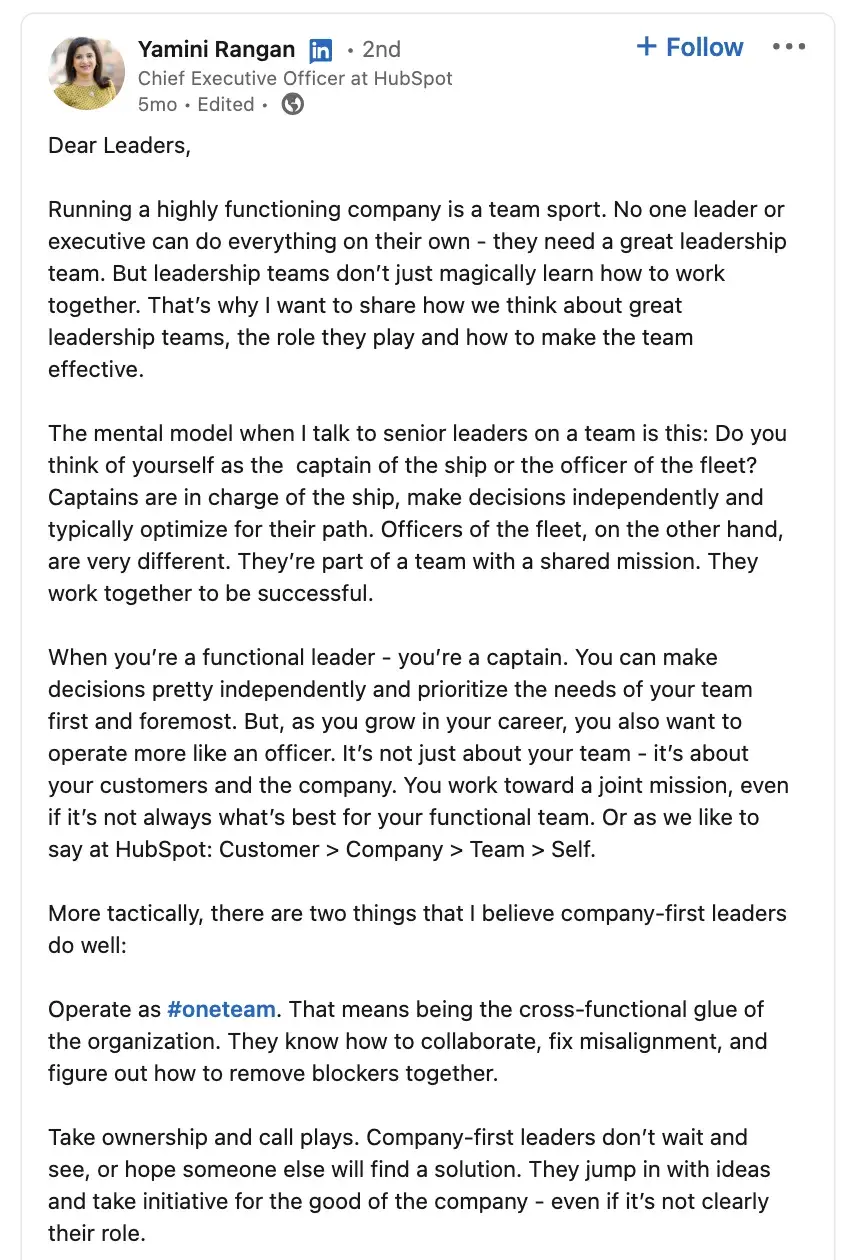
Rangan uses LinkedIn wisely, leveraging the platform to share helpful, relevant content for business leaders. I especially like that she builds a personal brand and helps her followers find valuable content related to business growth. Ideally, your executives should be doing the same.
2. Create a powerful LinkedIn Page for your business.
LinkedIn Pages is a free product that can help your company build visibility on the platform. I recommend using it to house your brand’s thought leadership content, such as videos, commentary from executives, and curated information from other sources.
You’ll also want to ensure your page is active with thought-provoking content and contributions to conversations already happening on LinkedIn.
Take a look at 10 Best Practices for Creating (and Growing) LinkedIn Pages to learn more.
3. Post relevant content and engage with your audience.
To ensure your LinkedIn page and profile are strong, consider posting various content types, including video. Featuring this industry-relevant content helps you position yourself as a knowledgeable source and establish relevance and credibility with potential customers. I talk more about the best types of content to post on LinkedIn here.
As Habig puts it, “Creating and sharing high-quality content tailored to your target audience’s interests is key to driving engagement and generating leads. Share a mix of content types — like blog posts, infographics, case studies, and videos to keep your audience engaged.”
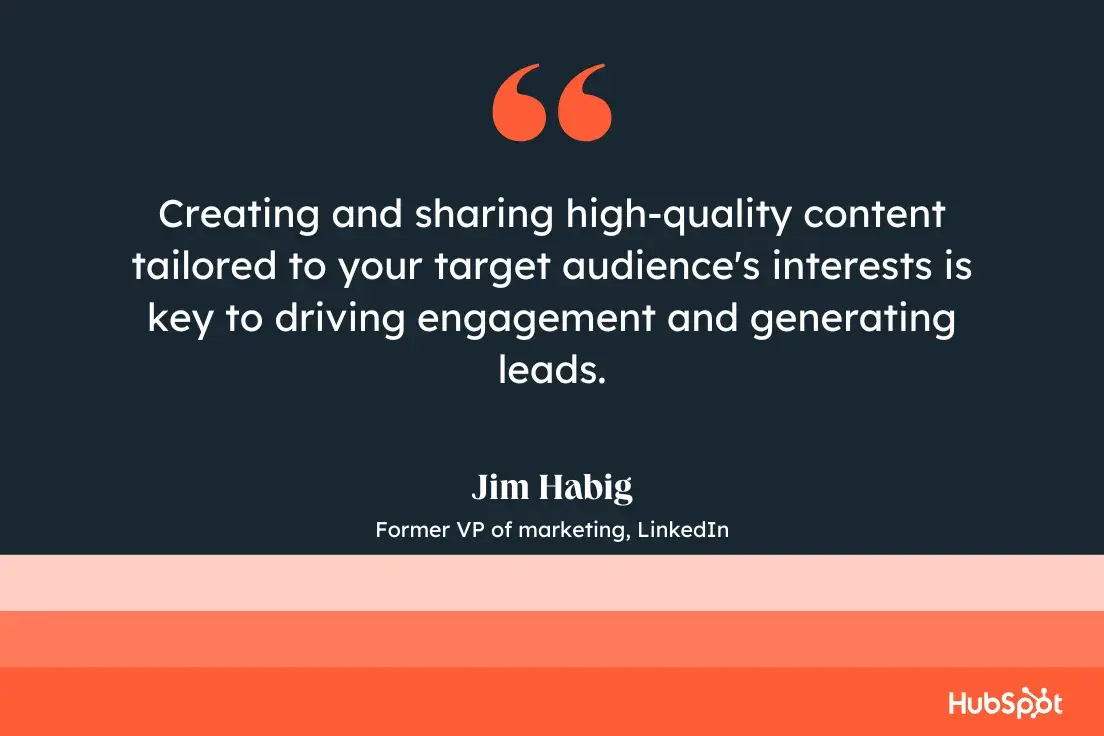
He continues, “And don’t forget to join the conversation! Proactively respond to comments and answer questions to foster relationships with your audience and showcase your expertise.”
When you’re recognized as an insightful, valuable source, you’ll begin to develop connections with like-minded professionals that fit your ideal customer profile. If you post often, you’ll become a regular on their feed, and familiarity makes it easier to initiate further conversations.
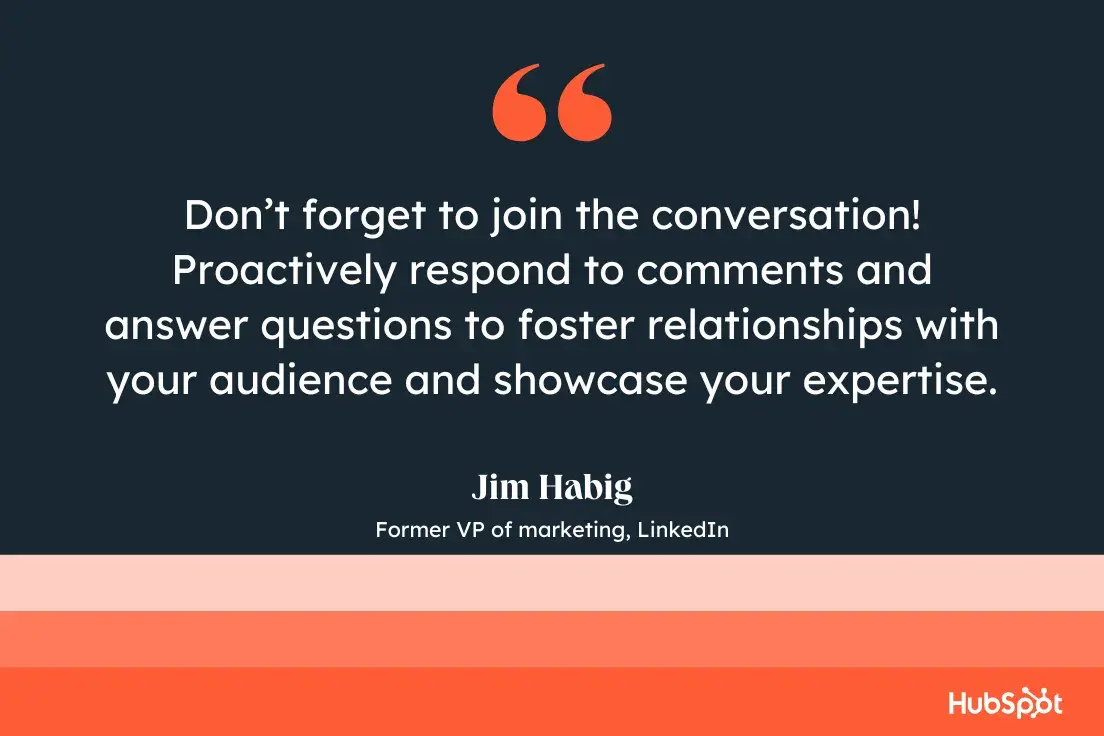
The communities you build and engage with are essential, as social media marketers told us that the biggest benefit to building a social media community is an increase in brand awareness. Growing brand awareness = new eyes on your business, new eyes = potential new leads.
For example, if all of my LinkedIn connections are professionals within my industry, they can expose me to new audiences with the content I post. If someone clicks “Like” on a post I’ve made, it may show up on the feed of a new lead. The lead can see that our shared connection liked my post, which vouches for my credibility and authority, possibly prompting them to send a request to connect (a new lead!).
Follow your page analytics to figure out what resonates with your audience and ensure you create content people want to see.
4. Join LinkedIn groups your clients and customers are in.
LinkedIn, at its core, is a social platform like any other. Just as on Facebook, users can create groups centered around industry-relevant interests, and I recommend joining these groups and having conversations with other professionals.
You can stay informed by exporting LinkedIn comments, then posting content and updates to encourage discussions about relevant topics. Or simply talk about the services you offer — if you’ve joined groups wisely, your potential customers can see what you say and begin to recognize you as a source of valuable information.
You can also use groups to learn more about your audience. If members are active, learn from what they say and discover common industry pain points and how leads want these issues addressed. Use this information to your advantage, and create hyper-targeted value propositions when you reach out that speak directly to your customer’s needs.
5. Use LinkedIn Ads and Sponsored Content to ensure your content reaches your intended audience.
Since LinkedIn is the top paid and organic channel for B2B businesses, spending your money on the platform would be worthwhile. But, if you have a smaller marketing budget, I understand being wary of putting money behind paid campaigns on LinkedIn.
Habig suggests: “Consider using LinkedIn’s advertising and sponsored content solutions to reach the right audience based on factors like job title, industry, and company size.”
He adds, “You’ll want to utilize sponsored content to promote your top-performing posts or lead generation forms to capture valuable lead information. Try testing various ad formats like sponsored InMail, carousel ads, and lead gen forms to identify which works best for your target audience.”
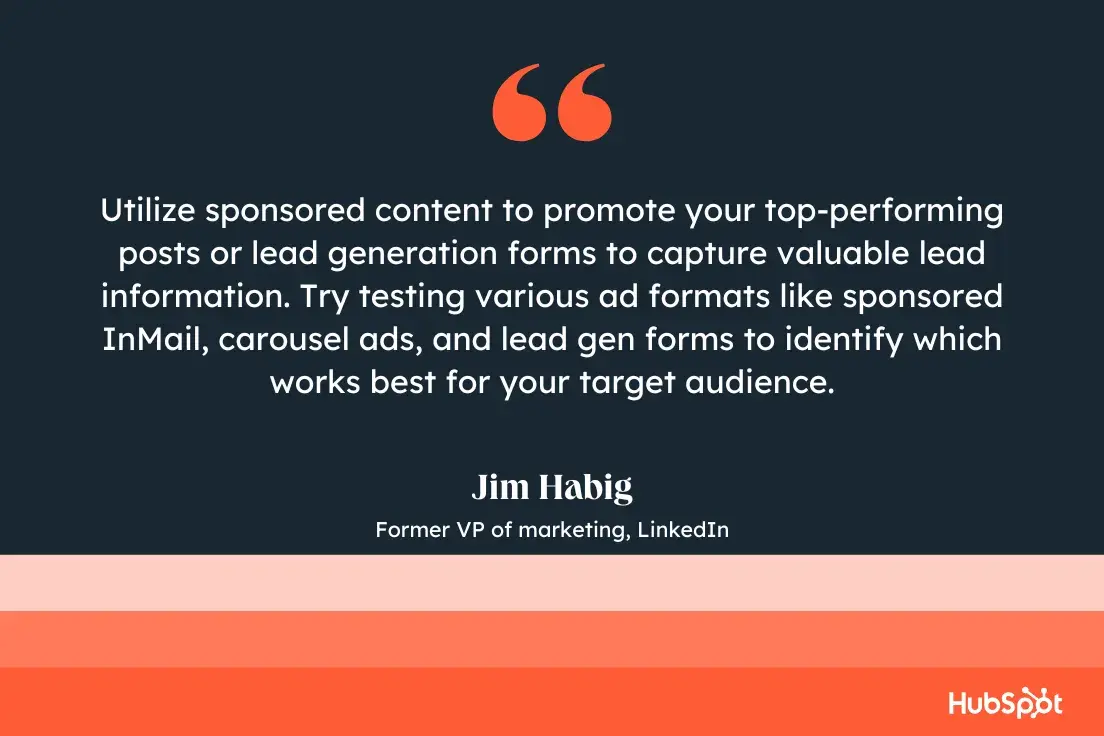
In particular, Habig believes the LinkedIn Lead Gen Forms is one of the platform’s most powerful offerings for lead generation.
He told me, “LinkedIn Lead Gen Forms streamline lead generation by auto-populating users’ LinkedIn profile information when they click on your ad. This simplifies the process for users, allowing them to submit their information with ease and boosting lead generation efficiency. Furthermore, the collected data can be effortlessly synchronized with your CRM system.”
I also recommend using other free native content features that can help you increase your engagement with your audience, like articles and polls. You can even automate a lot of this process by using a LinkedIn bot.
While LinkedIn has a native ads management service, you can also use HubSpot’s ads management tool to create, organize, and execute advertising campaigns on LinkedIn. You’ll also get access to high-quality reports that explain ad performance, helping you optimize a strategy to meet your customers’ needs.
6. Ensure you have strong sales and marketing alignment.
You’re likely all too familiar with the recent shift in consumer buying behavior. Nowadays, customers are researching online ahead of time and typically use marketing content to inform their purchasing decisions before even reaching out to a sales rep. What’s more, the top reason consumers use LinkedIn is to learn new things.
So, with these savvier consumers, it is now critical that marketers meet the needs of consumers who are further along the buyer‘s journey and then seamlessly hand them off to sales so sales have the context on which stage of the buyer’s journey the consumer is at.
This is where I have to call out the importance of sales and marketing alignment. Every time we run our Marketing Trends Survey, we hear about the importance of sales and marketing alignment. These teams working together contribute to higher lead quality, more closed deals, and a 107% higher likelihood of goal attainment.
Many salespeople know the target audience better than anyone, so leveraging their knowledge when creating marketing materials is vital. To figure out strategies for better aligning your sales and marketing departments, get more expert advice: How to Create Strong Sales and Marketing Alignment, According to LinkedIn’s Global Product Marketing Leader.
7. Leverage connections with current customers and clients.
LinkedIn’s main draw is networking, and you should use this feature to your advantage for lead generation.
Connect with current customers and clients on LinkedIn and learn from who their industry connections are, as they may be relevant to you as well. If you have relationships with existing clients, ask for referrals and references, or simply learn how to get in contact with a connection they have that matches your customer profile.
LinkedIn is a professional network, so such requests are less pushy, spammy, and sales-esque than cold calling someone after finding their number online. Leads can receive your request to connect, browse your profile, and see your shared connection as a guarantee of trust.
In addition, when you connect with new leads, you use warm outreach. This means that you already know a bit about them and can immediately make propositions that relate to their interests, providing value to them off the bat.
8. Maintain a consistent presence on the platform.
Just like all of your other social media sites, LinkedIn requires consistency. If I post one article a week and log out, I’m not establishing myself as a consistent presence with my connections.
Aside from the content you share, you want to communicate consistently with your leads. Disappearing in the middle of a conversation is not a good look and does the opposite of furthering their interest in doing business with you.
Additionally, to ensure you’re reaching the right audiences, consider leveraging LinkedIn Matched Audiences to retarget website visitors.
Habig says, “LinkedIn offers advanced targeting capabilities to help you connect with your ideal audience. With LinkedIn Matched Audiences, you can retarget website visitors, create contact-based audiences using email lists or CRM data, or build account-based audiences by targeting specific companies. This feature enables you to engage people who have already shown interest in your business or are more likely to be interested.”
He adds, “For newcomers to LinkedIn or those seeking guidance on setting up targeting, consider using LinkedIn’s pre-built audience templates. These templates simplify the process and cater to various audiences, such as doctors, recent college graduates, millennials, and more.”
As I mentioned above, use platform analytics to learn about your audience’s interests and when your posts get the most traction, and create a strategy that will keep you consistently present and visible on LinkedIn. Then, try to make scaling easier with different strategies and LinkedIn automation tools.
The Most Effective Content for Generating Leads on LinkedIn, According to LinkedIn’s VP of Marketing
When asked which content Habig believes performs best on LinkedIn when it comes to generating leads, Habig told me two types of content typically win out: educational and thought leadership.
He said, “There’s a delicate balance between offering what I’ll call practical content geared towards the practitioners and presenting forward-thinking thought leadership. Both are essential for capturing the attention of your prospects and customers.”
Habig continues, “Providing educational content — such as how-to guides, case studies, whitepapers, and e-books — positions your brand as a ‘helpful teammate’ that your audience can rely on for support and expertise.”
You don’t want to ignore the potential power of thought leadership, either.
Habig says, “It‘s crucial to incorporate thought leadership, demonstrating that you’re in tune with the industry’s trajectory.”
According to research conducted in collaboration with Edelman, nearly three-quarters (73%) of decision-makers say that an organization’s thought leadership content is a more trustworthy basis for assessing its capabilities and competencies than its marketing materials and product sheets.
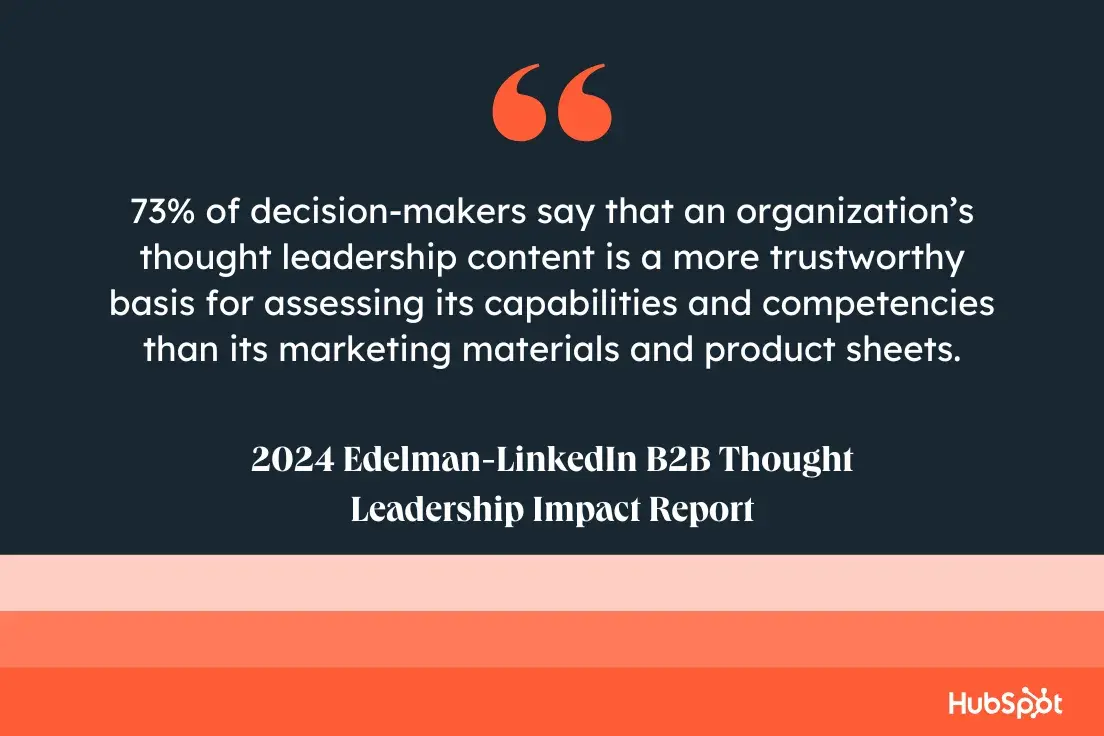
I always recommend prioritizing your own content analytics to see what performs best with your audience, but testing and experimenting is a good practice. Try Habig’s recommended formats — if you haven’t already — and see how they do.
What Marketers Get Wrong When It Comes to LinkedIn for Lead Gen
Finally, I had to ask: What is the biggest mistake marketers make when it comes to LinkedIn lead gen strategies?
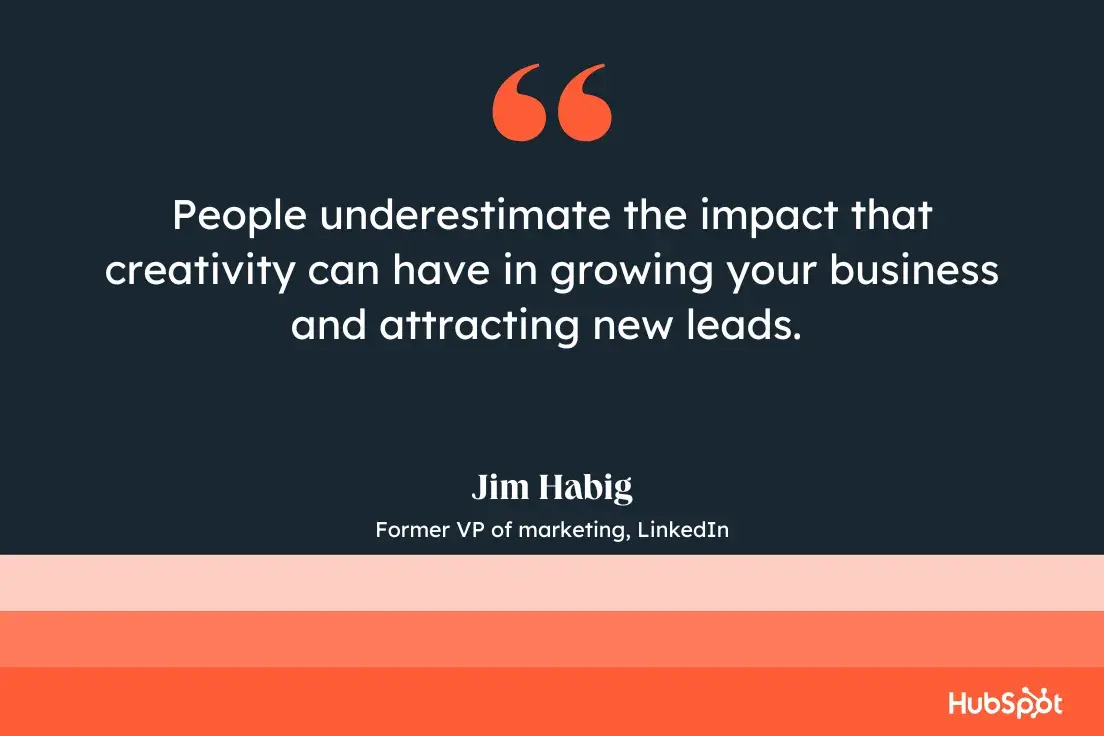
Habig had a straightforward answer:
“People underestimate the impact that creativity can have in growing your business and attracting new leads. In a recent report, we found that 69% of people said B2B purchasing is just as emotionally driven as B2C. Creativity is a powerful way for businesses to build their brands, differentiate themselves, and tell compelling stories about the problems they’re solving that will pique the interest of their audience.”
Which is good news for most marketers — who likely got into marketing for the storytelling in the first place.
Editor’s note: This post was originally published in October 2019 and has been updated for comprehensiveness.


Using AI to Get Your Business Branding Right — My Favorite Tips and Tools
I grew up a Nintendo kid (and yes, that includes the original NES console and Duck Hunt Zapper). For those who remember the Nintendo GameCube, you know a memorable brand experience. How could anyone forget this nine-second clip of branding brilliance?
I grew up a Nintendo kid (and yes, that includes the original NES console and Duck Hunt Zapper). For those who remember the Nintendo GameCube, you know a memorable brand experience. How could anyone forget this nine-second clip of branding brilliance?
Whenever I think of “branding,” I go back to my memory of the GameCube boot-up screen and the feelings of joy and anticipation it evokes. That makes a brand work — the experience behind the logo. But getting your brand experience right is incredibly hard for any marketing team. Logos, visual identities, copy, websites, social media — “brand” requires tons of attention and work.
So, I’m always on the lookout for ways to build a brand stronger, faster, and better than before. And AI tools for branding have come a long way these past few years to enable more sophisticated brand identity creation and growth.
Let’s look at AI for branding as it stands today and how your team can start building a memorable brand that clicks with consumers.
Table of Contents
- AI for Branding
- Why use AI tools for branding?
- Types of Branding Tools with AI
- Best AI Tools for Branding
AI for Branding
Brand building isn’t just making logos. You need strategy, consistency, and scalability to reach your audiences and grow your impact. Welcome to AI’s biggest role within marketing teams in 2025.
Marketers have toyed with AI for several years. That tracks with what McKinsey has found: Most AI adoption has happened at the individual contributor level (i.e., the social media manager whipping up posts).
But, AI is showing the potential for greater strategic business value. As 2025 unfolds, I believe we’ll see a shift in tool adoption, from ICs experimenting with ChatGPT to deeper integration into everyday workflows.
The Marketing Artificial Intelligence Institute recently found that 36% of marketers have infused AI into their daily workflows. Its research also showed a profound shift from marketers just “experimenting” with AI to actually implementing it in their everyday work.
Marketers deploying AI are seeing better results across their bodies of work. SurveyMonkey’s latest AI survey found that, of the marketers using AI:
- 93% use it to generate content faster.
- 81% use it to uncover insights more quickly.
- 90% use it for faster decision-making.
Our research shows that four out of ten marketers are using AI to write copy and outlines for long-form content. They’re also using AI to learn how to do things — not just research for articles but tutorials on writing better content or using tools more effectively.
In 2025, I think we’ll see AI become the marketing team’s branding copilot.
Teams are using AI for content support and customer experience personalization already. AI in content marketing is helping to define and scale brand identities while keeping everything on-brand and consistent. AI’s role will expand, provided marketing teams better structure their internal data architectures and continue investing in AI education and training.
But that copilot piece matters. You shouldn’t concede all branding decisions to an AI partner. Instead, the best-performing marketers will learn to operate alongside their AI branding tools, leaning on its strengths while keeping human creativity and ingenuity at the heart of their brand.
Pro tip: How else are marketers using AI across their organizations? Download our AI Trends for Marketers report for more.
Why use AI tools for branding?
While AI tools for branding can bring many benefits, AI is like any other tool. You need to know how, when, where, and why to use it. You wouldn’t use a hammer to drive a screw into a wall; likewise, AI used without planning and intention can stymie or even damage your brand.
Efficiency and Authenticity
Most talk around AI adoption focuses on efficiency gains — get more, faster, with your team. Rosier predictions from McKinsey show the potential for saving 60-70% of an employee’s time with AI tools. While efficiency is certainly part of the benefit, I don’t think efficiency alone is sufficient, especially with branding needs.
Garin Hobbs, Martech Expert at InboxArmy, agrees. “AI pushes branding toward efficiency, but efficiency without intent weakens identity. I can’t even count how many companies plug AI into content creation and label it innovation, yet the output lacks depth.”
Hobbs continues by sharing how an AI tool’s thoughtful application helped his company. “In my experience, AI works best analyzing customer sentiment at scale, then feeding those insights back into brand messaging,” he said.
“Here‘s my favorite tactic: instead of letting AI write entire emails, I used it to identify specific phrases customers responded to in previous campaigns. Weaving those into fresh copy led to a 19% higher conversion rate. We were shocked — it actually worked! AI shouldn’t replace creative instincts — it should reveal patterns that inform smarter human decisions.”
A branding AI tool doesn’t replace creativity (or creative talent). It supports their efforts while buying back their time and effort.
Hyper-Personalization of Content
Personalizing your marketing content is a bare minimum. Everyone knows “Hi, Alex!” in your email is a first name field.
Now, we’re looking at hyper-personalization, which involves understanding a buyer’s individual behaviors and preferences and changing content to match. These highly customized experiences can reduce customer acquisition costs by as much as 50% and increase marketing ROI by 10-30%.
But, there’s no easy way any marketing team could hyper-personalize at a meaningful scale. Enter an AI branding tool.
However, before you turn your AI loose, give it the structure for personalization at scale while keeping things authentic. Tristan Harris, Sr. VP of Marketing at Next Net Media, shares more.
“For businesses navigating this balance, conduct a brand touchpoint audit identifying moments of genuine differentiation versus functional interactions — this reveals where AI implementation preserves rather than dilutes authenticity,” he said. “The most effective approach I’ve seen connects authentic human expertise with AI-driven personalization at scale rather than choosing between them.”
Harris also points to the importance of voice in this process: “Create clear AI usage guidelines for customer-facing content that specify which brand elements must remain human-crafted, preventing the subtle voice erosion that has damaged many well-intentioned automation efforts.”
Brand Consistency at Scale
Harvard Business Review reports a well-defined brand strategy, with consistency across every touchpoint, can drive 10-20% increases in annual revenue. A branding AI tool is basically purpose-built to protect consistency wherever your brand appears.
But, as Nirmal Gyanwali, Founder & CMO and WP Creative, notes, the buck does not stop at the AI tool.
“We‘ve had to be intentional about how we integrate AI. It’s incredibly useful for tasks like generating content outlines, analyzing customer sentiment, helping us spot patterns we might have missed,” he said. “But when it comes to storytelling and brand voice, that’s all human.”
Balancing the human aspect of a brand while staying consistent is a high-wire act that involves putting faith in your team to represent you well.
“I‘ve learned that you can’t just set an AI tool loose and expect it to build authentic connections,” Gyanwali said. “AI needs a human filter. We‘ve built brand guidelines into our AI tools, but we also trust our team to step in and say, ‘That doesn’t sound like us.’ It’s about working with AI, not letting it take over.”
Types of Branding Tools with AI
“Branding” can be a busy word — a lot goes into building and growing your company’s brand. And AI tools often only solve particular branding problems. Let’s talk about the most common branding tools you’ll come across and how AI integrates to help you get the job done.
Logo and Visual Identity Creation
A brand’s look is typically the first thing a potential customer sees. And, when you get it right, the memory can stick forever. You can probably picture the Nike Swoosh or McDonald’s Arches right now, can’t you?
If you want to design that kind of memory, you might want help from an AI-powered logo maker. These tools use functions similar to text generation to create logos based on your preferences, similar industry brands, and desired color schemes.
Now, the Swoosh is famous because it’s the same everywhere. AI logo makers also typically offer full brand kits with fonts, color palettes, and social media assets. You can maintain a cohesive visual identity as you build your brand.
Website and Landing Page Builders
Your website is still an important part of making your first impression on a customer. And what an impression it has to be: Studies show you have 50 milliseconds to make that first impression. That’s as fast as a gearshift on a Lamborghini. How can you possibly appeal to users that quickly?
AI-driven website builders can help you make that powerful first impression.
These tools can generate copy and visuals, but their real benefit is in design suggestions. You can use AI’s data repository to pick the best-performing designs, improve layouts, and optimize your user experience to nab their attention and keep them scrolling. Some tools are even adding integrated chatbots and dynamic personalization for even better engagement.
Pro tip: Use HubSpot’s CMS platform to build and manage your website using AI. Start by generating a free AI website.
Copywriting and Brand Messaging
My writer’s heart needed time to get comfortable having AI perched on my shoulder, the stochastic parrot it may be. However, time and practice have shown me how these AI-powered writing assistants can, well, assist.
Copywriting tools can generate headlines, product descriptions, email campaigns, SMS text, and social media posts — anywhere you need words. In particular, I’ve found value in AI as a brand messaging amplifier. It’s great at repurposing long-form content into more digestible chunks, which can help you reach more people without writing the same sentence dozens of times.
Branding Research and Competitive Analysis
Marketers need to crunch data to find better ideas and drive stronger results. But, I’d venture to guess many marketers did not choose their field to conduct deep statistical analyses. And, with so much data popping into existence (over 400 million terabytes of data globally every day), it’s impossible for marketers to keep pace.
Branding research AI tools help you analyze competitors, track brand sentiment, and identify consumer trends to keep your brand strategy sharp. These tools review that mess of data using machine learning and natural language processing, scanning online conversations, social media mentions, and industry reports to get the good stuff.
The models then crunch that information into insights, generated in real time and with useful context. You can get ahead of market shifts and adjust your brand positioning and messaging accordingly.
Social Media and Content Creation
I’ve heard, “Can you turn this into a Facebook post?” more times than I can count. While forcing brevity can elicit creativity, writing endless posts can drain any marketing team. And, as social media platforms shift their audiences and best practices, you could use help keeping pace.
AI-powered social media tools can generate posts, captions, pictures, audio, and video using your brand style. It can review your content’s past performance, competitors’ content, industry trends, and audience behavior to create the strongest posts and find the right time and channel to deliver your message. Sentiment analysis can even review the emotions behind a post and recommend sentiment-driven messaging to calm an angry customer or cheer on a happy one.
Brand Consistency and Guidelines
Yes, I prefer the Oxford comma. No, most companies I’ve worked with don’t let me keep it. Those small decisions add up to create your brand’s feel, and it should be consistent wherever your customer sees you.
Brand consistency and style guidelines keep content on track, but it’s a lot to handle yourself. AI tools can centralize your brand’s elements and flag inconsistencies in your content before it hits the internet (e.g., the wrong heading font in a blog post). Your AI tool can enforce guidelines, automate content approvals, and keep your team aligned with internal brand messaging.
Marketing and Ad Creative
Which message will perform the best? And how do you make it perform even better? These questions could inspire dread in any performance-focused marketer. But, with the right AI tools, answering them could actually be refreshing.
AI can generate ad creatives, but it can also predict your campaign’s performance and suggest ways to optimize your messaging. A/B testing can happen in real time and at scale, with AI analyzing thousands of ad variations to get things just right.
Pro tip: HubSpot Marketing Hub has several AI-enhanced features to run and manage ad campaigns. Check out our free AI tool for advertising to start.
Best AI Tools for Branding
Now that you’ve seen the benefits, let me recommend a few AI branding tools to bring those benefits to life.
HubSpot Breeze AI
The best AI tools for branding operate within your current framework. It should be simple to activate, use, and adopt AI. So, if you’re using products in the HubSpot ecosystem, it only makes sense to use an AI tool integrated with your HubSpot suite.
HubSpot Breeze AI has lots of options for managing and growing your brand with AI. The writer in me looks first at content development. That’s more than just producing words; it’s understanding the context of your work in relation to your company and the larger marketplace.
The Breeze Content Agent brings that context and helps you deliver more targeted content with speed and scale. And, it sits atop your HubSpot ecosystem, so you can test, learn, and iterate quickly.
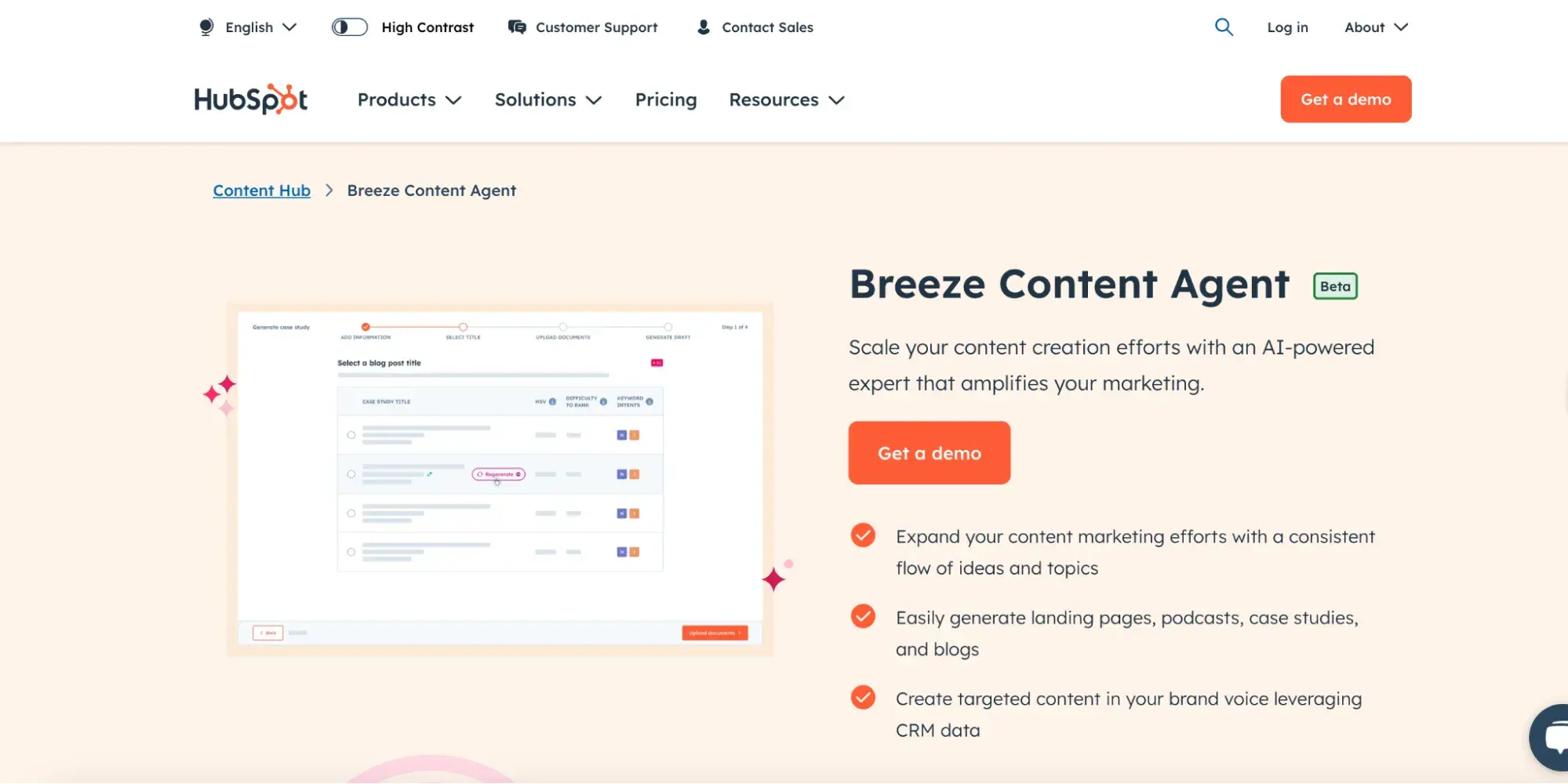
Gamma
Marketers just can’t escape a good slide deck. But, I’m not a fan of tinkering endlessly to get that photo in the perfect spot. Between ideation, copy, and design, presentations can burn a lot of valuable work time.
I’ve used Gamma for over a year now to help me solve that challenge. You can bring your notes to the platform, and Gamma will generate gorgeous presentations. The platform lets me toy with the specifics, such as the voice and tone of any generated copy or what image types get used (e.g., Common Creative licensed or AI-generated).
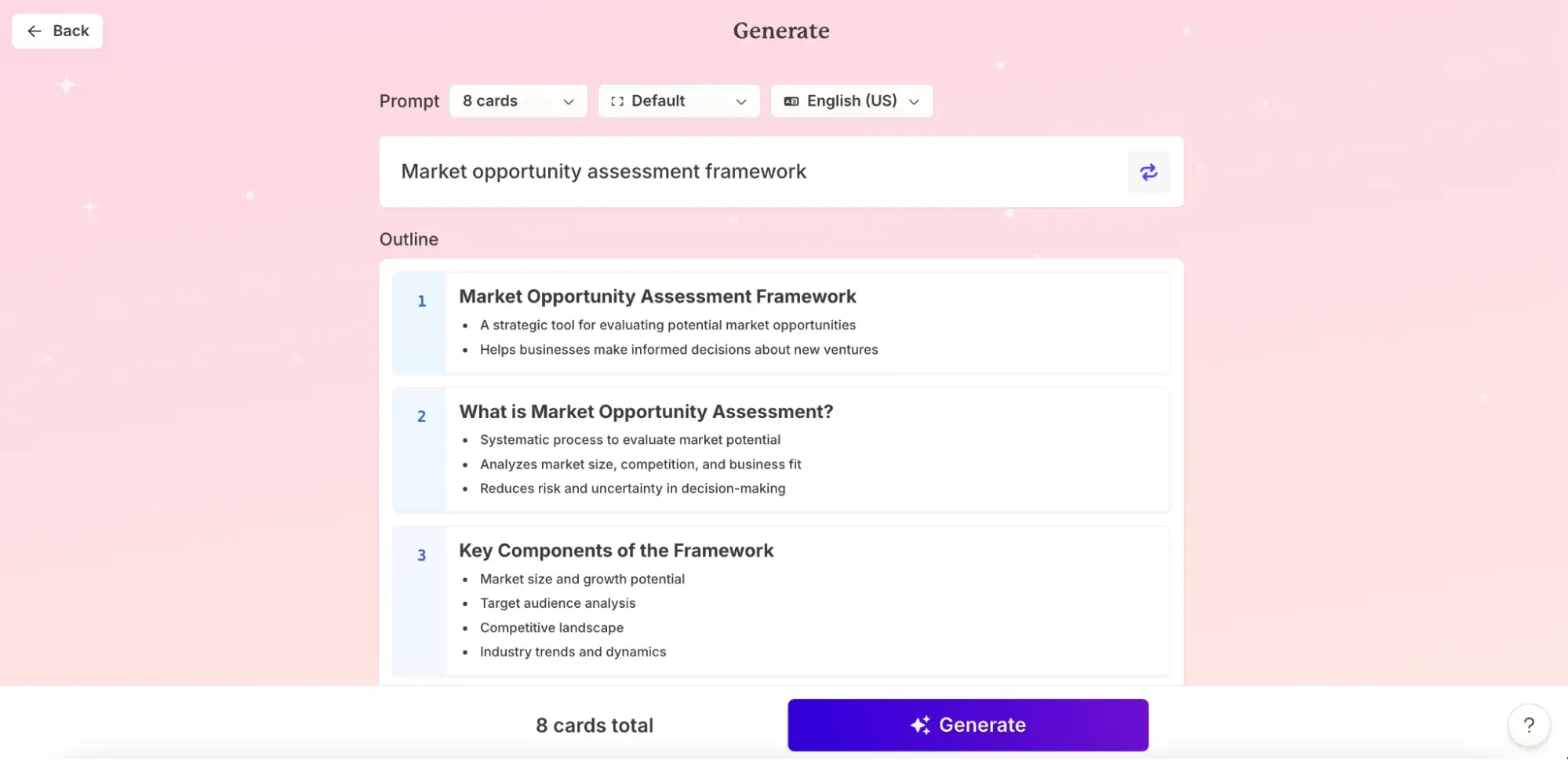
Once you have a presentation in hand, you can add, remove, and change content at your convenience. You can also generate documents or landing pages and publish them online directly. I’ve used the landing page feature before to spin up a new content consulting offer, and Gamma did a great job.
I wish Gamma had a brand kit option like Canva does, where I could save and reuse common branding assets. But, it’s a strong and well-stocked marketing presentation-building tool at $10-20 per seat per month.
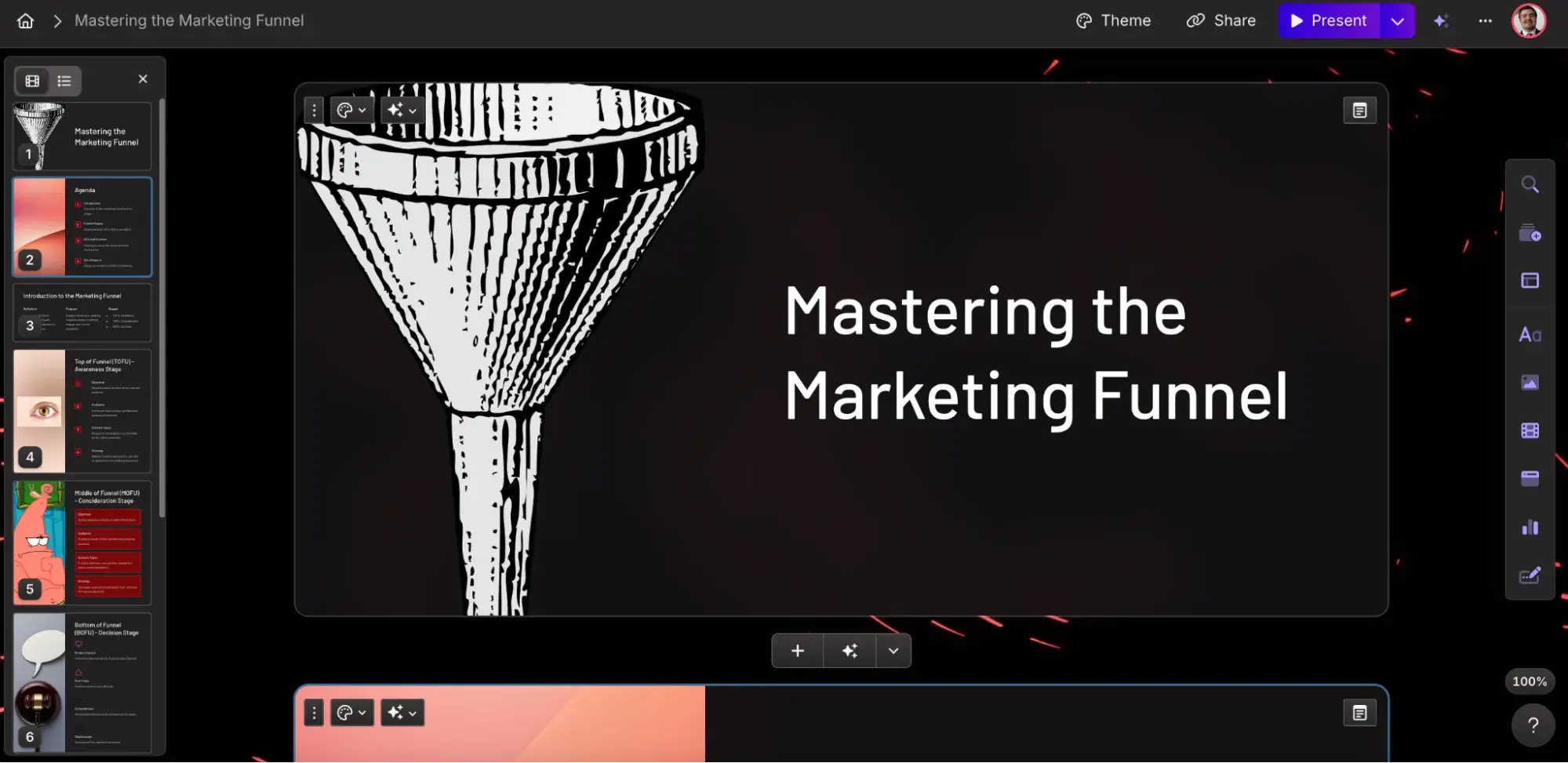
Notion AI
I use Notion as a document repository and information management tool, but the company’s built-in (paid) Notion AI feature has vastly improved over the past year. As projects grow in scope and scale, I end up with documents throughout my Notion database. Notion AI rounds up that information and transforms it into useful insights and actions.
If you want the most from Notion AI, plan your internal knowledge architecture intentionally. I’ve found the AI writer unremarkable. But when I need that solid quote I wrote eight months ago, Notion AI delivers. It’s great for managing brand consistency across your team and finding the best insights and ideas from your data.
Get Notion AI added to your current Notion build for $10 per seat per month.
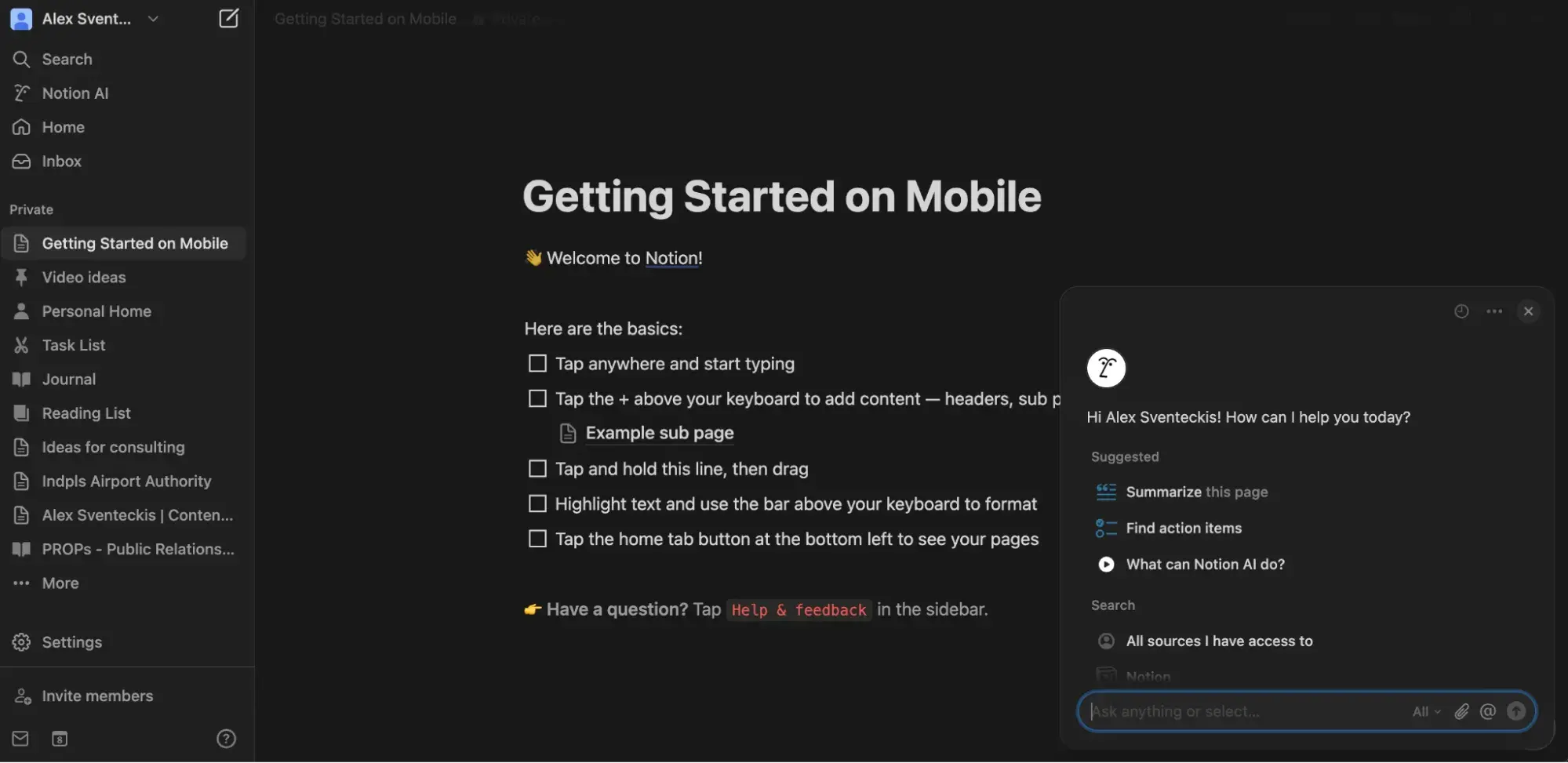
Canva Magic Studio
I’ve always liked Canva’s image creation and manipulation tools to get the right look set for my brand assets, social media graphics, and blog and website images. So, when the company debuted the Canva Magic Studio, I eagerly hopped on board.
Magic Studio offers generative AI and AI-powered editing tools to prepare your pictures and video. You can create and manipulate images using text-based commands and create professional-looking results. It’s a powerful design tool that’s helped me shift creatively from words to visuals.
You can use Canva for free, but you won’t have access to the best AI features until you upgrade to the Pro Plan at $15 per seat per month.
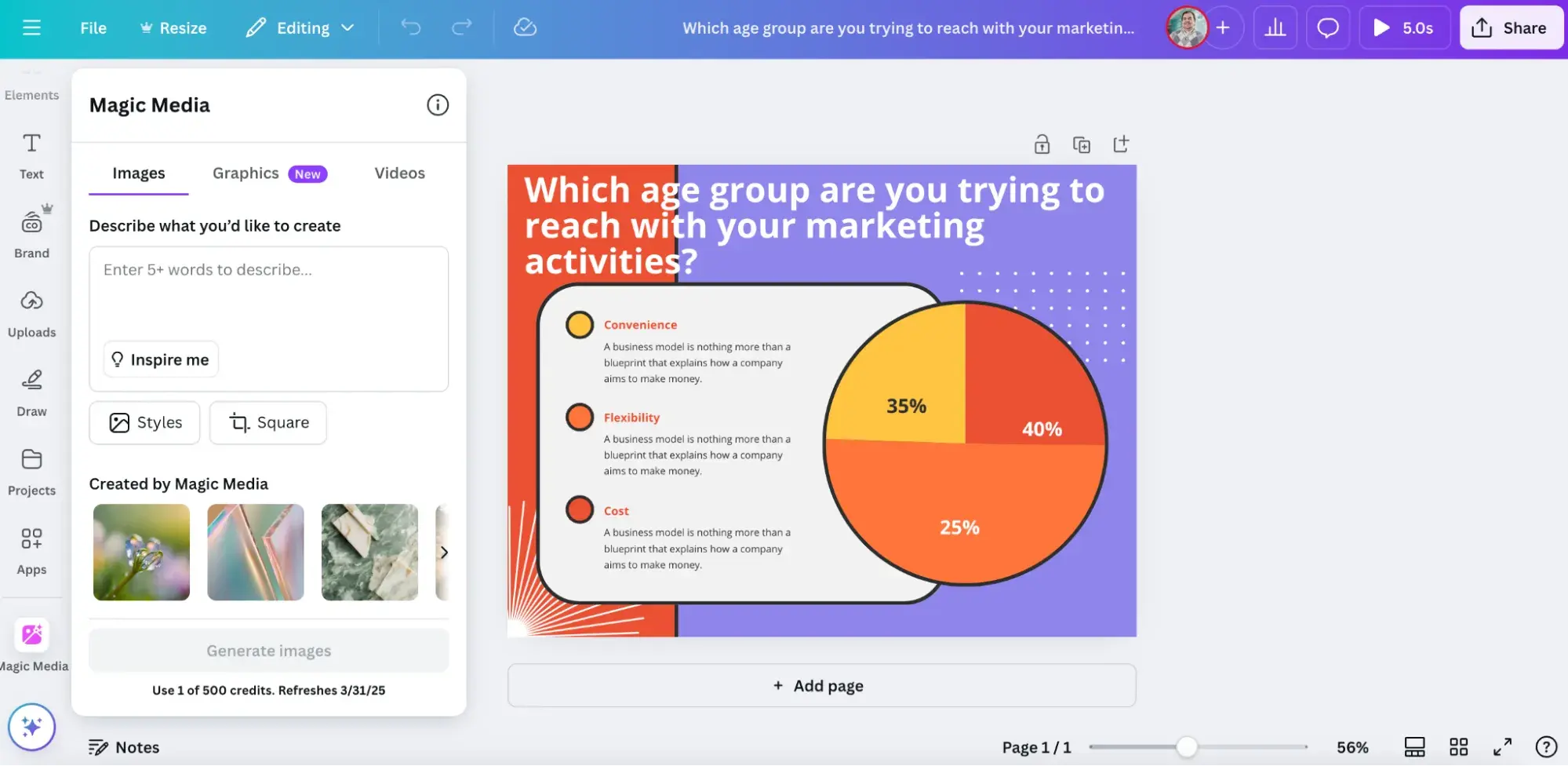
Designs AI
If you’re looking for an all-in-one AI branding tool, Designs AI is a strong candidate. The free tools alone are interesting and helpful. For instance, AI Chat lets me access several LLMs to accomplish tasks.
The free plan is very limited, so I wouldn’t integrate Designs AI without paying for it. But, the paid plan lets you work with images, logos, text, audio — whatever your branding needs require.
Designs AI offers a few plan choices, but the Pro Plan (at $69 per month) is likely the best choice for AI power users.
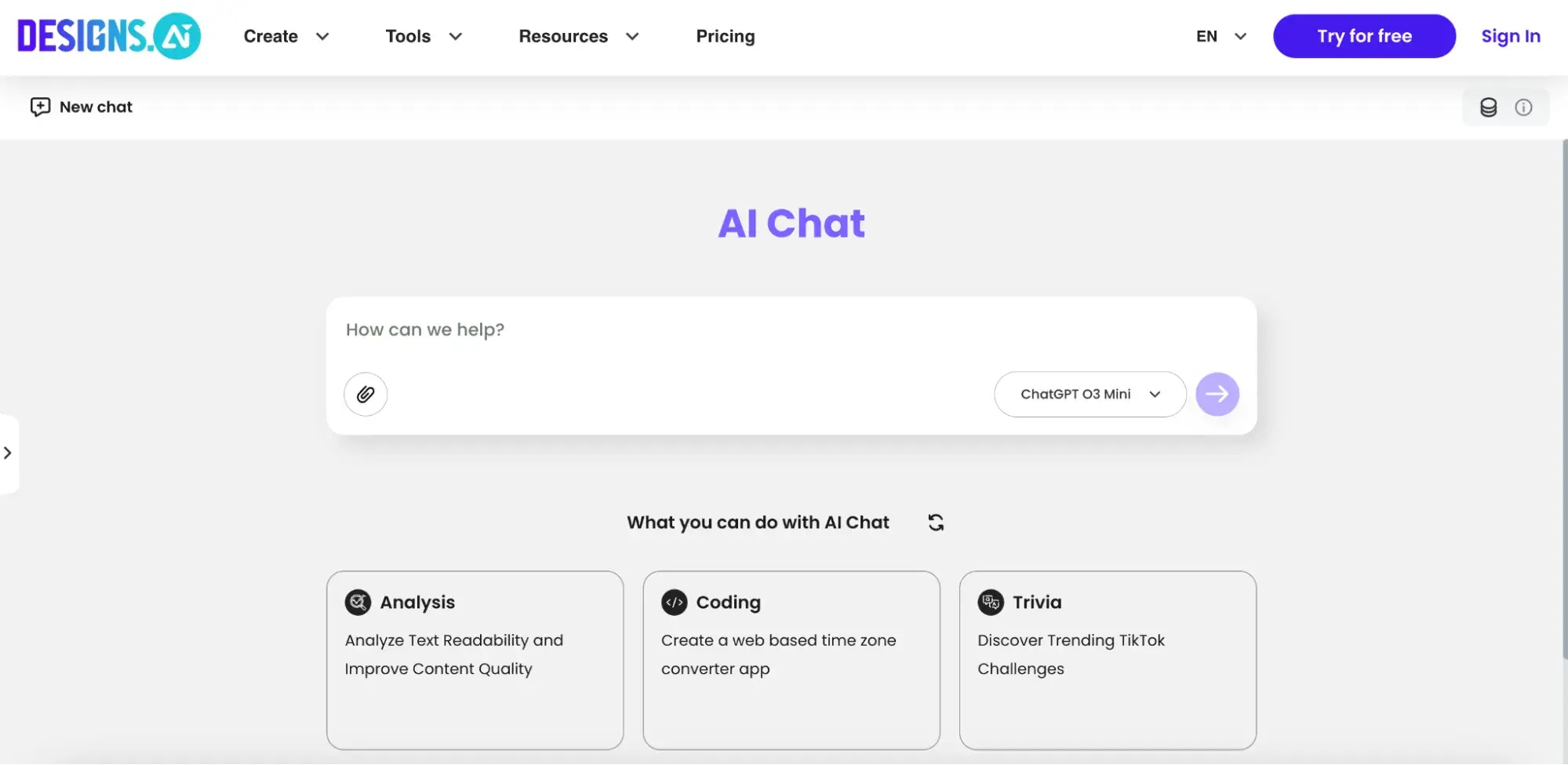
Copy.ai
Copy.ai is doing something interesting in the AI branding space. The company bills its service as the Go-to-Market (GTM) AI Platform. It includes multi-platform brand-specific content but extends across the entire buying experience.
Copy.ai is also leaning into workflow management and AI agenting, which I think are promising future additions to an AI-powered marketing team.
I’ve tried Copy.ai’s free writing generators — and it’s good work for a generic model. Once you integrate the platform into your system, you can get more specific content better attuned to your brand.
You can try a free plan, but the $49 Starter Plan really gets you up and running. If you’re ready to lean into workflow support, go for the $249 Advanced Plan.
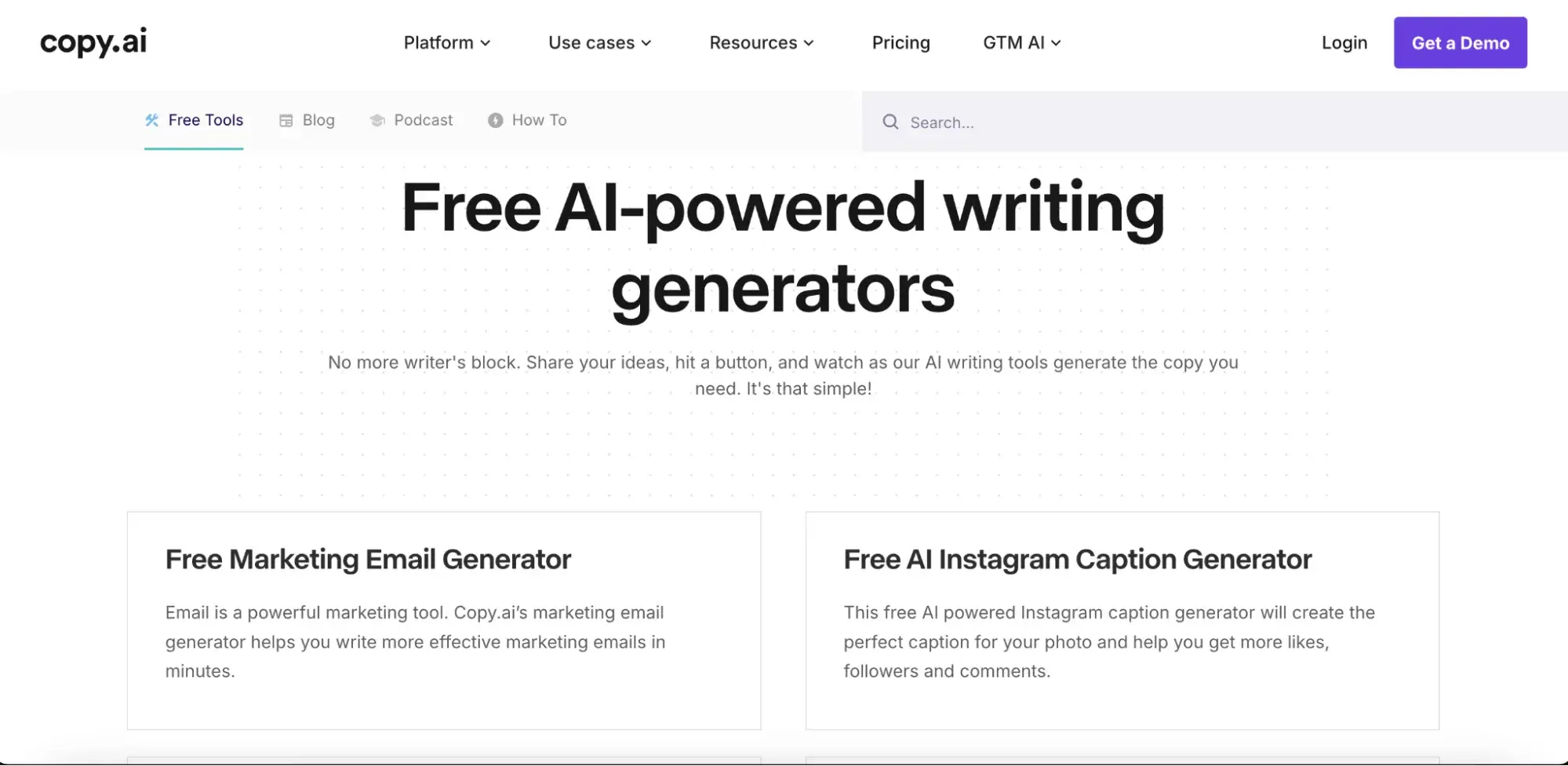
Durable
I’d first heard about Durable when I was building my consultancy’s website. I ended up using another tool, but I enjoyed Durable’s feature set — which has grown since last I looked.
Durable can help you build your websites, blogs, invoicing, and brand identity on one platform. I’m typically careful when a platform promises many options, but Durable impressed me with its reach and success so far.
At $15 per seat per month, you get everything you need to build and launch your web products. If you need extra help with invoicing, social media posts, or Google PPC campaigns, upgrade to the $25 Business Plan.
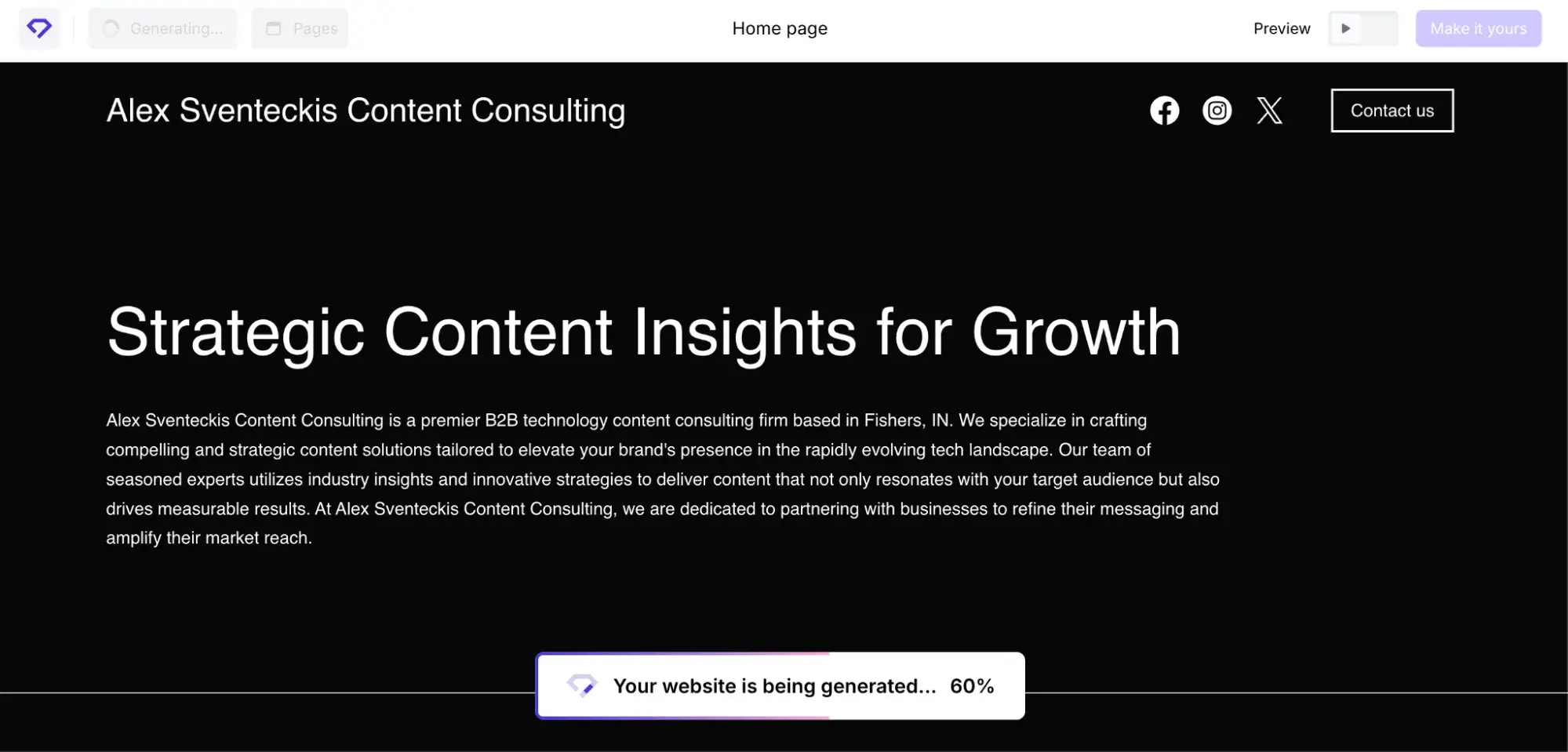
AutoDraw
I am a whiteboard fanatic. Drawing helps me communicate branding ideas with others when I can’t find the words. But, my artistic abilities stop at stick figures. That’s why I’m so drawn to AutoDraw.
AutoDraw uses AI to analyze your input (like a stick figure person), and it will select drawings most closely resembling your artwork. It’s a sketchbook that automatically adjusts my drawings so I can communicate ideas for visual design faster without continually erasing my creations. For logo brainstorming or visual identity creation, it’s a surprisingly useful tool.
AutoDraw is an AI experiment and is free to use.

Adobe Firefly
From a generative AI standpoint, Adobe Firefly does much of what other design tools can do but with more advanced options available. For instance, Firefly offers a 3D generative workspace, helping you quickly design “dimensional” brand graphics, packaging, and illustrations. That’s a slick feature for retail or ecommerce brands.
Firefly creations also come with licenses for commercial use. With an enterprise-level focus, Adobe tools usually reflect those kinds of business considerations. And, as part of the Adobe Suite, Firefly integrates across all Adobe products.
You can use Firefly for free, but I wouldn’t bother unless you’re willing to pay. Individual licenses start at $9.99 per month (though be sure to read your Adobe contract’s terms and conditions carefully for cancellation fees and penalties).
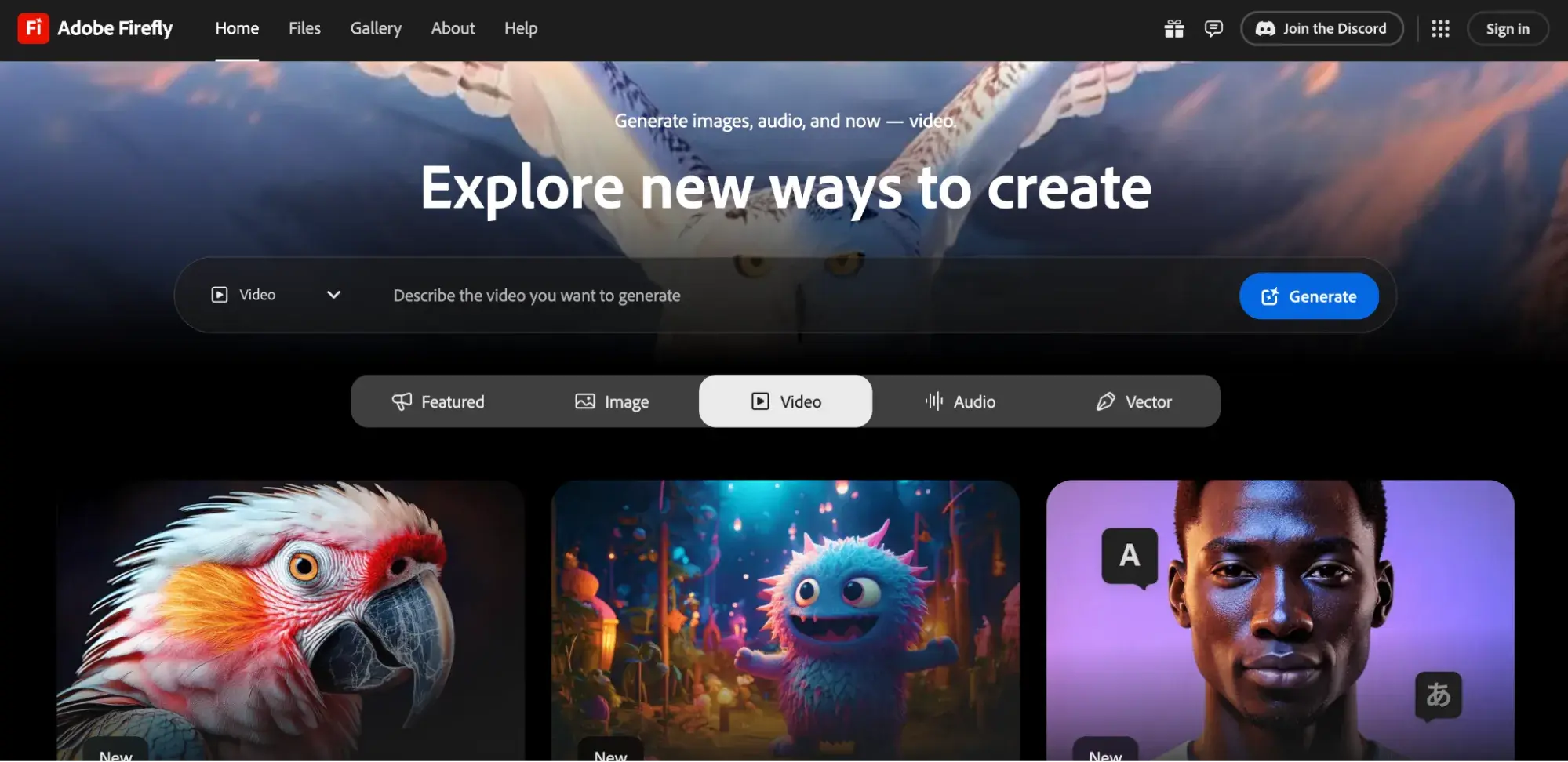
10Web
I host my company’s website on 10Web — and that hosting piece is important. I can build, launch, and manage my site from one place, with no other hosting needs required. It’s a complete feature set that makes sense for my small business needs.
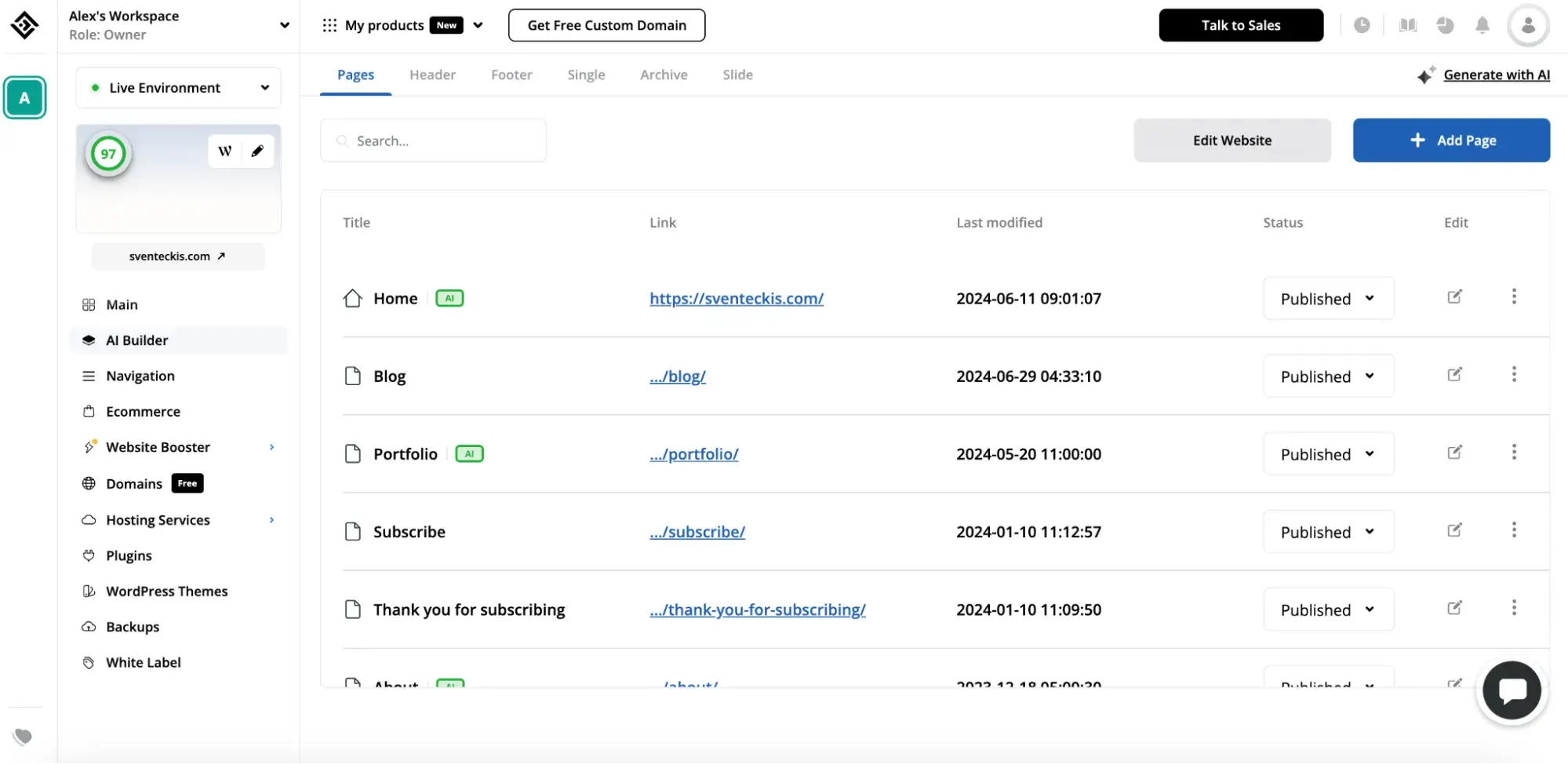
I like 10Web’s AI page creation tool; however, I’ve found it takes more hands-on tinkering than I sometimes want. However, once you build your site and give content to the tool, you’ll generate more brand-accurate results.
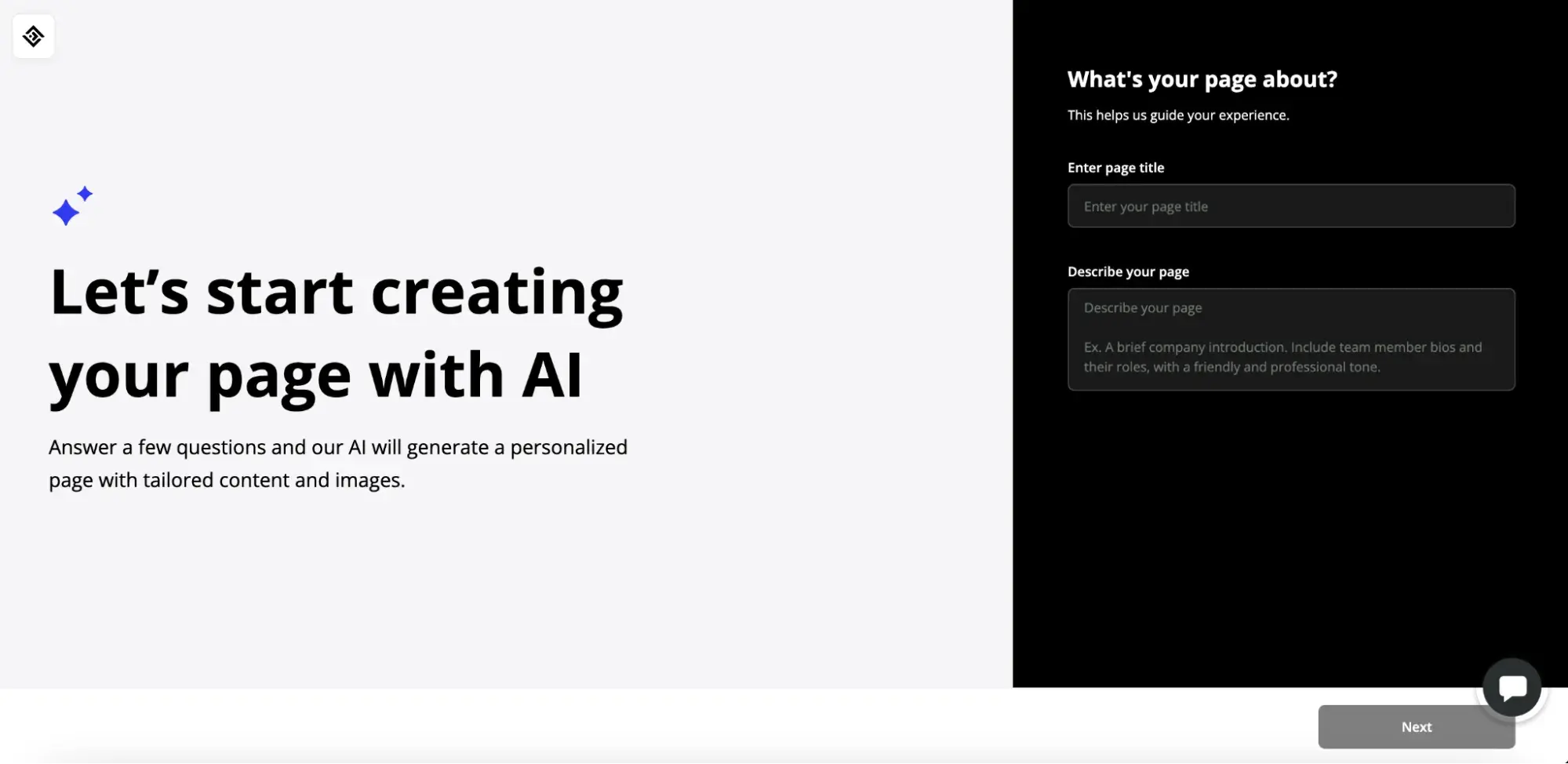
Your costs will vary depending on website hosting needs, but spend in the $25-36 per month range to get smaller websites up and running.
Brandmark
I’m a big fan of upfront pricing models — let me make and buy a logo and tell me how much it costs. Couple it with AI’s help, and you have a strong logo creation tool. Brandmark brings AI to logos, color palettes, and typography to help create a logo that screams you with a clear and affordable pricing structure.
You enter your company name and slogan and provide a few descriptive words and color choices. From there, Brandmark does its thing — I like the polished and professional look of each logo option.
You can edit your logo using an AI chat (like talking to a designer). And when you’re ready, Brandmark can give you marketing mockups so you can see how your logo fits across your visual identity.
Logos start at $25, but you can buy your logo’s commercial license and full brand kits for additional fees.
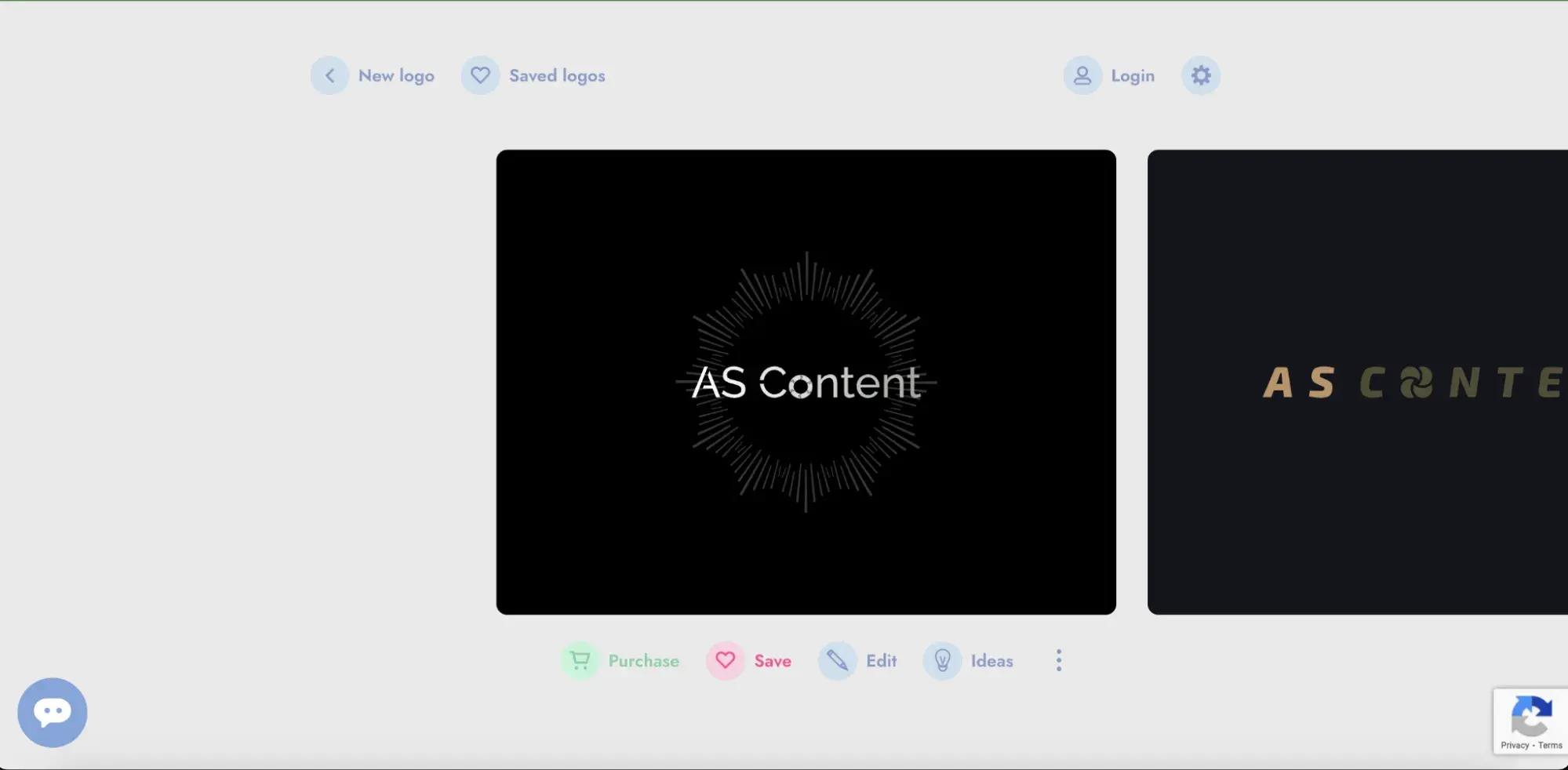
Backstroke
I’ve found better AI branding tools either need unique information from your company or run their operations using hyper-specific models. Backstroke deploys a specialized AI model trained on B2C ecommerce email marketing content, which leads to stronger email campaigns.
I’ve gotten to see it in action through email and SMS campaigns, and it brings excellent AI horsepower to an ecommerce program. While it’s certainly not the most comprehensive tool available, I think it flourishes in its deep focus.
You’ll need to demo the product live and kick off the sales cycle for pricing. But, Backstroke has a free subject line generator and trend identification tool you can try.
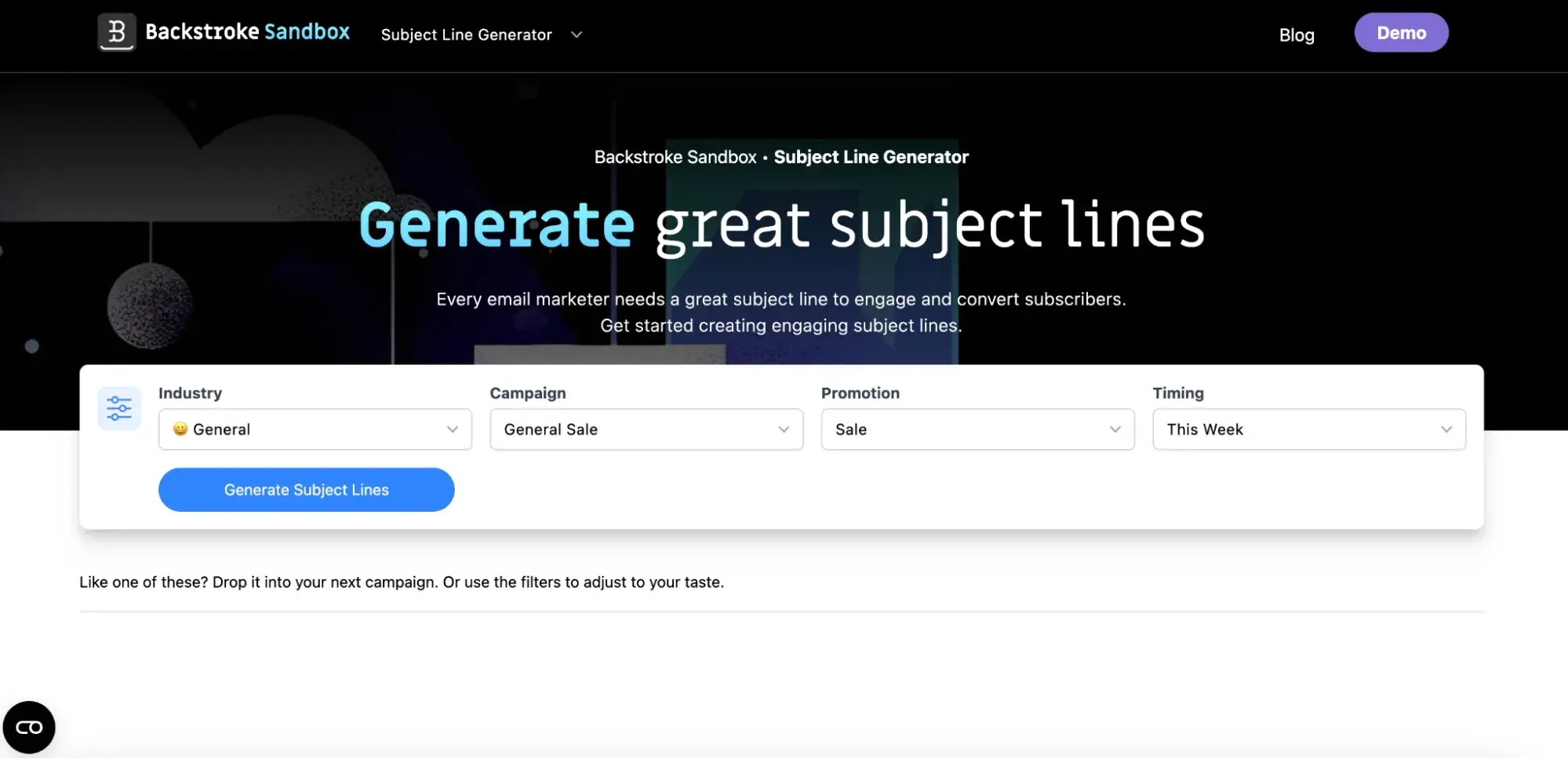
Looka
I like the AI image generation tool Looka provides for logo design. You can design some very nice logos, and you get results that are unique to the market.
Looka also offers a brand kit option: apply your logo to over 300 templates, from letterhead to social media profiles. It’s an easy way to keep your brand’s visual identity consistent across platforms and media.
Looka’s pricing gets a little complicated, which is probably my biggest gripe with the platform. You can buy each logo for $20, but you don’t get full ownership unless you buy the premium logo package for $65. And your brand kit is an annual subscription that runs $96 per year.
It’s not a massive expense, but I don’t like feeling limited in how I own and use my brand assets. That said, if a human brand designer is simply too far out of your price range, Looka is a fine alternative.

Shopify Logo Maker
As with most people, I like when “free” actually means free. Some AI brand asset development tools will give you previews that require a subscription to edit. Not so with Shopify’s Logo Maker.
The Logo Maker does just that — making logos you can download and use anywhere. They’re optimized for Shopify shops, but you can use the image on other sites or social media. You can also generate business names, slogans, and domain names for free (essential components for a Shopify presence.)
The app is free to use. Now, you’re not getting the fanciest logos for free, but if you need to spin up a few brand assets or explore AI’s usefulness, start here.

ChatGPT Custom GPTs
I still think people are sleeping on custom GPTs with ChatGPT, which can help you better manage your brand and create highly specific branded content. Within a custom GPT, you can write detailed instructions for your model’s context window and include PDFs of branded copy. For example, I include PDFs of my consulting company’s blog posts to help the GPT better represent my voice and tone across content types.
A custom GPT is great for content generation and repurposing. You get a lot of power at your fingertips for $20 per month.
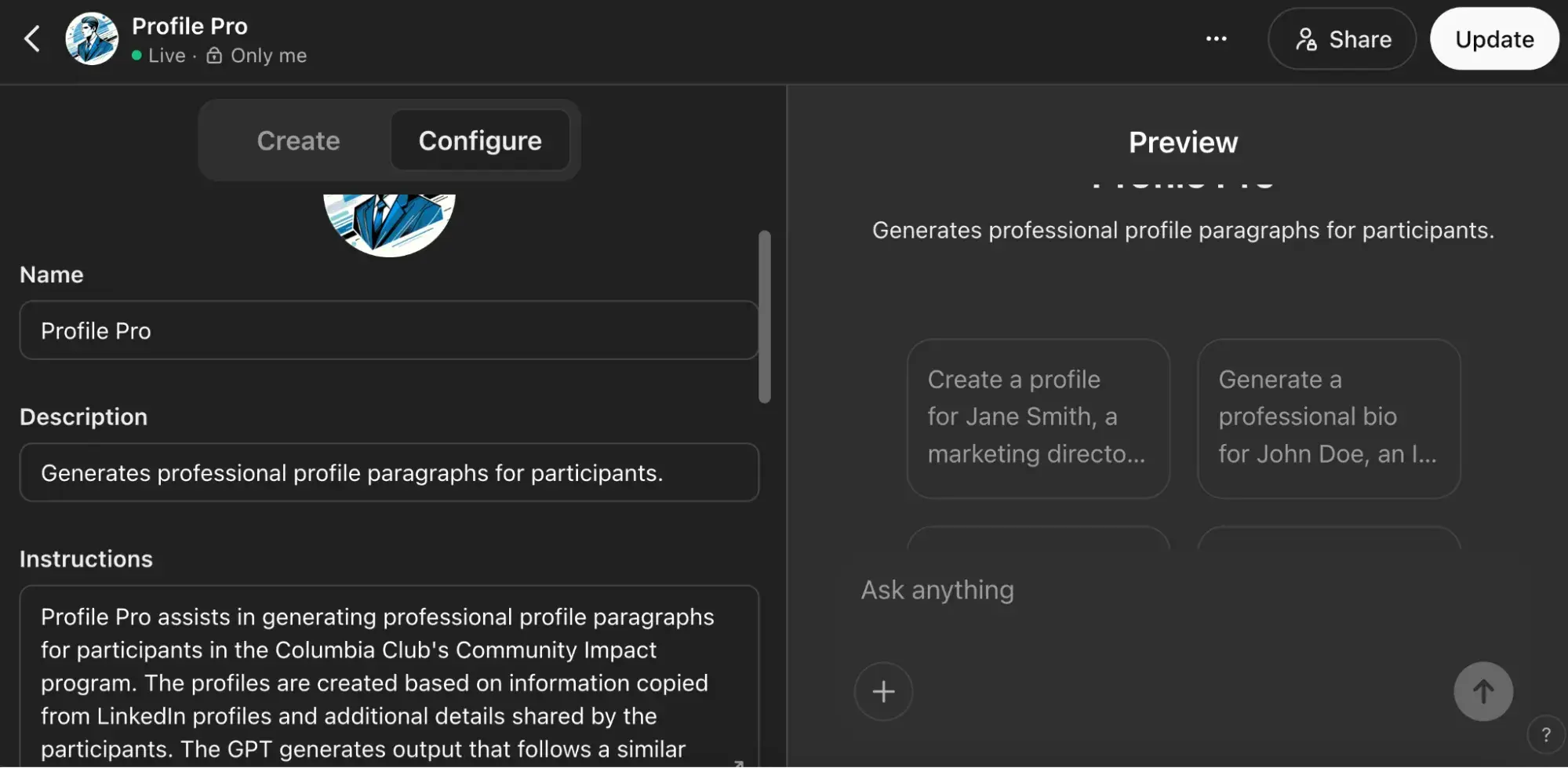
Build the Best Business Brand with AI
Not every brand needs that GameCube-level memorability, but every brand needs distinctiveness and consistency. You can build and nurture such a brand using AI and human creativity to reach and win over your audiences.
The best marketing teams in 2025 won’t just automate branding work. Instead, they’ll figure out how to use AI as a strategic co-pilot while keeping people at the center — marketers and consumers alike. Begin with these tools and explore opportunities to put AI to work for you.


How Customer Journey SEO Turns Clicks Into Conversions
Before you decide what to buy, you probably decide where to shop — which means turning to your favorite search engine. With online searches dominating as the starting point of most purchases, customer journey SEO is now mission-critical for every business.
Before you decide what to buy, you probably decide where to shop — which means turning to your favorite search engine. With online searches dominating as the starting point of most purchases, customer journey SEO is now mission-critical for every business.
I honestly can’t remember the last time I made a purchase without some online research first. Earlier today, I fell down a Google rabbit hole looking for bulk-dried tortellini. Last fall, it was a new MacBook.
By the time I was searching for the best deal on a MacBook, I had already done the bulk of my research — comparing specs, vendors, and reviews. And that tortellini search? It introduced me to brands I never would’ve found if they hadn’t optimized for the SEO-driven customer journey.
Here’s the real question: If your brand isn’t showing up when customers are searching, how much business are you losing to competitors?
Table of Contents
- What is customer journey SEO?
- Mapping Your Customer Journey
- Creating Your Customer Journey Map
- A Step-by-Step Guide to Align SEO With Your Customer Journey
What is customer journey SEO?
Customer journey SEO is simply where SEO and customer journey mapping intersect. While most businesses focus on SEO as a way to rank higher, that’s only part of the equation.
The best SEO strategies do drive traffic. But they take it a step further, supporting customer inquiries through every step of the journey from discovery to purchase, maximizing visibility, engagement, and conversions.
Understanding Different Types of Searches
So, how do you integrate SEO into your customer journey? It starts by understanding the three core types of search: navigational, informational, and transactional.
As you can imagine, each phase correlates with different types of search queries. Aligning your SEO strategy to the customer journey means tying your efforts to each type of search.
Navigational Searches: When Customers Already Know You
Your prospect has a solid idea of what they’re looking for and just wants help going to a specific site.
Using my MacBook example above, some navigational searches I used were:
- “Apple new releases”
- “Costco computers and laptops”
- “Best Buy Geek Squad”
I knew I wanted an Apple product, and I was headed to different vendors I trusted to find out more about the models and to get the best price.
Successful SEO optimization for navigational searches focuses heavily on branding.
Informational Searches: When Customers Are Exploring Options
Your prospects are looking for answers, knowledge, and help. This usually means more top-of-funnel content. Examples of these searches for new laptops might be:
- “MacBook Air vs. MacBook Pro”
- “Best laptops for running an online business”
- “Is the latest MacBook worth it?”
When I was still deciding on a MacBook version and confirming that I wanted Apple over Windows, I looked for content like blog posts, comparison articles, and product reviews.
Successful SEO optimization for information searches means leaning into content marketing.
Transactional Searches: When Customers Are Ready to Buy
Your prospects are ready to buy. They might be looking for the best deal, still deciding between options, or looking for confirmation that their top pick is truly their best bet. Examples of these searches might be:
- “Best deals on MacBook Pro.”
- “Where to buy a MacBook Pro.”
- “Amazon MacBook deals today.”
At this stage, I was really just looking for the best deals and best options, so I looked at product pages and pricing comparisons.
Finally, successful SEO optimization for transactional searches means emphasizing information-rich product pages.
Here’s what that looks like in a visual:
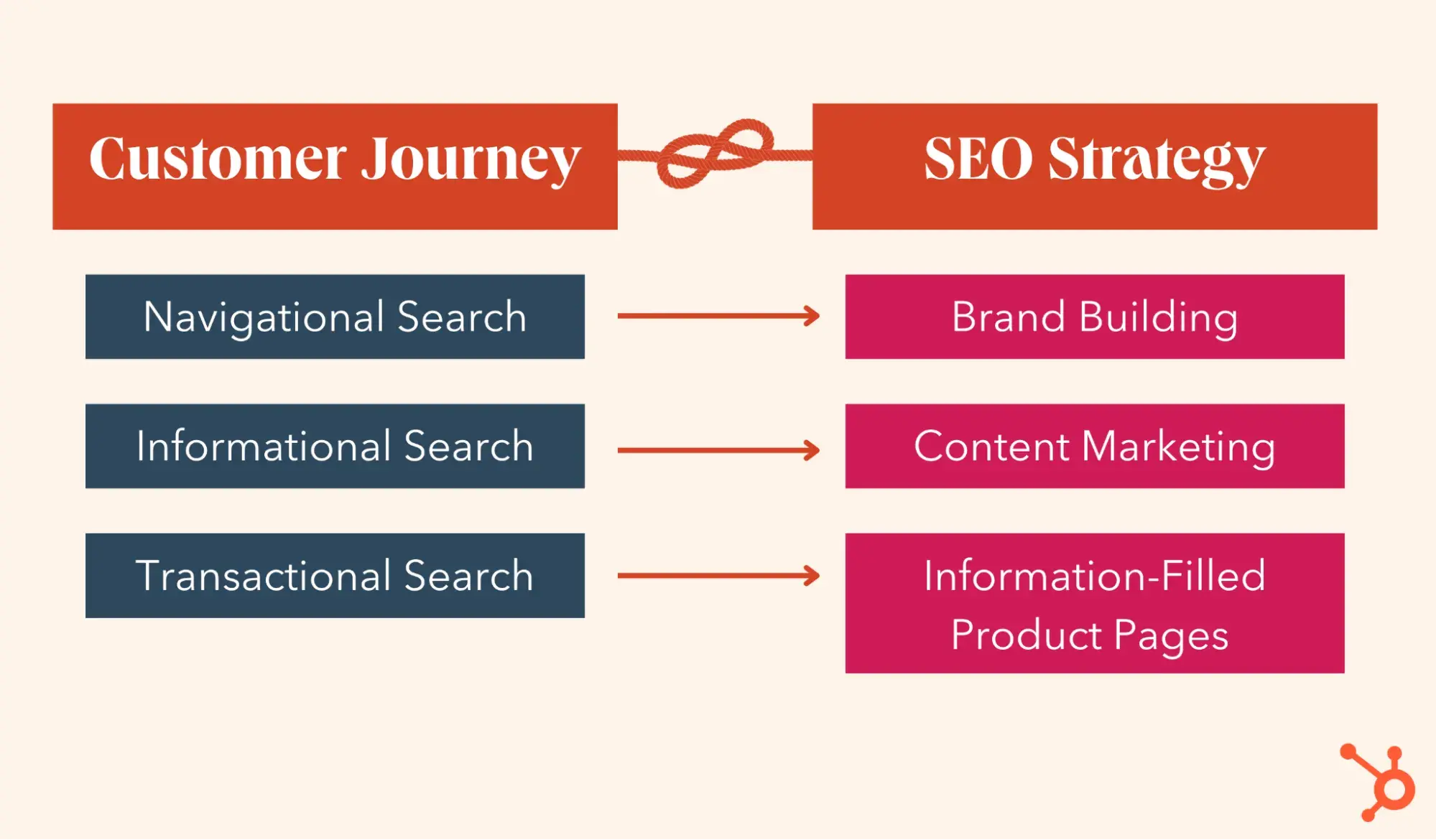
Mapping Your Customer Journey
Before you optimize for SEO, you need to map out your customer’s journey. A customer journey map helps you visualize exactly where potential buyers engage with your brand — and where gaps exist.
Marketing Consultant Kerry Bodine explains it best in this must-watch video:
The great thing about customer journey maps is that they put customers first. By sketching a sticky-note map of people progressing through a theoretical funnel, you are putting the focus on customers.
I firmly believe that’s how every organization should function — elevating, honoring, and giving pride of place to the customers. This level of customer obsession leads to loyalty, referrals, and competitive advantage.
Pro tip: Don’t make the mistake of thinking customer journey maps are the same as sales funnels.
While sales funnels do provide a broad-based sketch of a process and can be a good starting point, they don’t actually map the journey. With that in mind, it’s best to think of them as two separate entities serving two separate purposes.
Creating Your Customer Journey Map
For the purposes of this article, I’ll stay high level. We’ve got a great post that goes into detail on creating your customer journey map, and I definitely encourage running through it.
With that said, here’s how to create your map and make it SEO-friendly.
Step 1: Identify the key stages in your customer journey.
We typically break this down into three stages:
- Awareness. When customers first discover their problem or need.
- Consideration. When customers begin researching their options.
- Decision. When customers are ready to buy.
In fact, you can see them in the screenshot below of our free customer journey map template.
Step 2: Map your customer search behavior.
Now, it’s time to figure out what they’re searching for at each phase. I want you to consider search intent as well as the specific keywords and questions.
- Awareness. Informational searches for “how to” content about solving their problem.
- Consideration. Product comparisons and brand research.
- Decision. Transactional and vendor searches.
With that in mind, start mapping out the types of searches they’re likely making. You can usually shorten this page by using your SEO marketing software (it’s HubSpot, right?).
Pro tip: Revisit this regularly. Consumer habits and markets change, which means search patterns do, too.
Step 3: Connect the customer journey to SEO efforts.
This is where the customer journey SEO comes in. It’s important to understand the types of content that best fit each phase before diving headlong into mapping. Here’s a quick rundown of how things often break down at each stage:
- Awareness. Top-of-funnel (TOFU) content like blogs, guides, and frequently asked questions.
- Consideration. Middle-of-funnel (MOFU) content like product comparison pages, case studies, and testimonials.
- Decision. Bottom-of-funnel content (BOFU) like product pages, pricing comparisons, and lead gen content.
Pro tip: Don’t overcomplicate it. Start with these quick wins:
- Repurpose what you can. Before creating a ton of new content, do an audit of your existing content. You may have a lot of great stuff that just needs some tweaking or optimization.
- Identify the low-hanging fruit. What content is easy to create that will have a big impact? TOFU content often fits into this category, but not exclusively.
- Prioritize content that serves a double duty. Maybe this means focusing on resources that can also help existing customers. Or perhaps it means focusing on optimizing product pages to create awareness earlier in the process.
Want more detail? Check out our free Customer Journey Mapping lesson.
More Customer Journey Mapping Examples
Your customer journey map can take MANY different forms and should help you identify what your customer is experiencing at each stage of the journey.
If the first template you find isn’t working for you and you can’t easily adjust it for your needs, I recommend opening up your favorite infographic tool to see what customer journey templates exist. I did a quick Canva search, and clicked on one of the first designs that caught my eye. As you can see below, there are several different options right below it.

I usually end up combining visuals with tables or spreadsheets because both are helpful to me.
A Step-by-Step Guide to Align SEO With Your Customer Journey
If your brand isn’t visible at the right moments, your competitors will be. That’s why SEO isn’t just about rankings. I want you to instead think about it through the lens of making it easy for your audience to find you when it matters most — or at the start of the customer journey.
If they can’t find you — clearly the best option — customers will veer off to a competitor. Or, even worse, they’ll get lost and end up frustrated or back at ground zero. So, findability is not an option.
Your SEO strategy should be built around user intent. Here’s how to optimize your content for each stage of the journey based on the customer journey map and content overview you mapped out above (you did that, right?).
Step 1: Make a list of keywords/queries for each point in the customer journey that involves a specific query type.
Find each touchpoint in your customer journey and use your favorite SEO keyword research tools to develop a list of keywords your customers are likely using.
Let’s say a customer is researching luxury vacations. They start with informational searches (“Best Caribbean resorts”), progress to navigational searches (“Four Seasons Bora Bora vs. Ritz-Carlton Maldives”), and finally move to transactional searches (“Four Seasons Bora Bora best deal”).
Type of website: Family vacation planning service
Customer: Suburban mom planning for family vacation
Point in customer journey: Getting a sense of travel costs for her upcoming family vacation.
Query type: Informational
Possible Keywords:
- family vacation cost
- cost for family of 4 to go to Disney World
- vacation cost calculator
- how much vacation can I afford
- average vacation cost for family of 4
- average vacation cost
- cost vacation Ireland
- cost vacation
- low-cost family vacation ideas
Step 2: Optimize for intent.
Now, take those keywords and plug them into your SEO strategy. How? Let’s take one keyword from the above example — “how much vacation can I afford?” Here’s what you might do:
- Create a page on the website.
- Page title: “How much vacation can I afford? | Vacation Planning.”
- H1: “How much vacation can my family afford?”
- Article: Discuss answers to this question in the article, and provide a CTA at the end.
- Create a series of four evergreen blog articles that deal with this question. Use this keyword and any longtail variations of “how much vacation can I afford?”
- Create an infographic that answers the question, “How much vacation can I afford?”
- Interview several experts on vacation affordability and post a video series on YouTube.
After conducting an effort like that, you will start to dominate that keyword. More to the point, you will also dominate this phase of the customer journey. Whenever potential customers engage in informational searches for this phase, they will likely see your website in the search results.
Step 3: Measure and refine.
SEO can have quick wins, but it’s also a bit of a long game. And as I touched on above, things change as markets and technology evolve. So what worked 10 years ago didn’t work 5 years ago — and definitely doesn’t now. To that end, what works well today will barely scratch the surface in the next 5-10 years.
So, use Google Analytics to track conversions and tools like Ubersuggest or Ahrefs to track SEO performance. Then, improve underperforming content and create new content to meet your new needs.
Step 4: Improve technical SEO for visibility.
Keywords and on-page SEO will help your customer journey optimization efforts immensely. But there’s another piece of the puzzle that matters, too — technical SEO. By improving your domain health and ensuring that your site is usable and functional, you build even more trust with Google and other search engines. And that ensures that your customer journey SEO efforts pay off.
If you’re not deep into the SEO world, it’s probably worth bringing in a technical expert, but you can do a lot of this stuff yourself if interested. You can check out our free Technical SEO lesson here.
Findability Is a Must for Customer Journey SEO
To stay competitive in today’s market, online visibility is a must.
If you want to market more effectively, and you don’t yet have a customer journey map, you’re going to want to make one. But don’t stop there. A customer journey map is an excellent exercise, but without SEO implementation, it’s going to be less than productive.
The bottom line? If you’re not mapping SEO to your customer’s journey, you’re leaving money on the table. And you and your customers deserve better.
Editor’s note: This post was originally published in September 2014 and has been updated for comprehensiveness.


The HubSpot Blog’s TikTok Marketing Report: Insights from 1,000+ Social Media Marketers
I first downloaded TikTok during college to scroll through comedy and pop culture discourse. But then, as I grew as a marketer, I started seeing some serious potential everywhere. And I’m not the only one who noticed.
I first downloaded TikTok during college to scroll through comedy and pop culture discourse. But then, as I grew as a marketer, I started seeing some serious potential everywhere. And I’m not the only one who noticed.
TikTok has evolved beyond just dance trends and viral challenges into a genuine powerhouse for brands connecting with audiences authentically. And don‘t just take my word for it — we’ve surveyed over 1,000 social media marketers to bring you data-backed insights on how TikTok is reshaping the marketing landscape.
![Download Now: The 2025 State of Social Media Trends [Free Report]](https://no-cache.hubspot.com/cta/default/53/3dc1dfd9-2cb4-4498-8c57-19dbb5671820.png)
In this article, I’ll share the latest of our 2025 State of Social findings to help give your brand or business TikTok profile the visibility it deserves.
Table of Contents
Why TikTok Matters for Your Marketing Strategy
What started as a platform many marketers dismissed as “just for teens” has evolved into one of the most important channels in our digital marketing arsenal.
And the numbers don’t lie. Our research shows that 56% of social media marketers are now using TikTok, making it one of the top five most-used platforms alongside Instagram (76%) and YouTube (79%).

It’s so impressive to me when I reflect on the progress of other trending social sites. Unlike the slow adoption we saw with platforms like Snapchat in the marketing world, TikTok has managed to overcome initial skepticism and cement itself as a marketing essential in record time. I believe this rapid acceptance comes down to one thing: results.
TikTok isn‘t just popular — it’s effective. Marketers report that TikTok is a top performer across key metrics:
- 17% rank it as a top platform for driving website traffic
- 18% cite it as a leader for social media engagement
- 19% recognize its power for audience growth
If you’re a marketer looking to elevate your social strategy, a content creator aiming to maximize your reach, or a business seeking new channels for growth, this guide will help you navigate the world of TikTok marketing with confidence.
How Social Media Marketers Are Leveraging TikTok
Marketers have a knack for understanding and using social media in more ways than one, let me share the different ways we leverage TikTok for marketing objectives.
Platform-Specific Strategies
TikTok isn’t just another box to check in your social media marketing plan. Its unique algorithm and content discovery mechanisms require tailored approaches that differ from strategies you might employ on LinkedIn or Facebook.
Pro tip: In my experience, the brands seeing the most success on TikTok create platform-native content rather than repurposing material from other channels. I recommend starting fresh with content specifically designed for TikTok’s vertical format and fast-paced environment. Not to mention, video editing in the app is easy enough for anyone to do it!
Marketing Objectives That Shine on TikTok
Now, you can‘t just post a bunch of videos without a game plan. Marketers need to use social media strategically to achieve the results they’re looking for.
Our data shows that TikTok excels at:
- Building brand awareness through viral content
- Fostering community engagement (18% of marketers rank it as a top platform for engagement)
- Driving meaningful audience growth (19% cite it as a leader in this category)
I’ve found that TikTok particularly excels at humanizing B2B brands, something that can be challenging on more formal platforms. Its casual, authentic nature allows even the most corporate brands to show personality in ways that resonate with audiences.
Paid vs. Organic: Finding Your Balance
While TikTok offers robust advertising options, many brands succeed through organic content that resonates with the platform’s authenticity-first ethos.
However, our research indicates a growing trend toward paid strategies, with 30% of social media marketers planning to increase their TikTok investment in 2025, while 26% plan to maintain their current spending levels.
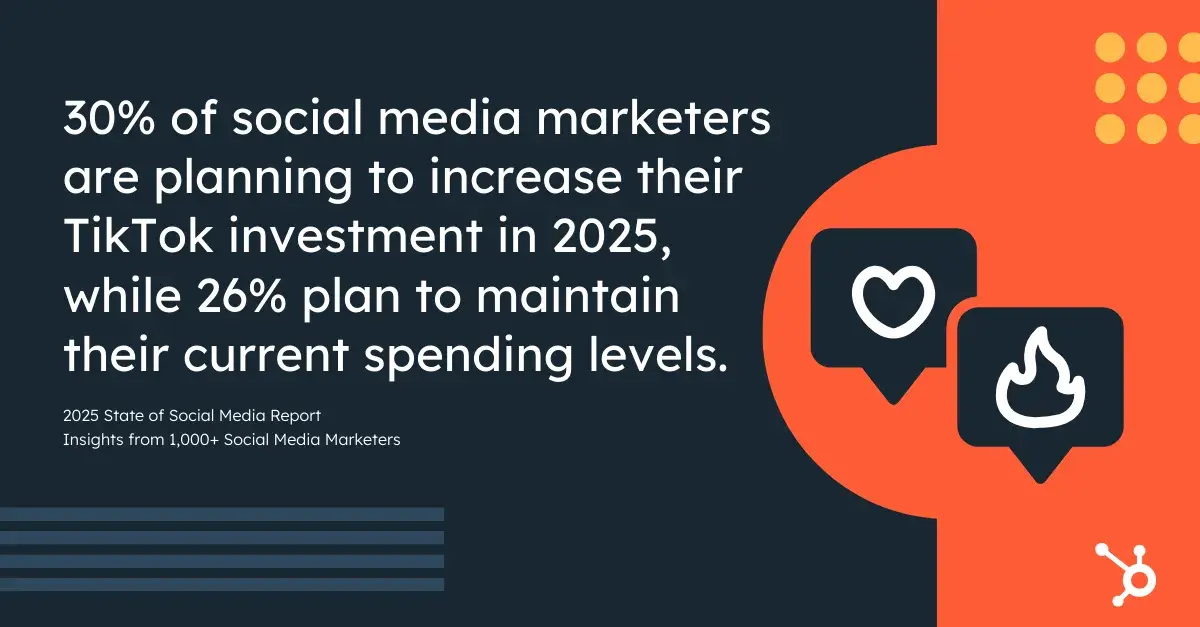
What I like: I‘m impressed by how TikTok has managed to create an advertising ecosystem that doesn’t feel intrusive. In my opinion, this is why both paid and organic strategies can thrive side-by-side on the platform—something that’s becoming increasingly rare in social media.
Data-Backed Benefits of TikTok Marketing
Engagement That Outperforms
TikTok isn‘t just keeping pace with other video platforms — it’s setting new standards for engagement. Our survey results place TikTok among the top performers for social media engagement at 18%, competing directly with Instagram and YouTube.
I‘ve personally observed that TikTok’s engagement rates often surpass what we see on other platforms, even with comparable content. There’s something about the format that encourages active participation rather than passive consumption.
Pro tip: I love repurposing TikToks into LinkedIn posts since video content is also a marketing priority on that social platform. Just download your TikTok and use the right hashtags for the audience you wish to reach, and you can make some meaningful connections there, too.
The Power of the For You Page
The platform’s algorithm-driven content discovery allows even accounts with modest followings to achieve significant reach, something that 17% of marketers recognize as they rank TikTok as a top platform for driving site traffic.
Pro tip: I always tell marketers not to get discouraged by slow follower growth on TikTok. Unlike other platforms where your follower count largely determines your reach, TikTok’s For You Page can put your content in front of thousands — even millions — of relevant viewers regardless of your account size. Focus on creating content that resonates, and the views will come.
Brand Safety Confidence

Concerns about brand safety have faded as TikTok has matured. Our data shows that a majority of marketers feel comfortable with their brand presence on the platform:
- 29% feel very comfortable
- 36% feel somewhat comfortable
- 22% feel neither comfortable nor uncomfortable
- Only 11% express some discomfort
Honestly, I was initially skeptical about brand safety on TikTok, but I’ve been pleasantly surprised by how the platform has evolved. The sophisticated content filtering and advertising safeguards have come a long way, and I now feel confident recommending TikTok to even the most risk-averse strategists.
How Content Creators & Marketers Are Earning ROI on TikTok
Influencer Marketing Excellence
TikTok has established itself as the leading platform for influencer marketing ROI. An impressive 47% of marketers report getting their highest ROI from TikTok influencer collaborations — outperforming both Instagram (46%) and YouTube (41%).
What I like: I‘m fascinated by how TikTok has democratized influence. Unlike Instagram, where established mega-influencers dominate, TikTok has created space for micro and nano influencers to drive significant results. I’ve seen campaigns with creators who have just 10,000 followers outperform those with influencers boasting millions — it’s all about authentic connection with niche communities.
Future Investment Trends
The confidence in TikTok’s ROI is reflected in future spending plans. When asked about their 2025 influencer marketing intentions, 15% of marketers plan to prioritize TikTok, making it the third most popular platform behind Instagram (27%) and YouTube (24%).
I believe we’re just seeing the beginning of the TikTok influencer ecosystem. As the platform continues to mature and more creators master its unique format, I expect that 15% figure to grow substantially by the time we run this survey again.
Driving Measurable Results
Beyond brand awareness, TikTok is proving its worth in tangible business outcomes:
- Traffic generation (ranked as a top performer by 17% of marketers)
- Community building and engagement (18%)
- Audience growth (19%)
Pro tip: In my experience, the key to driving measurable results from TikTok is integrating it into a multi-channel approach. I’ve found that using TikTok for awareness, then retargeting those engaged viewers on platforms like Instagram or through email, creates a powerful conversion pathway that maximizes ROI.
What Content Stands Out on TikTok
Authenticity Reigns Supreme
Unlike Instagram’s polished aesthetics or YouTube’s long-form depth, TikTok rewards authenticity and creativity. This creates unique opportunities for brands to connect with audiences through more casual, human content.
I’ve learned (sometimes the hard way) that over-produced content often flops on TikTok. My most successful posts have been those where I embraced imperfection and focused on genuine storytelling over production value (and coincidently, were the ones I edited the least).
Community-Driven Content
The platforms that foster authentic communities are seeing the most success. TikTok’s strength in engagement (ranked top by 18% of marketers) speaks to its ability to create meaningful connections between brands and their audiences.
Pro tip: Don‘t just broadcast on TikTok—participate. Some of the best brand moments I’ve seen on the platform come from companies that actively engage with trends, respond to comments, and duet with users. I recommend allocating at least 30 minutes daily to community engagement if you’re serious about building a TikTok presence.
How Experts Navigate TikTok Governance
Compliance Confidence
Despite early concerns about platform governance, marketers are increasingly comfortable with TikTok’s ecosystem. Our Social Media Trends Report shows that 65% of marketers feel at least somewhat comfortable with brand safety on the platform, with only 11% expressing discomfort.
I remember the uncertainty many of us felt when TikTok first emerged as a marketing channel, but I’ve been impressed by how the platform has responded to concerns and built robust systems to protect both users and brands.
And on the note of a different type of governance — despite TikTok experiencing a U.S. temporary “ban” (if you call 12 hours a ban) in January 2025, it hasn‘t stopped the hundreds of thousands of creators and businesses on the platform from continuing to post. If that isn’t an indicator of this app‘s impact and staying power, I’m not sure what is!
Adapting to Platform Evolution
Smart marketers stay agile, ready to adapt to TikTok’s evolving landscape — from algorithm updates to new features. This adaptability will be key as 30% of marketers plan to increase their TikTok investments in 2025.
Pro tip: I‘ve found it essential to dedicate time each week to staying on top of TikTok’s changes. Join TikTok for Business newsletters, follow their blog, and connect with other marketers in the space. The platform moves quickly, and staying informed about new features or algorithm shifts can give you a significant competitive advantage.
TikTok Marketing Examples
Success Across Business Models
Both B2C and B2B brands are finding their footing on TikTok. The platform’s versatility has allowed companies across sectors to connect with audiences in meaningful ways, contributing to its status as a top platform for audience growth (19%).
What‘s surprised me most is how well B2B companies can perform on TikTok when they approach it strategically. I’ve watched traditionally “boring” industries create engaging content that not only drives awareness but actually converts. The key? Focusing on the humans behind the business decisions.
Influencer Success Stories
The data speaks volumes: 47% of marketers report their highest influencer marketing ROI comes from TikTok. These collaborations are proving more effective than traditional advertising for many brands, explaining why 15% of marketers plan to prioritize TikTok for influencer partnerships in 2025.
What I like: I love how TikTok has broadened the definition of “influencer” to include subject matter experts, industry professionals, and everyday enthusiasts. This has created opportunities for more authentic partnerships that feel less like advertisements and more like valuable content—which, in my experience, is precisely why they perform so well.
Hone Your TikTok Strategy for 2025 and Beyond
As we look toward 2025, TikTok’s importance in the marketing mix continues to grow. With 30% of marketers planning to increase their TikTok investment and only a small minority expressing concerns about brand safety, the platform has firmly established itself as a marketing essential.
For marketers looking to start or improve their TikTok presence, our data offers clear direction:
- Prioritize authentic, engaging video content
- Consider influencer partnerships for maximum ROI
- Balance organic and paid strategies
- Focus on metrics that matter: engagement, traffic, and audience growth
I‘ll be honest: if you’re not already incorporating TikTok into your marketing strategy, you‘re likely falling behind competitors who are. The data doesn’t just suggest TikTok is important—it screams that this platform has become essential for brands that want to stay relevant and connected with audiences.


29 of My Favorite Visual Content Creation Tools
Visual content, be it video, infographics, photos, or some secret fourth thing, is a must-have in any marketing campaign. But, if you struggle to edit visuals or coordinate elements like colors and fonts, creating visual content for your brand can seem daunting.
Visual content, be it video, infographics, photos, or some secret fourth thing, is a must-have in any marketing campaign. But, if you struggle to edit visuals or coordinate elements like colors and fonts, creating visual content for your brand can seem daunting.
If that‘s the case, I’ve been in your shoes before. To help you create valuable visuals for your brand, here’s a list of nearly 30 online design tools you can use, many of which are free or have free trials.
But first, let’s quickly jump into how to create visual content.
Table of Contents
- How to Create Visual Content
- Visual Conent Examples
- Online Design Tools for Creating Stunning Visual Content for the Web
How to Create Visual Content
First things first, you need to know your audience. Before I create any graphic, I think about the type of content my target audience responds to and what platforms they frequent the most.
For example, during my time working at a television news station, I found that our viewers responded well to infographics and spent most of their time on Facebook.
So, naturally, I’d create infographics to break down complex news updates and distribute them on Facebook.
Once you figure out your format and distribution channel, you’re ready to start working on your visual content. I encourage you to be creative, think outside the box, and experiment with different approaches. That said, you should always use colors that pair well together.
Not sure how to coordinate colors? No worries! Whenever I’m struggling to find the right colors to incorporate into a graphic, I consult Canvas color wheel, which also includes a crash course in color theory and combinations.
I also suggest using your brand’s colors in your visual content wherever possible. It gives your content a cohesive and consistent look and helps you brand stay top of mind for consumers.
Use consistent, branded fonts if you‘re able to, and avoid using too many fonts. My rule of thumb is now more than two different fonts in one graphic. And don’t be afraid to experiment with tools like HubSpot’s Clip Creator or any of the ones I’ll list in this post.
Even if you don’t use every tool, its features and resources may inspire you for future projects.
Visual Content Examples
1. McDonald‘s “WcDonald’s Campaign”
McDonald’s ran an ad campaign called WcDonalds that featured ads animated in the Japanese anime style. The idea coincides with the recent popularity of anime in mainstream media and how the franchise if often referenced in anime and by fans alike.
I’m a huge anime nerd, so of course, I adored this campaign. As a marketer, I loved the bold use of color, the high-quality animation, and the fun storylines in each ad.
2. Airbnb’s Instagram
Airbnb relies heavily on visual content to attract customers to it‘s rental properties listed by Airbnb hosts. The vacation rental company’s Instagram mainly consists of gorgeous photos taken by Airbnb renters, influencers, and photographers.
The result is a gorgeous photo collage of picturesque rentals, happy families and pets enjoying the amenities, and genuine customer reviews.
-1-20250411-8001560.webp?width=335&height=509&name=visual-content-creation-tools-(new)-1-20250411-8001560.webp)
3. National Geographic
The folks at National Geogrpahic are pros at using visual content like infographics to rely complicated information in a way that is easily digestible. In the example below, NG uses an infographic to show readers how fires often protect California’s giant sequoia trees.
-2-20250411-3233388.webp?width=427&height=449&name=visual-content-creation-tools-(new)-2-20250411-3233388.webp)
Online Design Tools for Creating Stunning Visual Content for the Web
When I initially started creating graphics for previous jobs, I was completely lost. I didn‘t have much an eye for color or font combinations, I didn’t always know what images worked for the message I was trying to convey, and I didn’t always know where to find the content I needed.
And don‘t get me started on the perils of creating visual content on a limited budget. Fortunately, you don’t have to struggle like I did because here are 29 online design tools to make visual content creation much easier.
Font Tools
1. Fontjoy
Need to find the perfect font combination for your next project? Fontjoy makes it easy for users to find great combinations of fonts. It uses a neural net to provide font suggestions, displaying them in real time to help you get a better sense of how they look paired together.
-3-20250411-6983224.webp)
What I love: Fontjoy takes the guesswork out of pairing different types of fonts, something even I’ve struggled with.
2. Google Fonts
If you’re looking for quality typography for your next design, check out Google Fonts. This directory of web fonts makes it easy for users to add a font to their website in seconds or download it to their computer to use later.
-4-20250411-2275714.webp)
What I love: All of the available fonts are open source, meaning users can customize, improve, and share them as they see fit.
3. WhatFont
Have you ever come across a font on a particular web page and thought, “I need that?” With WhatFont, users can quickly and easily identify the names of the fonts used on any web page with just one click.
Available for download as a bookmarklet, Google Chrome Extension, or Safari Extension, you’ll never be left feeling stumped about a font name again.
-5-20250411-4447607.webp)
What I love: WhatFont is incredibly easy to use and fun to experiment with when you’re looking for font inspiration.
4. DaFont, 5. 1001 Free Fonts, and 6. Font Squirrel
Looking for an extra special font to help your design stand out? While there are a ton of free font resources out there, we’ve narrowed down our favorites to DaFont, 1001 Free Fonts, and Font Squirrel.
What I love: These sites offer an extensive library of high-quality fonts that are easy to download and clearly defined in terms of licensing.
Templates
7. HubSpot’s 15 Infographic Templates
Sometimes, you‘re just short on time and need to make a graphic or graphics as quickly as possible. In those moments, you don’t need tools; you need a template.
With this pack of free infographic templates, you can create professional-looking infographics and save hours of time in the process. The best part? You can easily customize them to fit your company’s branding.
What I love: These templates can serve as time savers or inspo. The choice is yours!
8. Canva
Canva and I go together like peanut butter and jelly. I’ve been using the tool for both personal and professional projects for about 10 years now.
Whether I’m looking to create an ebook, infographic, business card, or email header, Canva has a template to simplify my process. In fact, the free web design tool offers professional, easy-to-customize templates for just about any design need you can think of.
-7-20250411-2309911.webp?width=644&height=218&name=visual-content-creation-tools-(new)-7-20250411-2309911.webp)
What I love: Canva is built with non-designers in mind, making it easy to drag-and-drop objects and images until you like the way it looks. Change the images, switch up the fonts, adjust the colors, and voilà: You’ve got yourself a design you can be proud of.
9. HubSpot’s 28 Customizable CTA Templates
If you want to drive your website visitors to take an intended action, you need to make it easy for them to do so. That’s where CTAs come in.
But not just any old design will do. In fact, factors like color, size, and shape, all play a role in the performance of your button. So to help you encourage more visitors to become leads, we’ve created 28 pre-designed CTA templates to employ on your website.
What I love: These templates are customizable, so I encourage you to test different colors and placements until you find what works best for you.
10. HubSpot’s 30 PowerPoint SlideShare Templates
Love the concept of SlideShare but don’t have a lot of experience designing in PowerPoint? No problem.
With our free PowerPoint templates, you can create beautiful SlideShare presentations without the heavy lifting. Simple plug in your content, adjust the colors to match your branding and swap out images as you see fit.
What I love: These templates range from clean and simple to a bit more intricate, so you’ll have no problem finding one that suits your content.
Color Tools
11. Coolors
I’m a firm believer that one of the most important elements of web design is the color palette. You want to make sure your images, graphics, and font colors convey your message and maybe even drive conversions.
But often, it’s hard to find the right color combination for a design, which is where Coolors comes in. Press the spacebar to instantly get recommendations for colors to use, including their respective HEX codes. Your color palettes will never be uncoordinated again.
-10-20250411-4319826.webp)
What I love: Coolors is very user-friendly and can help content marketers save a lot time finding the right colors for their visual media.
12. ColorZilla
ColorZilla is a great tool for all your color-related needs, from the most basic to the most advanced. Whether you’re looking to pull up the HEX code for a specific pixel on a page, analyze DOM element colors, or uncover element information such as tag name, class, id, and size, this tool can handle it all.
-11-20250411-9919572.webp)
What I love: ColorZilla is versatile, so play around if you want to find other use cases for your graphics.
13. Canva Color Wheel
I love, love, love Canva‘s online color wheel! As I said earlier, it’s a simple way to pair different colors for your visual content, especially if you‘re like me and don’t know much about color theory.
What I love: The tool is so fun to play around with, and I love that it gives you a quick run-through of color theory so you can learn to apply it to other projects.
Annotation Tools
14. Awesome Screenshot
Ever find yourself drowning in 20 different programs to crop, edit, and annotate screenshots? With Awesome Screenshot, a browser extension for Firefox and Chrome, you can easily screenshot anything on the web and edit it directly within your browser.
-12-20250411-4353925.webp)
What I love: Awesome Screenshot is easy to use and a huge timesaver.
15. Filestage
How often have you shared feedback about a PDF or image, only for it to be misinterpreted? Filestage is a feedback tool that makes it simple to leave in-context feedback on just about any file type you can think of. Documents, PDFs, videos, graphics, and more.
What I love: With a wide range of annotation and proofing features, you can draw on top of your content to bring comments to life. This makes it easy to align internal and external stakeholders in real time. And best of all, your first two projects are free.
Photo Editing Tools
16. PicMonkey
Okay, let‘s say you don’t have the budget for Photoshop and feel somewhat limited by PowerPoint’s visual editing capabilities… what are you to do? If you want to spruce up your images — re-color them, add borders, add text, and even insert graphics on top — all without downloading yet another program to your computer, check out PicMonkey.
-13-20250411-7948386.webp)
What I love: The whole photo editing process is intuitive, which means you can spend more time optimizing your blog posts instead of sprucing up its accompanying featured image.
17. BeFunky
If you love the look of cool, vintage Instagram-esque photo filters, you’ll love BeFunky. This free photo editor boasts a ton of awesome features, including effects, frames, graphics, and textures.
-14-20250411-7743505.webp)
What I love: Whether you’re a seasoned designer or just getting started, the interface is super straightforward and approachable. With just a few clicks, you can enhance an ordinary photo or create a collage worthy of sharing on your social accounts.
18. Giphy
Giphy is a tool for converting portions of video into looping GIFs. You can also use other user-generated GIFs on the platform. This adds personality to presentations, emails, and blog posts.
-15-20250411-5218117.webp)
What I love: Giphy is essentially Google, but for GIFs. Just type in the show, movie, emotion, or vibe you’re looking for and see what fun GIFs pop up.
19. Adobe Express
Adobe Express is an online design tool for creating and sharing graphics, web pages, and videos. It offers access to thousands of images and icons, as well as branded templates, themes, fonts, and other design assets.
-16-20250411-2237649.webp)
What I love: Adobe Express is great for people who are creating images on a budget and don‘t have the editing knowledge you’d typically need for applications like Photoshop.
20. VSCO
Just imagine: You‘re at an event. You’re laptop-less. And you just took an awesome photo with [insert esteemed thought leader here] that you want to share on social media… but it’s a little dark. Bummer.
With a mobile photo editing app like VSCO, you can tweak your photo to perfection and share it on the fly. The app is free for iOS and Android and comes equipped with impressive, professional-looking filters and functions.
What I love: You edit videos from pretty much anywhere with VSCO, making it efficient and convenient.
Stock Photo Resources
21. Vecteezy
If you’re looking for a Creative Commons image but are finding terrible options through its native search engine, check out Vecteezy. While it often surfaces similar content, Vecteezy has an algorithm that places the gorgeous images right at the top — cutting my image-hunting time down by a ton.
What I love: Vecteezy is easy to navigate and a huge time saver.
22. Death to Stock
All it takes is an email address to start receiving Death to Stock‘s high-quality photography straight to your inbox every week. From office shots to drool-inducing food plates, this stock photo service has a batch of photos to meet almost anyone’s needs.
These images can be used on your website, social channels, mockups, etc. To get familiar with their terms of service, check out their licensing page.
What I love: Death to Stock constantly updates its collection of media, so there are always new elements to choose from.
23. Stock Photos From HubSpot
If you‘re looking for stock photos to use in your next design but don’t want to worry about all that attribution stuff, well, look no further. HubSpot offers a ton of free stock photos that you can use literally anywhere.
What I love: All you need to do is download the batch and then be on your merry way to create engaging, visual content. Seriously… just do it.
24. Unsplash
If you’re looking for more “do whatever you want” photos with a scenery or inanimate object tilt, check out Unsplash.The pictures speak for themselves — so go check out the website for more.
-18-20250411-7751227.webp)
What I love: Just like our own stock photos, no attribution is needed.
Design Tools for Infographics, Charts, and Mockups
25. Infogram
If you’re looking to make interactive infographics — not just plain visuals — check out this online design tool. Easily add graphs, maps, text, and even playable videos without diving deep into a design program.
What I love: It also has social sharing tools built right into the infographic, so you don‘t have to worry about creating a custom Pin-It button. It’s a pretty nifty tool if you want to create and ship an infographic — fast.
26. Venngage
Venngage is a free infographic maker that has the capability to produce charts, reports, and stunning data visualizations. You can start with a template and easily customize the look to fit your brand.
Under the free plan, you’ll be limited to the number of image uploads and designs you can do, but there are more advanced plans with premium feature sets.
-19-20250411-407588.webp)
What I love: With highly customizable templates and AI-powered features, what’s not to love?
27. Visme
With Visme, you get a whole platform for creating digital content with capabilities for presentations, data visualization, infographics, social posts, and even short videos.
What I love: You can have up to 5 projects and 100 MB of storage in the free version, plus access to a library of free templates for projects such as ebooks, flyers, and logos.
-20-20250411-5927113.webp)
28 Miro, 29. Marvel
Depending on the sophistication of your design needs, you may find yourself in need of a prototyping app. This type of software can be used to turn your ideas — whether it be an app or a website that you’ve cooked up in your head — into a more tangible reality.
While many free options are available, we’ve selected two that really deliver in terms of ease of use and functionality: Miro and Marvel. Although both of these options offer more advanced, paid plans, you can get started with a free plan.
Time to Content Create
This list shows just a few possibilities for tools and templates that can help you create high-quality, engaging visual content for your brand. Now, you can go try some out for yourself.
Editor’s Note: This post was originally published in September 2013 and has been updated to be fresh, accurate, and comprehensive.


![Download Now: Lead Scoring Calculator [Free Template]](https://no-cache.hubspot.com/cta/default/53/ee17df5d-dff8-412f-906d-f91308678766.png)

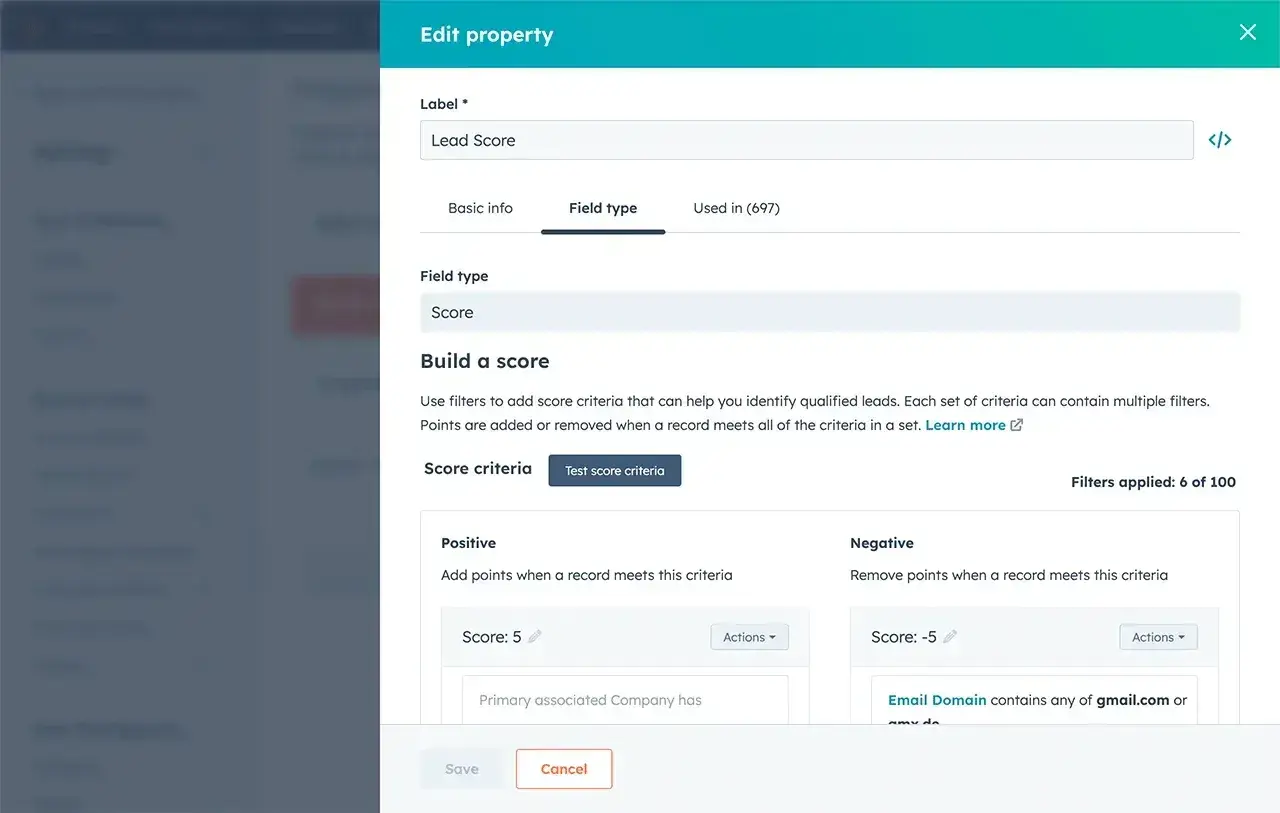

![Download Now: 10 Competitive Analysis Templates [Free Templates]](https://no-cache.hubspot.com/cta/default/53/b3ec18aa-f4b2-45e9-851f-6d359263e671.png)
-1.webp?width=550&height=422&name=Copy%20of%20Memo%20Templates%20(7)-1.webp)
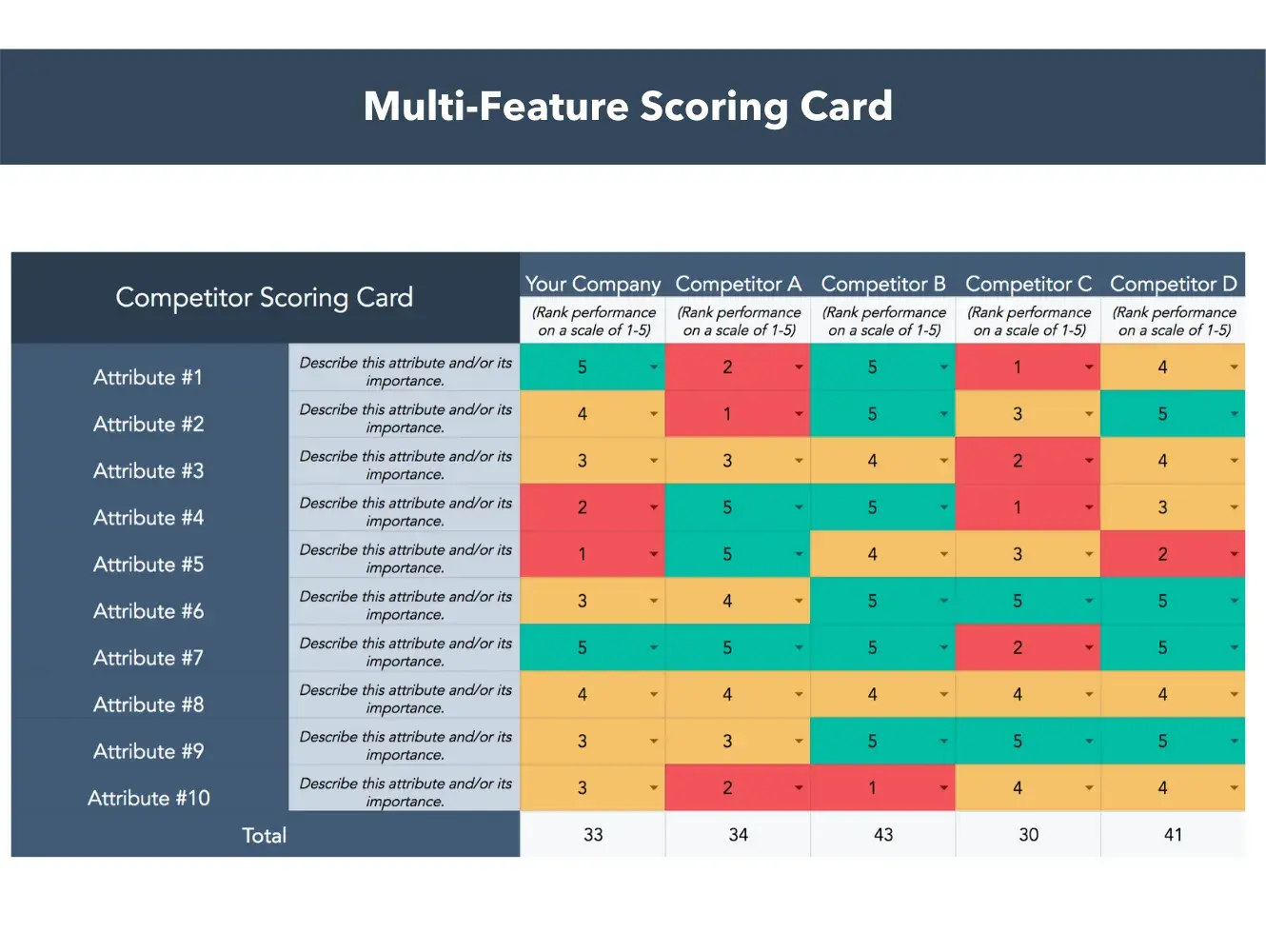



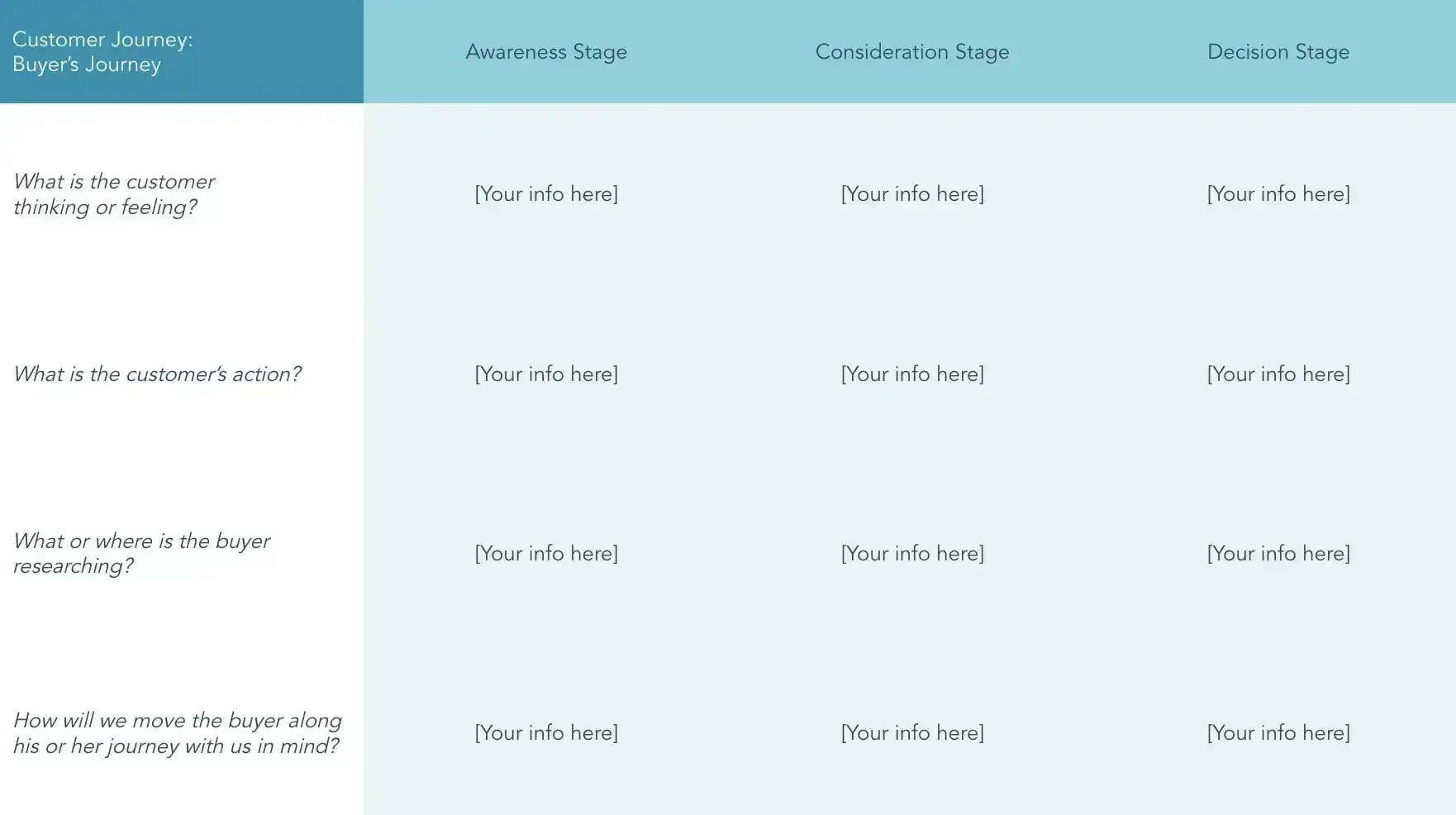
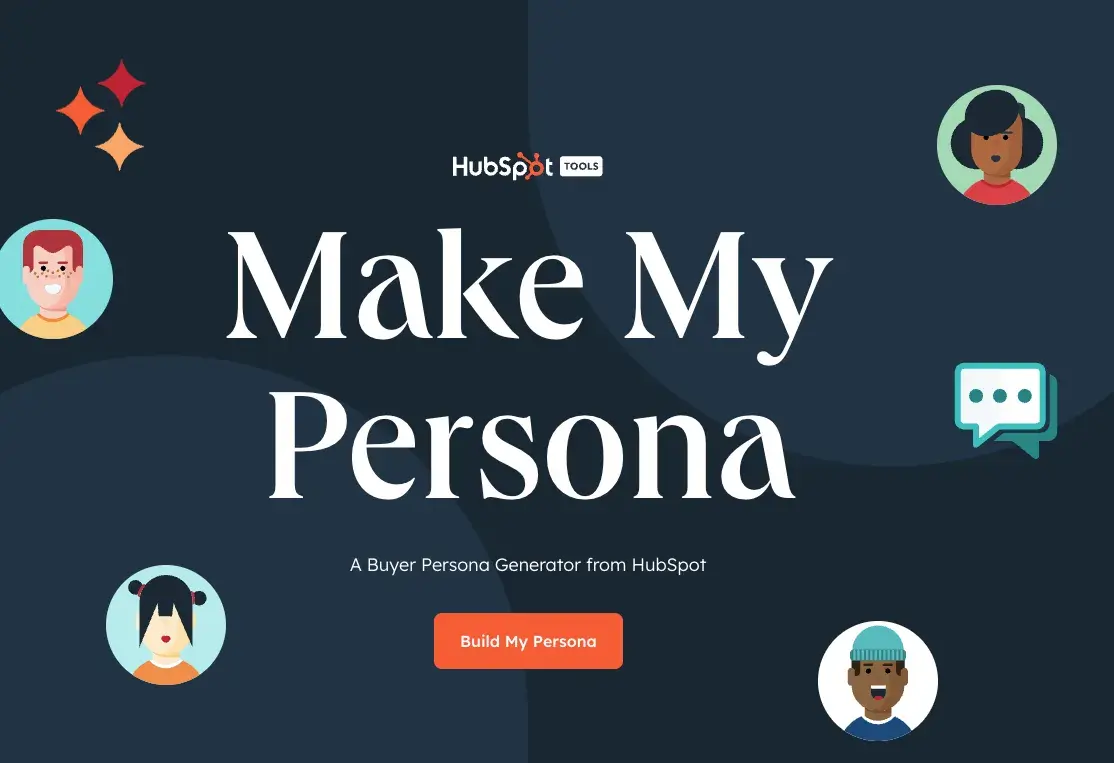








![Download Now: The Annual State of Artificial Intelligence in 2024 [Free Report]](https://no-cache.hubspot.com/cta/default/53/b72f2b25-8cc9-4642-9a1b-1e675d3d273b.png)

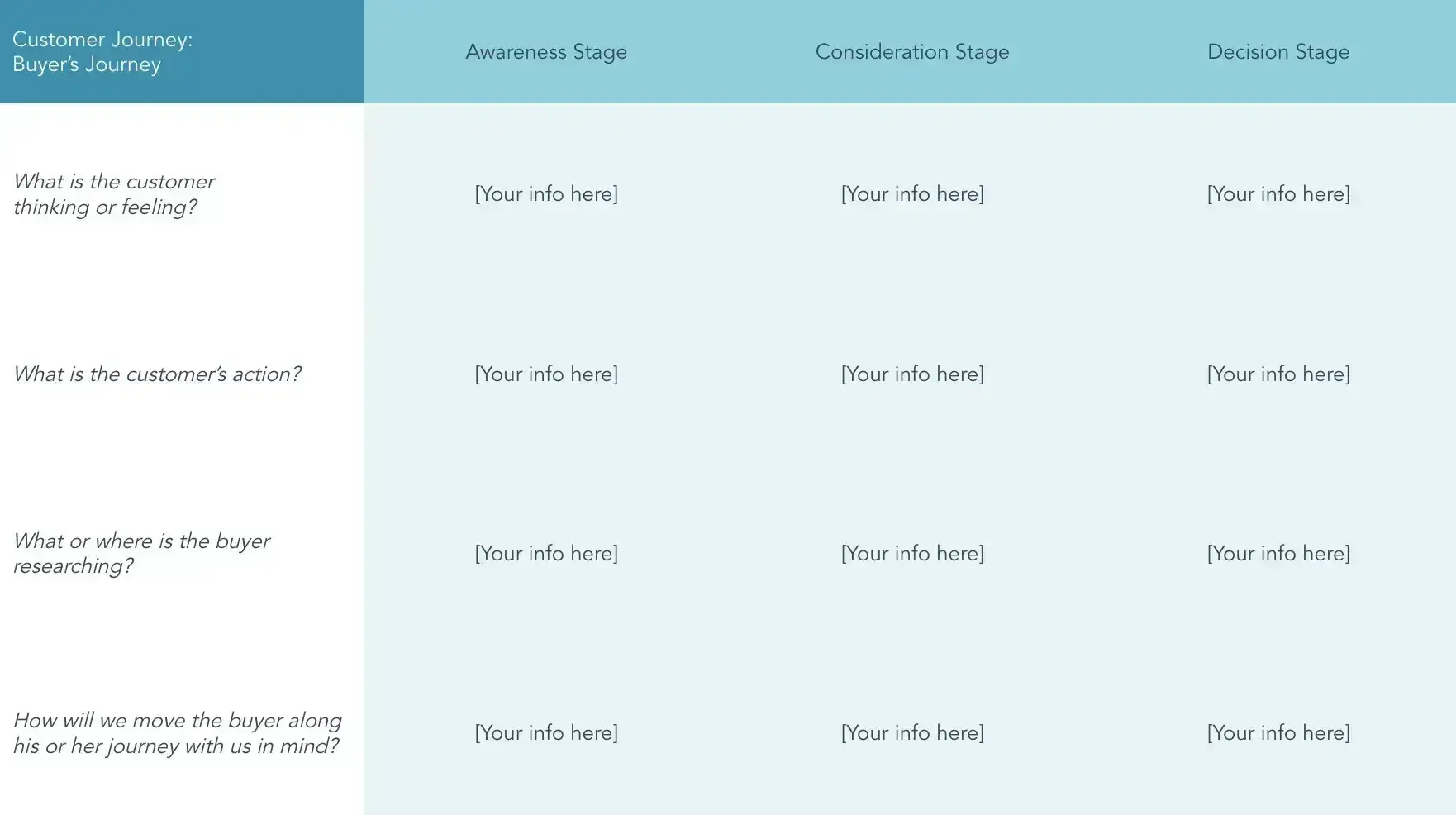



-6-20250411-4231377.webp?width=465&height=361&name=visual-content-creation-tools-(new)-6-20250411-4231377.webp)
-8-20250411-8710170.webp)
-9-20250411-1488652.webp)
-17-20250411-1215319.webp)